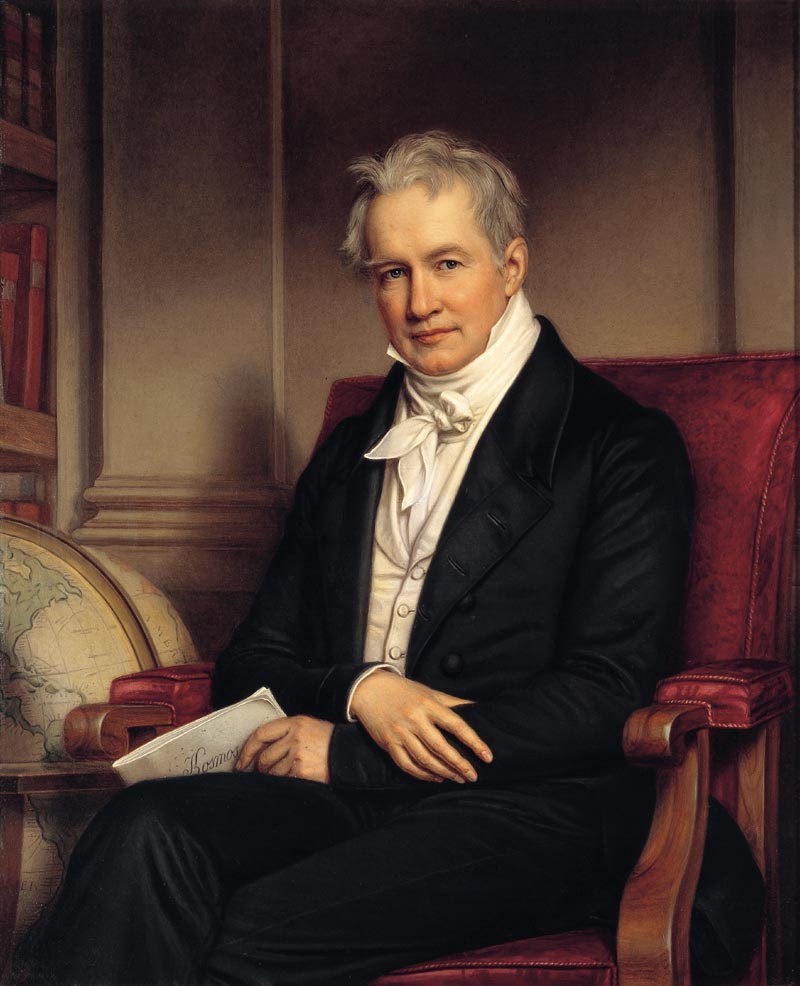
アレクサンダー・フォン・フンボルト
Friedrich Wilhelm
Heinrich Alexander von Humboldt, 1769-1859
sitting
next to a globe with a manuscript for his life's work "Cosmos" 1845-1862
☆
フリードリヒ・ヴィルヘルム・ハインリッヒ・アレクサンダー・フォン・フンボルト[a](1769年9月14日 -
1859年5月6日)は、ドイツの博学者、地理学者、自然学者、探検家、そしてロマン主義哲学と科学の提唱者であった[5]。彼は、プロイセンの大臣、哲
学者、言語学者であるヴィルヘルム・フォン・フンボルト(1767年 - 1835年)の弟であった。[6][7][8]
フンボルトの植物地理学に関する定量的研究は生物地理学の基礎を築き、長期にわたる体系的な地球物理学的測定の提唱は、現代の地磁気および気象観測の先駆
けとなった。[9][10]
フンボルトとカール・リッターは、地理学を独立した科学分野として確立したことから、現代地理学の創始者と見なされている。[11] [12]
1799年から1804年にかけて、フンボルトはアメリカ大陸を広く旅し、スペイン以外のヨーロッパ人科学者の視点から初めてこの地を探検し記述した。こ
の旅では、フランスの探検家エメ・ボンプランと共に、地球上で最も困難で知られていない地域を数千マイルにわたり横断した。オリノコ川の源流を特定し、
1802年にはエクアドル最高峰の標高19,286フィート(当時西洋人による世界最高到達記録)の山に登頂したのである。[13]
この旅の記録は21年をかけて数巻にまとめられ出版された。
フンボルトは古代ギリシャ語の「コスモス」という語を復活させ、自身の多巻にわたる大著『コスモス』に冠した。この著作で彼は科学知識と文化の多様な分野
を統合しようとしたのである。この重要な著作はまた、宇宙を相互作用する単一の実体として捉える全体論的認識を促し[14]、環境保護思想へとつながる生
態学の概念を導入した。1800年、そして1831年にも、彼は旅行中に得た観察結果に基づき、開発がもたらす局地的な影響が人為的な気候変動を引き起こ
すことを科学的に記述した[15][16][17]。
フンボルトは「生態学の父」および「環境保護思想の父」と見なされている[18][19]。
| Friedrich Wilhelm
Heinrich Alexander von Humboldt[a] (14 September 1769 – 6 May 1859) was
a German polymath, geographer, naturalist, explorer, and proponent of
Romantic philosophy and science.[5] He was the younger brother of the
Prussian minister, philosopher, and linguist Wilhelm von Humboldt
(1767–1835).[6][7][8] Humboldt's quantitative work on botanical
geography laid the foundation for the field of biogeography, while his
advocacy of long-term systematic geophysical measurement pioneered
modern geomagnetic and meteorological monitoring.[9][10] Humboldt and
Carl Ritter are both regarded as the founders of modern geography as
they established it as an independent scientific discipline.[11][12] Between 1799 and 1804, Humboldt travelled extensively in the Americas, exploring and describing them for the first time from a non-Spanish European scientific point of view. On these travels, along with French explorer Aimé Bonpland, he traversed thousands of miles through some of the most difficult and little-known places on Earth, to include identifying the source of the Orinoco River and in 1802 climbing the highest mountain in Ecuador to a height of 19,286 feet, at the time a world record altitude for a Westerner.[13] His description of the journey was written up and published in several volumes over 21 years. Humboldt resurrected the use of the word cosmos from the ancient Greek and assigned it to his multivolume treatise, Kosmos, in which he sought to unify diverse branches of scientific knowledge and culture. This important work also motivated a holistic perception of the universe as one interacting entity,[14] which introduced concepts of ecology leading to ideas of environmentalism. In 1800, and again in 1831, he described scientifically, on the basis of observations generated during his travels, local impacts of development causing human-induced climate change.[15][16][17] Humboldt is seen as "the father of ecology" and "the father of environmentalism".[18][19] |
フリードリヒ・ヴィルヘルム・ハインリッヒ・アレクサンダー・フォン・
フンボルト[a](1769年9月14日 -
1859年5月6日)は、ドイツの博学者、地理学者、自然学者、探検家、そしてロマン主義哲学と科学の提唱者であった[5]。彼は、プロイセンの大臣、哲
学者、言語学者であるヴィルヘルム・フォン・フンボルト(1767年 - 1835年)の弟であった。[6][7][8]
フンボルトの植物地理学に関する定量的研究は生物地理学の基礎を築き、長期にわたる体系的な地球物理学的測定の提唱は、現代の地磁気および気象観測の先駆
けとなった。[9][10]
フンボルトとカール・リッターは、地理学を独立した科学分野として確立したことから、現代地理学の創始者と見なされている。[11] [12] 1799年から1804年にかけて、フンボルトはアメリカ大陸を広く旅し、スペイン以外のヨーロッパ人科学者の視点から初めてこの地を探検し記述した。こ の旅では、フランスの探検家エメ・ボンプランと共に、地球上で最も困難で知られていない地域を数千マイルにわたり横断した。オリノコ川の源流を特定し、 1802年にはエクアドル最高峰の標高19,286フィート(当時西洋人による世界最高到達記録)の山に登頂したのである。[13] この旅の記録は21年をかけて数巻にまとめられ出版された。 フンボルトは古代ギリシャ語の「コスモス」という語を復活させ、自身の多巻にわたる大著『コスモス』に冠した。この著作で彼は科学知識と文化の多様な分野 を統合しようとしたのである。この重要な著作はまた、宇宙を相互作用する単一の実体として捉える全体論的認識を促し[14]、環境保護思想へとつながる生 態学の概念を導入した。1800年、そして1831年にも、彼は旅行中に得た観察結果に基づき、開発がもたらす局地的な影響が人為的な気候変動を引き起こ すことを科学的に記述した[15][16][17]。 フンボルトは「生態学の父」および「環境保護思想の父」と見なされている[18][19]。 |
| Early life, family and education Alexander von Humboldt was born in Berlin in Prussia on 14 September 1769.[20] He was baptized as a baby in the Lutheran faith, with the Duke of Brunswick-Wolfenbüttel serving as godfather.[21] His father, Alexander Georg von Humboldt (1720-1779), belonged to a prominent German noble family from Pomerania. Although not one of the titled gentry, he was a major in the Prussian Army, who had served with the Duke of Brunswick.[22] At age 42, Alexander Georg was rewarded for his services in the Seven Years' War with the post of royal chamberlain.[23] He profited from the contract to lease state lotteries and tobacco sales.[24] Alexander's grandfather was Johann Paul von Humboldt (1684-1740), who married Sophia Dorothea von Schweder (1688-1749), daughter of Prussian General Adjutant Michael von Schweder (1663-1729).[20][25] In 1766, his father, Alexander Georg married Maria Elisabeth Colomb, a well-educated woman and widow of Baron Friedrich Ernst von Holwede (1723-1765), with whom she had a son Heinrich Friedrich Ludwig (1762-1817). Alexander Georg and Maria Elisabeth had four children: two daughters, Karoline and Gabriele, who died young, and then two sons, Wilhelm and Alexander. Her first-born son, Wilhelm and Alexander's half-brother, Rittmaster in the Gendarme regiment was something of a ne'er-do-well, not often mentioned in the family history.[26] Alexander Georg died in 1779, leaving the brothers Humboldt in the care of their emotionally distant mother. She had high ambitions for Alexander and his older brother Wilhelm, hiring excellent tutors, who were Enlightenment thinkers, including Kantian physician Marcus Herz and botanist Carl Ludwig Willdenow, who became one of the most important botanists in Germany.[27] Humboldt's mother expected them to become civil servants of the Prussian state.[28] The money left to Alexander's mother by Baron Holwede became instrumental in funding Alexander's explorations after her death; contributing more than 70% of his private income. 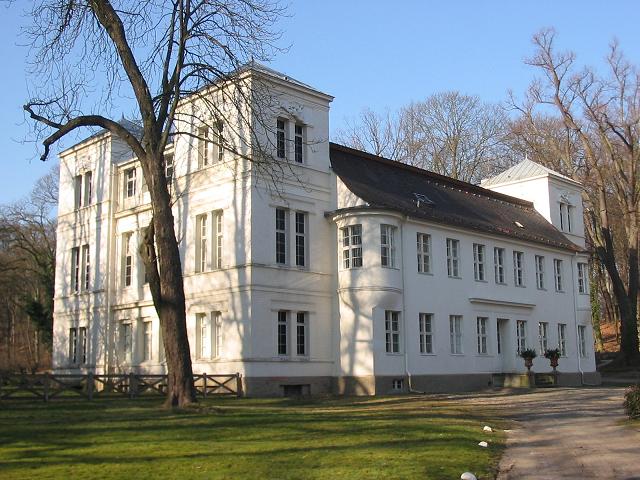 Schloss Tegel, Berlin, where Alexander and his brother Wilhelm lived for several years Due to his youthful penchant for collecting and labeling plants, shells, and insects, Alexander received the playful title of "the little apothecary".[23] Marked for a political career, Alexander studied finance for six months in 1787 at the University of Frankfurt (Oder), which his mother might have chosen less for its academic excellence than its closeness to their home in Berlin.[29] On 25 April 1789, he matriculated at the University of Göttingen, then known for the lectures of C. G. Heyne and anatomist J. F. Blumenbach.[27] His brother Wilhelm was already a student at Göttingen, but they did not interact much, since their intellectual interests were quite different.[30] His vast and varied interests were by this time fully developed.[23] At the University of Göttingen, Humboldt met Steven Jan van Geuns, a Dutch medical student, with whom he travelled to the Rhine in the fall of 1789. In Mainz, they met Georg Forster, a naturalist who had been with Captain James Cook on his second voyage.[31] Humboldt's scientific excursion resulted in his 1790 treatise Mineralogische Beobachtungen über einige Basalte am Rhein (Brunswick, 1790) (Mineralogic Observations on Several Basalts on the River Rhine).[32] The following year, 1790, Humboldt returned to Mainz to embark with Forster on a journey to England, Humboldt's first sea voyage, the Netherlands, and France.[30][33] In England, he met Sir Joseph Banks, president of the Royal Society, who had travelled with Captain Cook; Banks showed Humboldt his huge herbarium, with specimens of the South Sea tropics.[33] The scientific friendship between Banks and Humboldt lasted until Banks's death in 1820, and the two shared botanical specimens for study. Banks also mobilized his scientific contacts in later years to aid Humboldt's work.[34] In Paris, Humboldt and Forster witnessed the preparations for the Festival of the Federation. Yet, Humboldt's take on the French Revolution remained ambivalent.[35][page needed] Humboldt's passion for travel was of long standing. He devoted to prepare himself as a scientific explorer. With this emphasis, he studied commerce and foreign languages at Hamburg, geology at Freiberg School of Mines in 1791 under A.G. Werner, leader of the Neptunist school of geology;[36] from anatomy at Jena under J.C. Loder; and astronomy and the use of scientific instruments under F.X. von Zach and J.G. Köhler.[23] At Freiberg, he met a number of men who were to prove important to him in his later career, including Spaniard Manuel del Río, who became director of the School of Mines the crown established in Mexico; Christian Leopold von Buch, who became a regional geologist; and, most importantly, Carl Freiesleben [de], who became Humboldt's tutor and close friend. During this period, his brother Wilhelm married, but Alexander did not attend the nuptials.[37] |
幼少期、家族、教育 アレクサンダー・フォン・フンボルトは、1769年9月14日にプロイセンのベルリンで生まれた[20]。彼は赤ん坊の頃にルーテル教徒として洗礼を受け、ブラウンシュヴァイク=ヴォルフェンビュッテル公が名付け親となった。[21] 彼の父、アレクサンダー・ゲオルク・フォン・フンボルト(1720-1779)は、ポメラニア出身の著名なドイツ貴族の家系に属していた。貴族の称号は 持っていなかったが、プロイセン陸軍の大佐であり、ブラウンシュヴァイク公に仕えていた。[22] 42歳のとき、アレクサンダー・ゲオルクは七年戦争での功績により、王室侍従長の職を授かった。[23] 彼は、国営宝くじとタバコ販売のリース契約から利益を得ていた。[24] アレクサンダーの祖父は、ヨハン・パウル・フォン・フンボルト(1684-1740)であり、プロイセンの副官ミヒャエル・フォン・シュヴェーダー (1663-1729)の娘、ソフィア・ドロテア・フォン・シュヴェーダー(1688-1749)と結婚した。[20][25] 1766年、彼の父であるアレクサンダー・ゲオルクは、教養のある女性であり、フリードリヒ・エルンスト・フォン・ホルヴェーデ男爵(1723- 1765)の未亡人であるマリア・エリザベート・コロンと結婚した。彼女には、フリードリヒ・エルンスト・フォン・ホルヴェーデ男爵との間に、息子ハイン リッヒ・フリードリヒ・ルートヴィヒ(1762-1817)がいた。アレクサンダー・ゲオルクとマリア・エリザベートには4人の子供があった。2人の娘、 カロラインとガブリエレは若くして亡くなり、2人の息子、ヴィルヘルムとアレクサンダーがいた。長男であるヴィルヘルムは、アレクサンダーの異母兄弟であ り、憲兵連隊の騎兵隊長だったが、あまり家系図には登場しない、あまり良くない人物だった。[26] アレクサンダー・ゲオルクは1779年に亡くなり、フンボルト兄弟は感情的に距離のある母親の世話に委ねられた。母親はアレクサンダーと兄のヴィルヘルム に高い野望を抱き、優れた家庭教師を雇った。その中には、カントの弟子である医師マルクス・ヘルツや、ドイツで最も重要な植物学者の一人となった植物学者 カール・ルートヴィヒ・ヴィルデノーなど、啓蒙思想家も含まれていた。フンボルトの母親は、彼らがプロイセン王国の公務員になることを期待していた。 [28] ホルヴェーデ男爵がアレクサンダーの母親に遺した財産は、彼女の死後、アレクサンダーの探検資金として重要な役割を果たし、彼の私的収入の 70% 以上を占めた。  アレクサンダーと弟のヴィルヘルムが数年間住んだ、ベルリンのテーゲル城 植物、貝殻、昆虫を収集し、分類することを好んだ少年時代の傾向から、アレクサンダーは「小さな薬剤師」という遊び心のある称号を授けられた。[23] 政治の道を志したアレクサンダーは、1787年にフランクフルト(オーデル)大学で6か月間金融学を学んだ。母親が同大学を選んだのは、その学術的な優秀 さよりも、ベルリンの自宅から近いという理由からだったかもしれない。[29] 1789年4月25日、彼はゲッティンゲン大学に入学した。当時、同大学はC. G. ハイネと解剖学者J. F. ブルメンバッハの講義で知られていた。[27] 兄のヴィルヘルムはすでにゲッティンゲン大学の学生だったが、2人の知的関心はまったく異なっていたため、あまり交流はなかった。[30] この頃までに、彼の広範かつ多様な関心が完全に発達していた。[23] ゲッティンゲン大学で、フンボルトはオランダ人医学生スティーブン・ヤン・ファン・ゲウンズと出会い、1789年の秋に彼と一緒にライン川へ旅をした。マ インツでは、ジェームズ・クック船長の第二航海に同行した自然学者ゲオルク・フォースターと出会った。[31] フンボルトのこの科学探検は、1790年の論文『ライン川沿いのいくつかの玄武岩に関する鉱物学的観察』(Mineralogische Beobachtungen über einige Basalte am Rhein、ブラウンシュヴァイク、1790年)として結実した。翌1790年、フンボルトはマインツに戻り、フォースターと共にイギリス、オランダ、フ ランスへの旅に出発した。これがフンボルト初の航海であった[30][33]。イギリスでは王立協会会長でクック船長と共に航海したジョセフ・バンクス卿 と会い、バンクスはフンボルトに南洋熱帯地域の標本を含む膨大な植物標本集を見せた[33]。バンクスとフンボルトの科学的友情は、バンクスが1820年 に亡くなるまで続き、二人は研究のために植物標本を交換した。バンクスは後年、自身の科学的ネットワークを動員してフンボルトの研究を支援した。[34] パリでは、フンボルトとフォースターは連邦祭の準備を目撃した。しかし、フンボルトのフランス革命に対する見解は依然として複雑なものだった。[35] [ページ番号が必要] フンボルトの旅行への情熱は古くからあった。彼は科学探検家としての準備に専念した。この重点を置いて、ハンブルクで商業と外国語を学び、1791年には フライベルク鉱山学校でA.G.ヴェルナー(ネプチューニスト地質学派の指導者)に師事して地質学を修めた[36]。またイエナではJ.C.ローダーに解 剖学を、F.X.フォン・ザックとJ.G.ケーラーには天文学と科学機器の使用法を学んだ。[23] フライベルクでは、後に彼のキャリアにおいて重要な役割を果たすことになる多くの人々に出会った。その中には、メキシコに設立された王立鉱山学校の校長と なったスペイン人のマヌエル・デル・リオ、地域地質学者となったクリスチャン・レオポルド・フォン・ブーフ、そして最も重要な人物である、フンボルトの家 庭教師であり親友となったカール・フライエスレーベン [de] がいた。この期間、兄のヴィルヘルムは結婚したが、アレクサンダーは結婚式に出席しなかった。 |
| Travels and work in Europe Humboldt graduated from the Freiberg School of Mines in 1792 and was appointed to a Prussian government position in the Department of Mines as an inspector in Bayreuth and the Fichtel Mountains. Humboldt was excellent at his job, with production of gold ore in his first year outstripping the previous eight years.[38] During his period as a mine inspector, Humboldt demonstrated his deep concern for the men laboring in the mines. He opened a free school for miners, paid for out of his own pocket, which became an unchartered government training school for labor. He also sought to establish an emergency relief fund for miners, aiding them following accidents.[39] Humboldt's researches into the vegetation of the mines of Freiberg led to the publication in Latin (1793) of his Florae Fribergensis, accedunt Aphorismi ex Doctrina, Physiologiae Chemicae Plantarum, which was a compendium of his botanical researches.[36] That publication brought him to the attention of Johann Wolfgang von Goethe, who had met Humboldt at the family home when Alexander was a boy, but Goethe was now interested in meeting the young scientist to discuss metamorphism of plants.[40] An introduction was arranged by Humboldt's brother, who lived in the university town of Jena, not far from Goethe. Goethe had developed his own extensive theories on comparative anatomy. Working before Darwin, he believed that animals had an internal force, an urform, that gave them a basic shape and then they were further adapted to their environment by an external force. Humboldt urged him to publish his theories. Together, the two discussed and expanded these ideas. Goethe and Humboldt soon became close friends. Humboldt often returned to Jena in the years that followed. Goethe remarked about Humboldt to friends that he had never met anyone so versatile. Humboldt's drive served as an inspiration for Goethe. In 1797, Humboldt returned to Jena for three months. During this time, Goethe moved from his residence in Weimar to reside in Jena. Together, Humboldt and Goethe attended university lectures on anatomy and conducted their own experiments. One experiment involved hooking up a frog leg to various metals. They found no effect until the moisture of Humboldt's breath triggered a reaction that caused the frog leg to leap off the table. Humboldt described this as one of his favorite experiments because it was as if he were "breathing life into" the leg.[41] During this visit, a thunderstorm killed a farmer and his wife. Humboldt obtained their corpses and analyzed them in the anatomy tower of the university.[42] 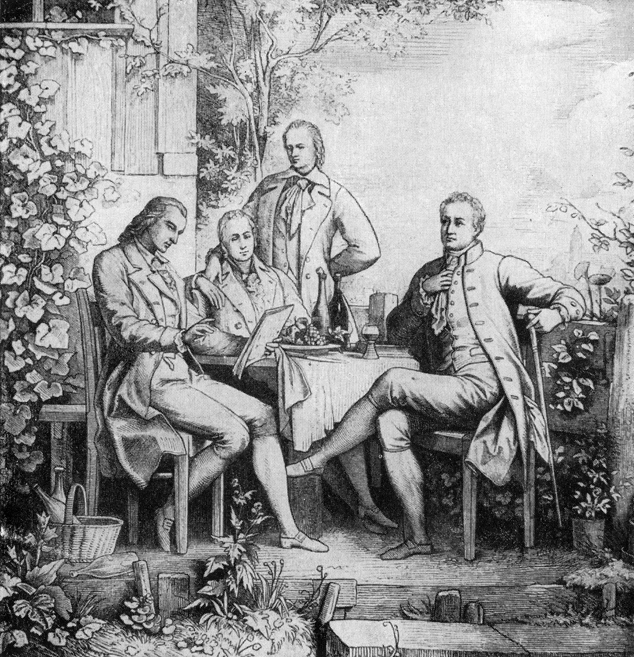 Schiller, Wilhelm, and Alexander von Humboldt with Goethe in Jena In 1794, Humboldt was admitted to the famous group of intellectuals and cultural leaders of Weimar Classicism. Goethe and Schiller were the key figures at the time. Humboldt contributed (7 June 1795) to Schiller's new periodical, Die Horen, a philosophical allegory entitled Die Lebenskraft, oder der rhodische Genius (The Life Force, or the Rhodian Genius).[23] In this short piece, the only literary story Humboldt ever authored, he tried to summarize the often contradictory results of the thousands of Galvanic experiments he had undertaken.[43] In 1792 and 1797, Humboldt was in Vienna; in 1795 he made a geological and botanical tour through Switzerland and Italy. Although this service to the state was regarded by him as only an apprenticeship to the service of science, he fulfilled its duties with such conspicuous ability that not only did he rise rapidly to the highest post in his department, but he was also entrusted with several important diplomatic missions.[23] Neither brother attended the funeral of their mother on 19 November 1796.[44] Humboldt had not hidden his aversion to his mother, with one correspondent writing of him after her death, "her death... must be particularly welcomed by you".[45] After severing his official connections, he awaited an opportunity to fulfill his long-cherished dream of travel. Humboldt was able to spend more time on writing up his research. He had used his own body for experimentation on muscular irritability, recently discovered by Luigi Galvani and published his results, Versuche über die gereizte Muskel- und Nervenfaser (Berlin, 1797) (Experiments on Stimulated Muscle and Nerve Fibres), enriched in the French translation with notes by Blumenbach. |
ヨーロッパでの旅と仕事 フンボルトは1792年にフライベルク鉱山学校を卒業し、プロイセン政府の鉱山局に配属された。バイロイトとフィヒテル山地を管轄する鉱山監督官として任 じられたのだ。フンボルトはその職務に非常に優れており、就任初年度の金鉱石の生産量は過去8年間の総量を上回った。[38] 鉱山監察官として勤務する間、フンボルトは鉱山で働く労働者たちへの深い関心を示した。自費で鉱夫のための無料学校を開設し、これは政府認可のない労働者 訓練校となった。また鉱夫のための緊急救済基金の設立を模索し、事故後の支援を図った。[39] フンボルトはフライベルク鉱山の植生を研究し、その成果を『Florae Fribergensis, accedunt Aphorismi ex Doctrina, Physiologiae Chemicae Plantarum』としてラテン語で出版した(1793年)。これは彼の植物学研究の要約であった。[36] この出版により、彼はヨハン・ヴォルフガング・フォン・ゲーテの注目を浴びた。ゲーテは、アレクサンダーが少年だった頃、フンボルトの自宅で彼と面識が あったが、植物の変態について議論するために、この若い科学者に会いたいと興味を持っていた。[40] ゲーテの住んでいたイェーナ大学からほど近い、フンボルトの兄弟が紹介を手配した。ゲーテは、比較解剖学について独自の広範な理論を展開していた。ダー ウィンより前に、動物には基本的な形を与える内的な力、つまり原形があり、さらに外的な力によって環境に適応していくと信じていた。フンボルトはゲーテ に、その理論を出版するよう強く勧めた。二人は一緒にこれらの考えについて議論し、発展させた。ゲーテとフンボルトはすぐに親しい友人となった。 その後もフンボルトは度々イエナを訪れた。ゲーテは友人たちに「これほど多才な人物に会ったことがない」とフンボルトについて語った。フンボルトの情熱は ゲーテの刺激となった。1797年、フンボルトは3ヶ月間イエナに滞在した。この間、ゲーテはワイマールの自宅からイエナに移り住んだ。二人は共に大学の 解剖学講義に出席し、独自の実験を行った。ある実験では、カエルの脚をさまざまな金属に接続した。フンボルトの息の湿気が反応を引き起こし、カエルの脚が テーブルから飛び跳ねるまで、何の効果もなかった。フンボルトは、この実験を「脚に命を吹き込んだ」かのようだったため、お気に入りの実験のひとつだと述 べている。[41] この訪問中、雷雨で農夫とその妻が死亡した。フンボルトは彼らの遺体を入手し、大学の解剖学塔で分析を行った。[42]  イエナでゲーテとシュイラー、ヴィルヘルム、アレクサンダー・フォン・フンボルト 1794年、フンボルトはワイマール古典主義の有名な知識人・文化人グループに受け入れられた。当時、ゲーテとシラーが中心人物であった。フンボルトは、 シラーの新しい定期刊行物『ディ・ホーレン』に、哲学的寓話「生命力、あるいはロードス島の天才」を寄稿した(1795年6月7日)。この短い作品(フン ボルトがこれまでに書いた唯一の文学作品)の中で、彼は、これまでに行った何千ものガルバニック実験の、しばしば矛盾した結果をまとめようとしたのであ る。 1792年と1797年、フンボルトはウィーンに滞在した。1795年にはスイスとイタリアを地質学・植物学の調査旅行で巡った。この公務は彼にとって科 学への奉仕に向けた修業期間に過ぎなかったが、その職務を顕著な能力で遂行したため、部門の最高職位に急速に昇進しただけでなく、いくつかの重要な外交任 務も任された。[23] 1796年11月19日の母親の葬儀には、兄弟ともに出席しなかった。[44] フンボルトは母親への嫌悪を隠さなかったため、ある通信相手は彼女の死後「彼女の死は…特に君にとって歓迎すべきことだろう」と記している。[45] 公的な関係を断った後、彼は長年抱いていた旅行の夢を実現する機会を待った。 フンボルトは研究の記録作成により多くの時間を割けるようになった。彼はルイジ・ガルヴァーニが新たに発見した筋刺激性について、自らの身体を実験材料と して用い、その結果を『刺激された筋繊維と神経繊維に関する実験』(ベルリン、1797年)として発表した。この著作はブルメンバッハによる注釈を付した フランス語訳でさらに充実したものとなった。 |
Spanish American expedition, 1799–1804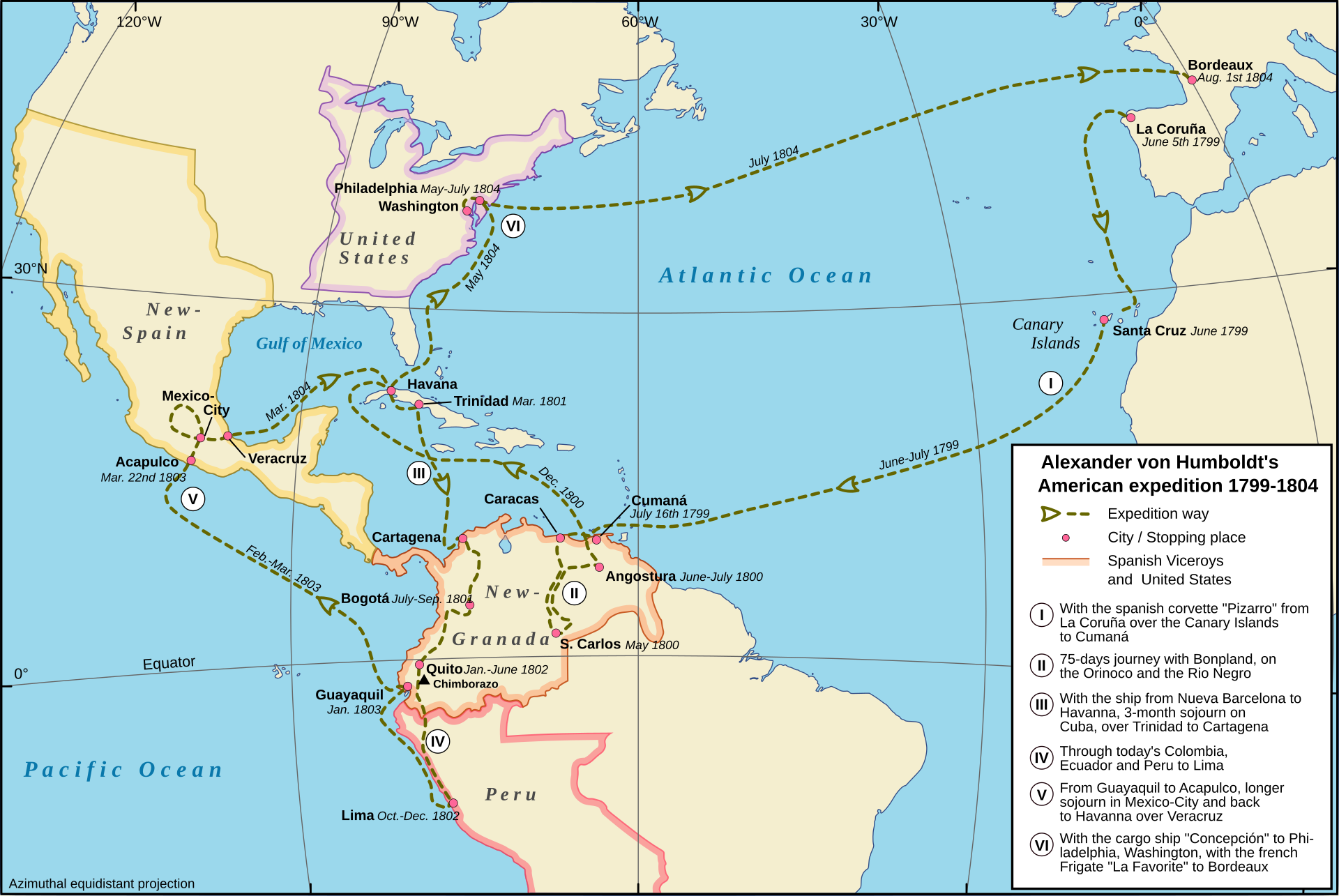 Alexander von Humboldt's Latin American expedition Seeking a foreign expedition With the financial resources to fund his scientific travels, he sought a ship on a major expedition. In the meantime, he went to Paris, where his brother Wilhelm was living. Paris was a great center of scientific learning and his brother and sister-in-law Caroline were well connected in those circles. Louis-Antoine de Bougainville urged Humboldt to accompany him on a major expedition, likely to last five years, but the French revolutionary Directoire placed Nicolas Baudin at the head of it rather than the aging scientific traveler.[46] On the postponement of Captain Baudin's proposed voyage of circumnavigation due to continuing warfare in Europe, which Humboldt had been officially invited to accompany, Humboldt was deeply disappointed. He had already selected scientific instruments for his voyage. He did, however, have a stroke of luck with meeting Aimé Bonpland, the botanist and physician for the voyage. Discouraged, the two left Paris for Marseille, where they hoped to join Napoleon Bonaparte in Egypt, but North Africans were in revolt against the French invasion in Egypt and French authorities refused permission to travel. Humboldt and Bonpland eventually found their way to Madrid, where their luck changed spectacularly.[47] |
スペイン領アメリカ遠征、1799年~1804年 アレクサンダー・フォン・フンボルトのラテンアメリカ遠征 海外遠征の機会を求める 科学的な旅の資金源を確保した彼は、大規模な遠征船を探した。その間、彼は兄ヴィルヘルムが住んでいたパリへ行った。パリは科学の学問の中心地であり、兄 と義姉のカロリーヌは、その界隈で幅広い人脈を持っていた。ルイ・アントワーヌ・ド・ブーゲンビルは、5年間続くと思われる大規模な探検にフンボルトを同 行させるよう促したが、フランス革命の指導部であるディレクトワールは、高齢の科学旅行者ではなく、ニコラ・ボードンをその指揮官に任命した。[46] ヨーロッパでの戦争が続いたため、フンボルトが正式に同行を招待されていたボードン船長の世界周航計画が延期されたことに、フンボルトは深く失望した。彼 は既に航海用の科学機器を選定していた。しかし、航海に同行する植物学者兼医師であるエメ・ボンプランとの出会いは幸運だった。 落胆した二人はパリを離れマルセイユへ向かった。ナポレオン・ボナパルトが率いるエジプト遠征軍に合流するつもりだったが、北アフリカではフランス軍のエ ジプト侵攻に反乱が起きており、フランス当局は渡航を許可しなかった。フンボルトとボンプランは結局マドリードへ辿り着き、そこで彼らの運は劇的に好転し た。[47] |
Spanish royal authorization, 1799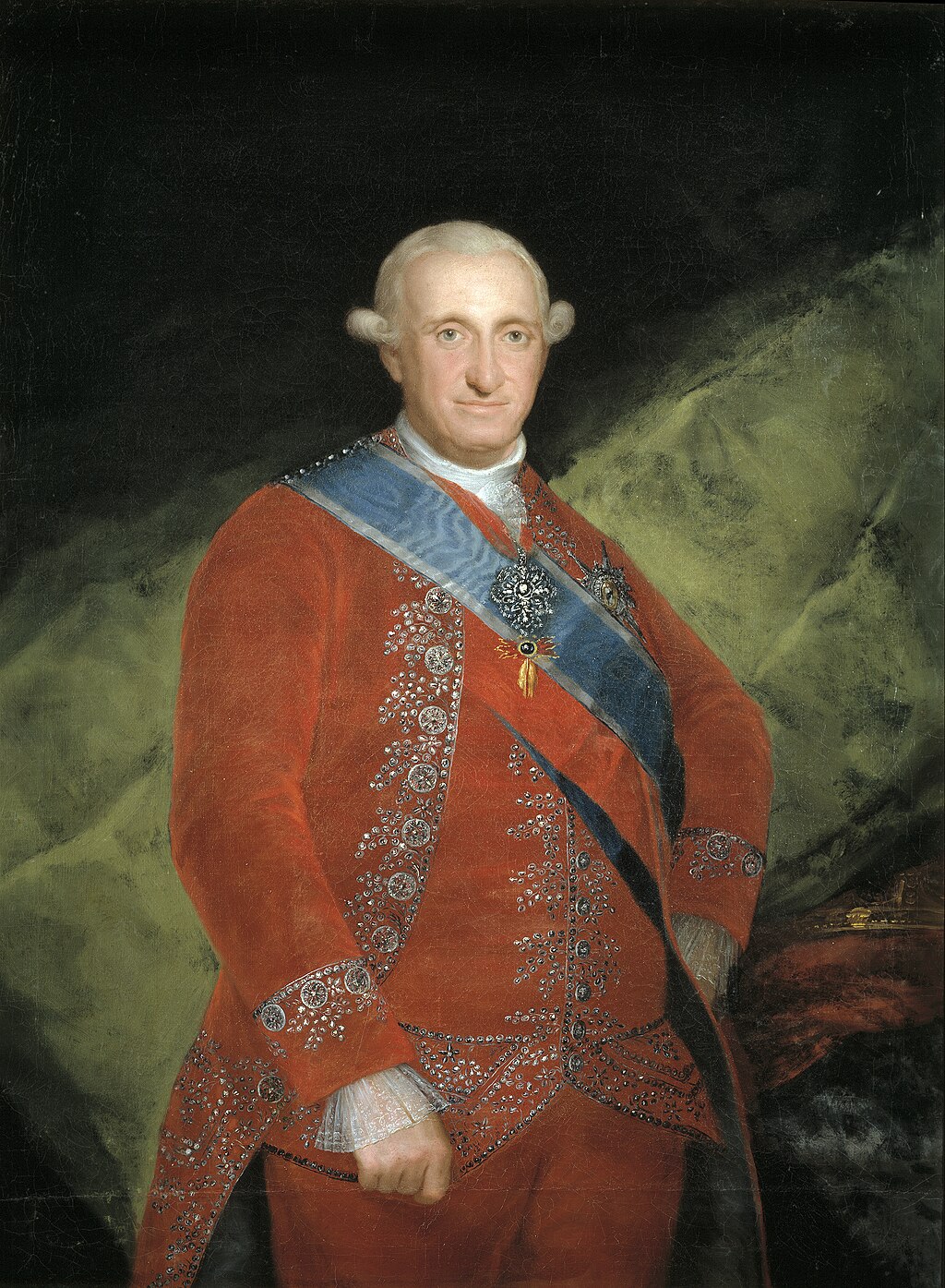 Charles IV of Spain who authorized Humboldt's travels and research in Spanish America In Madrid, Humboldt sought authorization to travel to Spain's realms in the Americas; he was aided in obtaining it by the German representative of Saxony at the royal Bourbon court. Baron Forell had an interest in mineralogy and science endeavors and was inclined to help Humboldt.[47] At that time, the Bourbon Reforms sought to reform administration of the realms and revitalize their economies.[48] At the same time, the Spanish Enlightenment was in florescence. For Humboldt "the confluent effect of the Bourbon revolution in government and the Spanish Enlightenment had created ideal conditions for his venture".[49] The Bourbon monarchy had already authorized and funded expeditions, with the Botanical Expedition to the Viceroyalty of Peru to Chile and Peru (1777–88), New Granada (1783–1816), New Spain (Mexico) (1787–1803), and the Malaspina Expedition (1789–94). These were lengthy, state-sponsored enterprises to gather information about plants and animals from the Spanish realms, assess economic possibilities, and provide plants and seeds for the Royal Botanical Garden in Madrid (founded 1755).[50] These expeditions took naturalists and artists, who created visual images as well as careful written observations as well as collecting seeds and plants themselves.[51] Crown officials as early as 1779 issued and systematically distributed Instructions concerning the most secure and economic means to transport live plants by land and sea from the most distant countries, with illustrations, including one for the crates to transport seeds and plants.[52] When Humboldt requested authorization from the crown to travel to Spanish America, most importantly, with his own financing, it was given positive response. Spain under the Habsburg monarchy had guarded its realms against foreigner travelers and intruders. The Bourbon monarch was open to Humboldt's proposal. Spanish Foreign Minister Don Mariano Luis de Urquijo received the formal proposal and Humboldt was presented to the monarch in March 1799.[47] Humboldt was granted access to crown officials and written documentation on Spain's empire. With Humboldt's experience working for the absolutist Prussian monarchy as a government mining official, Humboldt had both the academic training and experience of working well within a bureaucratic structure.[49] 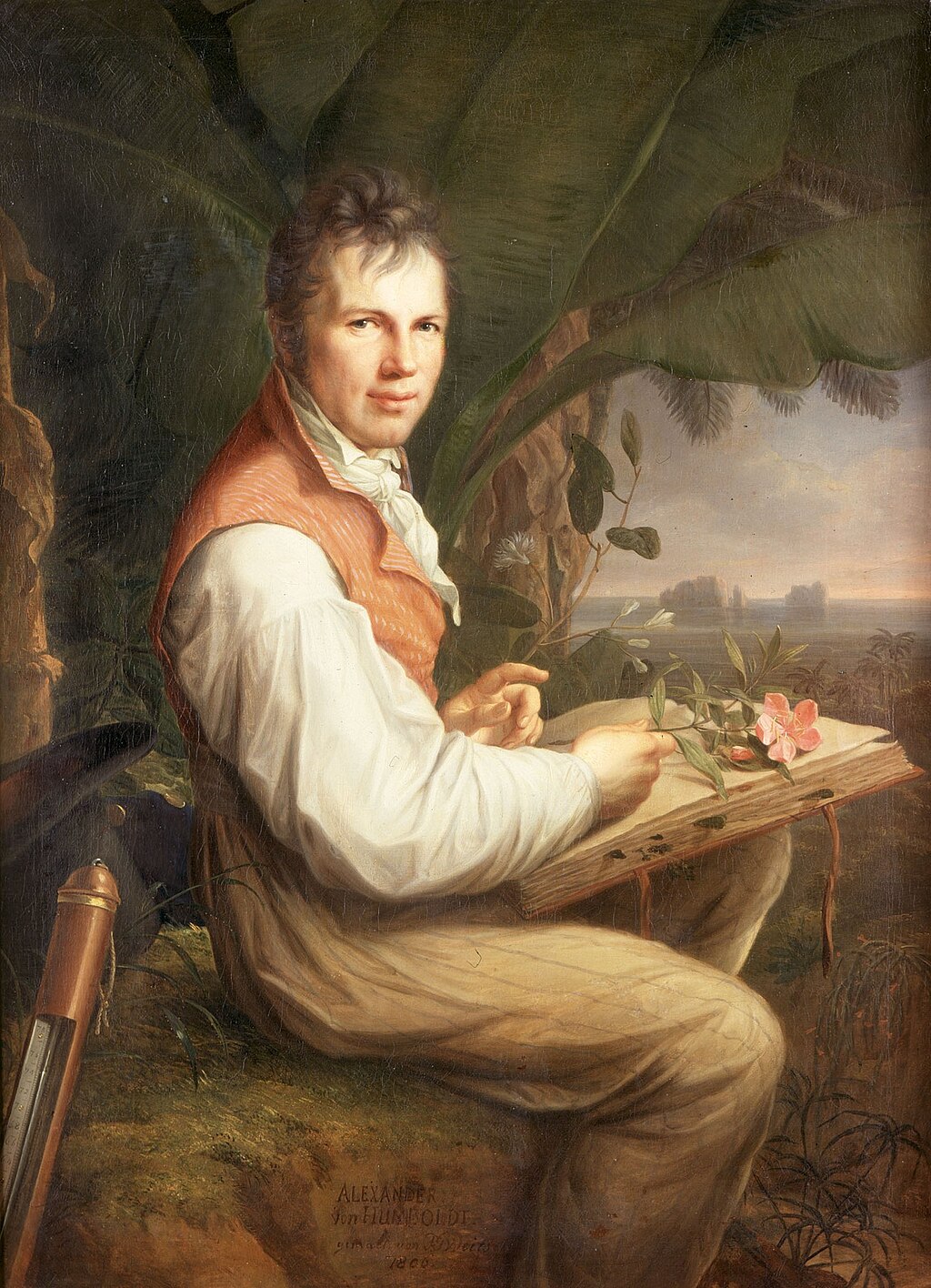 Portrait of Alexander von Humboldt by Friedrich Georg Weitsch, 1806 Before leaving Madrid in 1799, Humboldt and Bonpland visited the Natural History Museum, which held results of Martín Sessé y Lacasta and José Mariano Mociño's botanical expedition to New Spain.[53] Humboldt and Bonpland met Hipólito Ruiz López and José Antonio Pavón y Jiménez of the royal expedition to Peru and Chile in person in Madrid and examined their botanical collections.[54] |
スペイン王室認可書、1799年 スペイン王カルロス4世はフンボルトのスペイン領アメリカにおける旅行と研究を認可した マドリードでフンボルトはスペイン領アメリカ諸王国への旅行許可を求めた。ザクセン公国のドイツ代表が王室ブルボン宮廷でこれを支援した。フォーレル男爵 は鉱物学と科学事業に関心があり、フンボルトを助ける意向だった。[47] 当時、ブルボン改革は領土の行政改革と経済活性化を目指していた。[48] 同時にスペイン啓蒙主義は隆盛期にあった。フンボルトにとって「政府におけるブルボン革命とスペイン啓蒙主義の相乗効果が、彼の冒険に理想的な条件を生み 出した」のである。[49] ブルボン王朝は既に、ペルー副王領への植物調査遠征(1777-88年)、チリ・ペルー遠征、ヌエバ・グラナダ遠征(1783-1816年)、ヌエバ・エ スパーニャ(メキシコ)遠征(1787-1803年)、マラスピナ遠征(1789-94年)といった遠征を認可・資金提供していた。これらは長期にわたる 国家主導の事業であり、スペイン領内の動植物情報を収集し、経済的可能性を評価するとともに、マドリード王立植物園(1755年創設)へ植物や種子を供給 することを目的としていた。[50] これらの探検隊には自然学者や芸術家が同行し、種子や植物そのものを収集するだけでなく、視覚的記録や詳細な観察記録を作成した。[51] 1779年には既に王室当局が『最も遠隔の国々から陸路及び海路で生きた植物を輸送する最も安全かつ経済的な方法に関する指示書』を発行し、体系的に配布 していた。この指示書には図解が含まれており、種子や植物を輸送するための木箱の設計図も掲載されていた。[52] フンボルトがスペイン領アメリカへの渡航許可を王室に申請した際、特に自己資金による渡航という条件が提示されたが、これは肯定的に応じられた。ハプスブ ルク家の支配下にあったスペインは、外国人の旅行者や侵入者から領土を守ってきた。しかしブルボン家の君主はフンボルトの提案に門戸を開いた。スペイン外 相ド・マリアーノ・ルイス・デ・ウルキホが正式な提案書を受け取り、フンボルトは1799年3月に国王に謁見した。[47] フンボルトは、王室関係者に面会し、スペイン帝国に関する文書を入手することを許可された。フンボルトは、絶対主義的なプロイセン王室で鉱山官吏として働 いた経験があり、学術的な訓練と官僚機構の中でうまく働く経験の両方を持っていた。[49]  フリードリヒ・ゲオルク・ヴァイツによるアレクサンダー・フォン・フンボルトの肖像、1806年 1799年にマドリードを離れる前に、フンボルトとボンプランは、マルティン・セッセ・イ・ラカスタとホセ・マリアーノ・モシニョによる新スペインへの植 物調査の成果を所蔵する自然史博物館を訪れた。フンボルトとボンプランは、マドリードで、ペルーとチリへの王立探検隊のヒポリト・ルイス・ロペスとホセ・ アントニオ・パボン・イ・ヒメネスに直接会い、彼らの植物コレクションを調査した。 |
Venezuela, 1799–1800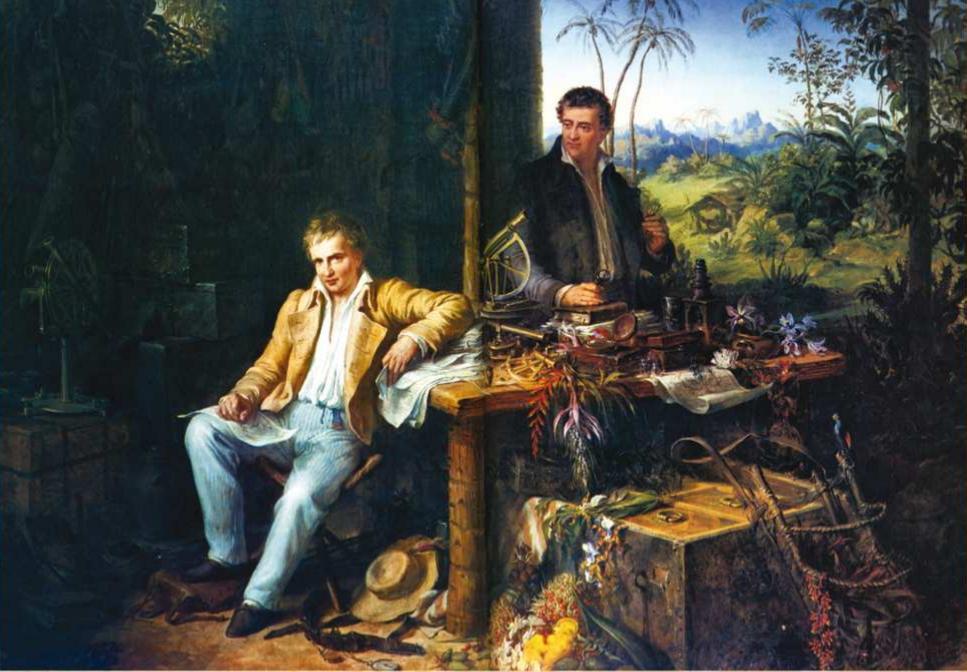 Humboldt and Aimé Bonpland were in the Amazon rainforest by the Casiquiare River, with their scientific instruments, which enabled them to take many types of accurate measurements throughout their five-year journey. Oil painting by Eduard Ender, 1856. Humboldt did not like the painting as the instruments depicted were inaccurate.[55] 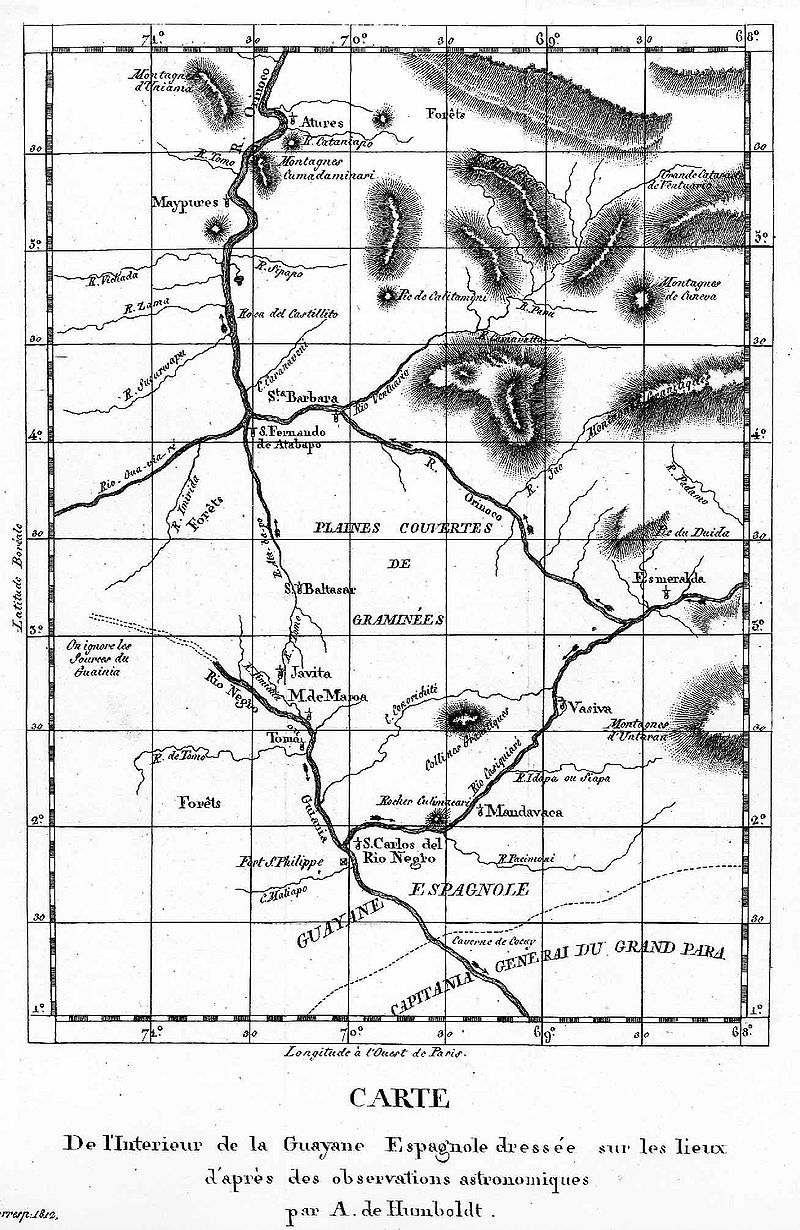 Map of the Casiquiare canal based on Humboldt's 1799 observations Armed with authorization from the King of Spain, Humboldt and Bonpland made haste to sail, taking the ship Pizarro from A Coruña, on 5 June 1799. The ship stopped six days on the island of Tenerife, where Humboldt climbed the volcano Teide, and then sailed on to the New World, landing at Cumaná, Venezuela, on 16 July. The ship's destination was not originally Cumaná, but an outbreak of typhoid on board meant that the captain changed course from Havana to land in northern South America. Humboldt had not mapped out a specific plan of exploration, so that the change did not upend a fixed itinerary. He later wrote that the diversion to Venezuela made possible his explorations along the Orinoco River to the border of Portuguese Brazil. With the diversion, the Pizarro encountered two large dugout canoes each carrying 18 Guayaqui Indians. The Pizarro's captain accepted the offer of one of them to serve as pilot. Humboldt hired this Indian, named Carlos del Pino, as a guide.[56] Venezuela from the 16th to the 18th centuries was a relative backwater compared to the seats of the Spanish viceroyalties based in New Spain (Mexico) and Peru, but during the Bourbon reforms, the northern portion of Spanish South America was reorganized administratively, with the 1777 establishment of a captaincy-general based at Caracas. A great deal of information on the new jurisdiction had already been compiled by François de Pons, but was not published until 1806.[49][57] Rather than describe the administrative center of Caracas, Humboldt started his researches with the valley of Aragua, where export crops of sugar, coffee, cacao, and cotton were cultivated. Cacao plantations were the most profitable, as world demand for chocolate rose.[58] It is here that Humboldt is said to have developed his idea of human-induced climate change. Investigating evidence of a rapid fall in the water level of the valley's Lake Valencia, Humboldt credited the desiccation to the clearance of tree cover and to the inability of the exposed soils to retain water. With their clear cutting of trees, the agriculturalists were removing the woodland's "threefold" moderating influence upon temperature: cooling shade, evaporation and radiation.[59] Humboldt visited the mission at Caripe and explored the Guácharo cavern, where he found the oilbird, which he was to make known to science as Steatornis caripensis. He also described the Guanoco asphalt lake as "The spring of the good priest" ("Quelle des guten Priesters").[60][61] Returning to Cumaná, Humboldt observed, on the night of 11–12 November, a remarkable meteor shower (the Leonids). He proceeded with Bonpland to Caracas where he climbed the Avila mount with the young poet Andrés Bello, the former tutor of Simón Bolívar, who later became the leader of independence in northern South America. Humboldt met the Venezuelan Bolívar himself in 1804 in Paris and spent time with him in Rome. The documentary record does not support the supposition that Humboldt inspired Bolívar to participate in the struggle for independence, but it does indicate Bolívar's admiration for Humboldt's production of new knowledge on Spanish America.[62] In February 1800, Humboldt and Bonpland left the coast with the purpose of exploring the course of the Orinoco River and its tributaries. This trip, which lasted four months and covered 1,725 miles (2,776 km) of wild and largely uninhabited country, had an aim of establishing the existence of the Casiquiare canal (a communication between the water systems of the rivers Orinoco and Amazon). Although, unbeknownst to Humboldt, this existence had been established decades before,[63] his expedition had the important results of determining the exact position of the bifurcation,[23] and documenting the life of several native tribes such as the Maipures and their extinct rivals the Atures (several words of the latter tribe were transferred to Humboldt by one parrot[64]). Around 19 March 1800, Humboldt and Bonpland discovered dangerous electric eels, whose shock could kill a man. To catch them, locals suggested they drive wild horses into the river, which brought the eels out from the river mud, and resulted in a violent confrontation of eels and horses, some of which died. Humboldt and Bonpland captured and dissected some eels, which retained their ability to shock; both received potentially dangerous electric shocks during their investigations. The encounter made Humboldt think more deeply about electricity and magnetism, typical of his ability to extrapolate from an observation to more general principles.[65] Humboldt returned to the incident in several of his later writings, including his travelogue Personal Narrative (1814–29), Views of Nature (1807), and Aspects of Nature (1849).[66] Two months later, they explored the territory of the Maipures and that of the then-recently extinct Atures Indians. Humboldt laid to rest the persistent myth of Walter Raleigh's Lake Parime by proposing that the seasonal flooding of the Rupununi savannah had been misidentified as a lake.[67] |
ベネズエラ、1799–1800年 フンボルトとエメ・ボンプランはカシキアレ川沿いのアマゾン熱帯雨林にいた。彼らは科学機器を携えており、5年間の旅を通じて様々な正確な測定を行うこと ができた。エドゥアルト・エンダーによる油絵、1856年。フンボルトはこの絵を好まなかった。描かれた機器が不正確だったからだ。[55]  フンボルトの1799年観測に基づくカシキアレ水路図 スペイン国王の許可を得たフンボルトとボンプランは、1799年6月5日にア・コルーニャからピサロ号で急ぎ出航した。船はテネリフェ島で6日間停泊し、フンボルトはテイデ火山に登頂した後、新大陸へ向けて航海を続け、7月16日にベネズエラのクマナに上陸した。 当初の目的地はクマナではなかったが、船内で発生した腸チフスにより、船長はハバナから南米北部に寄港するコースを変更した。フンボルトは具体的な探検計 画を立てていなかったため、この変更は固定された旅程を覆すものではなかった。彼は後に、ベネズエラへの迂回がオリノコ川沿いの探検を可能にし、ポルトガ ル領ブラジル国境まで到達できたと記している。この迂回航路で、ピサロ号は18人のグアヤキ族インディアンを乗せた大型丸木舟2隻と遭遇した。ピサロ号の 船長は、そのうちの1人が案内役として同行する申し出を受け入れた。フンボルトはこのインディアン、カルロス・デル・ピノをガイドとして雇った。[56] 16世紀から18世紀にかけてのベネズエラは、ニュー・エスパーニャ(メキシコ)やペルーに本拠を置くスペイン副王領の中心地と比べると、比較的辺境の地 であった。しかしブルボン改革期に、スペイン領南アメリカの北部は行政的に再編され、1777年にはカラカスを本拠とする総督府が設置された。この新管轄 区域に関する膨大な情報はフランソワ・ド・ポンズによって既にまとめられていたが、出版されたのは1806年になってからだった。[49][57] フンボルトは行政の中心地カラカスを記述する代わりに、砂糖、コーヒー、カカオ、綿花といった輸出作物が栽培されていたアラグア渓谷から研究を始めた。カ カオ農園は最も収益性が高く、世界的なチョコレート需要の高まりを受けていた[58]。フンボルトが人為的気候変動の概念をここで発展させたとされる。同 地にあるバレンシア湖の水位急落の証拠を調査したフンボルトは、樹木の伐採と露出した土壌の保水力不足が干上がりの原因だと結論づけた。農耕民による森林 の伐採は、気温を調節する森林の「三つの」影響、すなわち冷却効果のある日陰、蒸発、放射を排除していたのである。[59] フンボルトはカリペの宣教所を訪れ、グアチャロ洞窟を探検した。そこで彼はオイルバードを発見し、後に科学界にステアトルニス・カリペンシスとして知られ るようにした。またグアノコ瀝青湖を「善き司祭の泉」(Quelle des guten Priesters)と記述した[60][61]。クマナに戻ったフンボルトは11月11日から12日にかけての夜、驚くべき流星群(レオニッド流星群) を観測した。ボンプランと共にカラカスへ進み、アビラ山に登った。同行したのは若き詩人アンドレス・ベジョで、彼は後に南米北部の独立指導者となるシモ ン・ボリバルの家庭教師を務めていた。フンボルトは1804年にパリでベネズエラのボリバル本人と出会い、ローマで共に過ごした。記録によれば、フンボル トがボリバルに独立闘争への参加を促したという推測は裏付けられないが、ボリバルがフンボルトのスペイン領アメリカに関する新たな知見の創出を称賛してい たことは示されている。[62] 1800年2月、フンボルトとボンプランはオリノコ川とその支流の探検を目的に海岸を離れた。この旅は4か月間続き、1,725マイル(2,776キロ メートル)に及ぶ未開でほとんど無人地帯を横断し、カシキアレ水路(オリノコ川とアマゾン川の流域を結ぶ水路)の存在を確認することを目的としていた。フ ンボルトは知らなかったが、この存在は数十年前に既に確認されていた[63]。しかし彼の探検は、分岐点の正確な位置を特定した[23]こと、マイプレ族 やその滅んだ敵対部族アトゥレ族など複数の先住民の生活を記録した点で重要な成果をもたらした(後者の部族の言葉の数語は、フンボルトに1羽のオウムに よって伝えられた[64])。1800年3月19日頃、フンボルトとボンプランは危険な電気ウナギを発見した。その放電は人を殺すほどだった。捕獲のた め、現地人は野生の馬を川に追い込むよう提案した。これによりウナギが泥底から現れ、ウナギと馬の激しい衝突が発生し、馬数頭が死亡した。フンボルトとボ ンプランは数匹のウナギを捕獲し解剖したが、それらは依然として電気ショックを与える能力を保持していた。調査中、両者とも危険な電気ショックを受ける可 能性があった。この遭遇はフンボルトに電気と磁気について深く考えさせるきっかけとなった。これは彼の観察からより一般的な原理へと推論する能力の典型例 である[65]。フンボルトは後年の著作、旅行記『個人旅行記』(1814-29年)、『自然の景観』(1807年)、『自然の諸相』(1849年)など でこの出来事を繰り返し言及している。[66] 二か月後、彼らはマイプレ族と、当時すでに絶滅したアトゥレ族の領域を探検した。フンボルトは、ルプヌニサバンナの季節的な洪水が湖と誤認されていたと提唱することで、ウォルター・ローリーのパリメ湖に関する根強い伝説に終止符を打った。[67] |
Cuba, 1800, 1804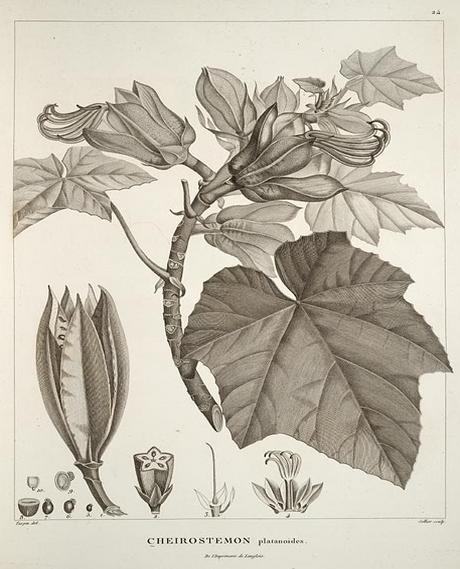 Humboldt botanical drawing published in his work on Cuba On 24 November 1800, the two friends set sail for Cuba, landing on 19 December,[68] where they met fellow botanist and plant collector John Fraser.[69] Fraser and his son had been shipwrecked off the Cuban coast, and did not have a license to be in the Spanish Indies. Humboldt, who was already in Cuba, interceded with crown officials in Havana, as well as giving them money and clothing. Fraser obtained permission to remain in Cuba and explore. Humboldt entrusted Fraser with taking two cases of Humboldt and Bonpland's botanical specimens to England when he returned, for eventual conveyance to the German botanist Willdenow in Berlin.[70] Humboldt and Bonpland stayed in Cuba until 5 March 1801, when they left for the mainland of northern South America again, arriving there on 30 March. Humboldt is considered to be the "second discoverer of Cuba" due to the scientific and social research he conducted on this Spanish colony. During an initial three-month stay at Havana, his first tasks were to survey that city properly and the nearby towns of Guanabacoa, Regla, and Bejucal. He befriended Cuban landowner and thinker Francisco de Arango y Parreño; together they visited the Guines area in south Havana, the valleys of Matanzas Province, and the Valley of the Sugar Mills in Trinidad. Those three areas were, at the time, the first frontier of sugar production in the island. During those trips, Humboldt collected statistical information on Cuba's population, production, technology and trade, and with Arango, made suggestions for enhancing them. He predicted that the agricultural and commercial potential of Cuba was huge and could be vastly improved with proper leadership in the future. On their way back to Europe from the Americas, Humboldt and Bonpland stopped again in Cuba, leaving from the port of Veracruz and arriving in Cuba on 7 January 1804, staying until 29 April 1804. In Cuba, he collected plant material and made extensive notes. During this time, he socialized with his scientific and landowner friends, conducted mineralogical surveys, and finished his vast collection of the island's flora and fauna that he eventually published as Essai politique sur l'îsle de Cuba.[71] |
キューバ、1800年、1804年 フンボルトのキューバに関する著作に掲載された植物図譜 1800年11月24日、二人の友人はキューバに向けて出航し、12月19日に上陸した[68]。そこで彼らは植物学者であり植物収集家でもあるジョン・ フレイザーと出会った。[69] フレイザーとその息子はキューバ沖で難破しており、スペイン領インド諸島に滞在する許可を持っていなかった。既にキューバにいたフンボルトは、ハバナの王 室当局者に取り成し、金銭と衣服を提供した。フレイザーはキューバに留まり探検する許可を得た。フンボルトは、帰国時にフンボルトとボンプランの植物標本 2箱をイギリスへ持ち帰り、最終的にベルリンのドイツ人植物学者ヴィルデノウへ届けるようフレイザーに託した[70]。フンボルトとボンプランは1801 年3月5日までキューバに滞在し、再び南米大陸北部へ向けて出発、3月30日に到着した。 フンボルトは、このスペイン植民地で実施した科学的・社会的研究により、「キューバの第二の発見者」と見なされている。ハバナでの最初の3か月間の滞在 中、彼の最初の任務はハバナ市と近隣のグアナバコア、レグラ、ベフカルの各町を適切に調査することだった。彼はキューバの地主であり思想家であるフランシ スコ・デ・アランゴ・イ・パレニョと親交を深め、共にハバナ南部のギネス地域、マタンサス州の谷間、トリニダドの砂糖工場の谷間を訪れた。当時、これら三 地域は島における砂糖生産の最前線だった。これらの旅でフンボルトはキューバの人口、生産、技術、貿易に関する統計情報を収集し、アランゴと共にそれらを 向上させるための提案を行った。彼はキューバの農業と商業の潜在力が巨大であり、将来適切な指導力があれば大幅に改善できると予測した。 アメリカ大陸からヨーロッパへ戻る途中、フンボルトとボンプランは再びキューバに立ち寄った。ベラクルス港を出発し、1804年1月7日にキューバに到 着、同年4月29日まで滞在した。キューバでは植物標本を収集し、詳細な記録を残した。この期間、彼は科学者や地主の友人たちと交流し、鉱物調査を行い、 島の動植物に関する膨大な収集を完成させた。これは後に『キューバ島に関する政治的考察』として出版された。 |
The Andes, 1801–1803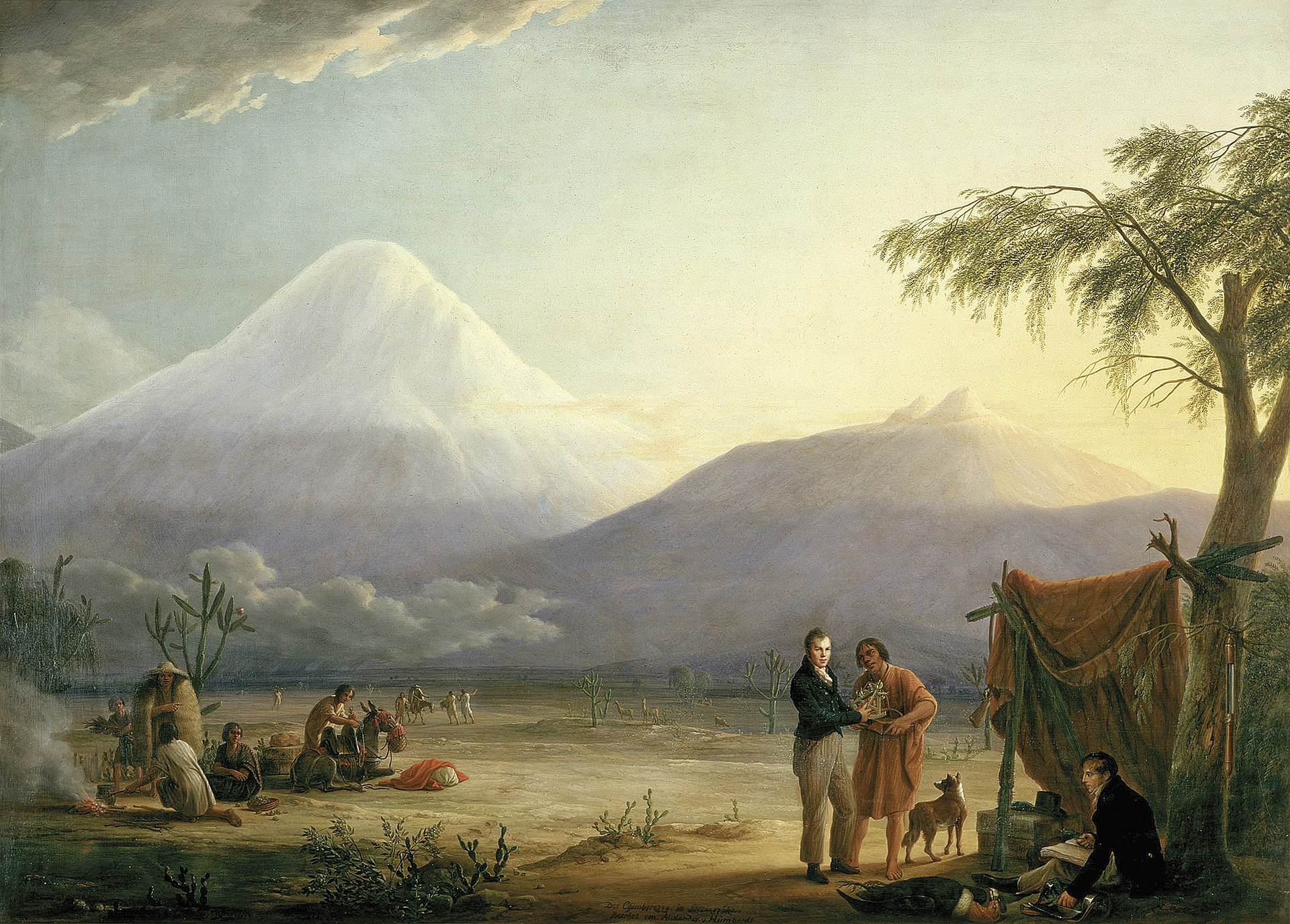 Humboldt and his fellow scientist Aimé Bonpland near the foot of the Chimborazo volcano, painting by Friedrich Georg Weitsch (1810) After their first stay in Cuba of three months, they returned to the mainland at Cartagena de Indias (now in Colombia), a major center of trade in northern South America. Ascending the swollen stream of the Magdalena River to Honda, they arrived in Bogotá on 6 July 1801, where they met the Spanish botanist José Celestino Mutis, head of the Royal Botanical Expedition to New Granada, staying there until 8 September 1801. Mutis was generous with his time and gave Humboldt access to the huge pictorial record he had compiled since 1783. Mutis was based in Bogotá, but as with other Spanish expeditions, he had access to local knowledge and a workshop of artists, who created highly accurate and detailed images. This type of careful recording meant that even if specimens were not available to study at a distance, "because the images travelled, the botanists did not have to".[72] Humboldt was astounded at Mutis's accomplishment; when Humboldt published his first volume on botany, he dedicated it to Mutis "as a simple mark of our admiration and acknowledgement".[73] Humboldt had hopes of connecting with the French sailing expedition of Baudin, now finally underway, so Bonpland and Humboldt hurried to Ecuador.[71] They crossed the frozen ridges of the Cordillera Real and reached Quito on 6 January 1802, after a tedious and difficult journey. Their stay in Ecuador was marked by the ascent of the active volcano Pichincha and their climb of the extinct, snow-capped volcano Chimborazo, where Humboldt and his party, consisting of himself, Bonpland, a number of Indians and the Ecuadorian nobleman Carlos Montúfar, reached an altitude of 19,286 feet (5,878 m).[13] This was a world record at the time, higher even than had been ascended in a balloon, (for a westerner—Incas had climbed much higher altitudes centuries before),[74] but 1000 feet short of the summit.[75] Humboldt's journey concluded with an expedition to the sources of the Amazon en route for Lima, Peru.[76] At Callao, the main port for Peru, Humboldt observed the transit of Mercury on 9 November and studied the fertilizing properties of guano, rich in nitrogen, the subsequent introduction of which into Europe was due mainly to his writings.[23] |
アンデス山脈、1801年~1803年 フンボルトと彼の同僚科学者エイメ・ボンプランがチンボラソ火山麓付近にいる様子。フリードリヒ・ゲオルク・ヴァイツによる絵画(1810年) キューバでの3ヶ月の最初の滞在後、彼らは南米北部の主要貿易拠点であるカルタヘナ・デ・インディアス(現在のコロンビア)で本土に戻った。増水したマグ ダレナ川を遡りホンダへ至り、1801年7月6日にボゴタに到着した。そこで彼らは、ニューグラナダ王立植物調査隊の責任者であるスペイン人植物学者ホ セ・セレスティーノ・ムティスと面会し、1801年9月8日まで滞在した。ムティスは寛大にも時間を割き、1783年から編纂してきた膨大な図譜記録をフ ンボルトに閲覧させた。ムティスはボゴタを拠点としていたが、他のスペインの探検隊と同様、現地の知識と芸術家の工房を利用できた。芸術家たちは非常に正 確で詳細な画像を作成した。この入念な記録手法により、遠隔地で標本を直接研究できなくとも、「図像が移動したため、植物学者が移動する必要はなかった」 のである[72]。フンボルトはムティスの業績に驚嘆し、自身の植物学第一巻を出版した際には「単なる敬意と感謝の印として」ムティスに献呈した。 [73] フンボルトは、ようやく出航したフランスのボーダン航海隊との連携を望んでいたため、ボンプランとフンボルトは急いでエクアドルへ向かった。[71] 彼らはコルディジェラ・レアルの凍った尾根を越え、退屈で困難な旅を経て1802年1月6日にキトに到着した。 エクアドル滞在中の彼らの主な活動は、活火山ピチンチャの登頂と、雪を冠した死火山チンボラソの登攀であった。フンボルトと同行者(フンボルト自身、ボン プラン、数名のインディオ、エクアドル貴族カルロス・モントゥファル)は、チンボラソで標高19,286フィート(5,878メートル)に到達した。 [13] これは当時世界記録であり、気球での到達高度さえ上回っていた(西洋人にとって——インカ人は数世紀前にこれよりはるかに高い高度に到達していたが) [74]、頂上まであと1000フィート(約305メートル)に迫っていた。[75] フンボルトの旅は、ペルーのリマへ向かう途中、アマゾン川源流への探検で幕を閉じた。[76] ペルーの主要港カヤオでは、フンボルトは11月9日に水星の太陽面通過を観測し、窒素を豊富に含むグアノの肥料としての特性を研究した。その後グアノがヨーロッパに導入されたのは、主に彼の著作によるものである。[23] |
New Spain (Mexico), 1803–1804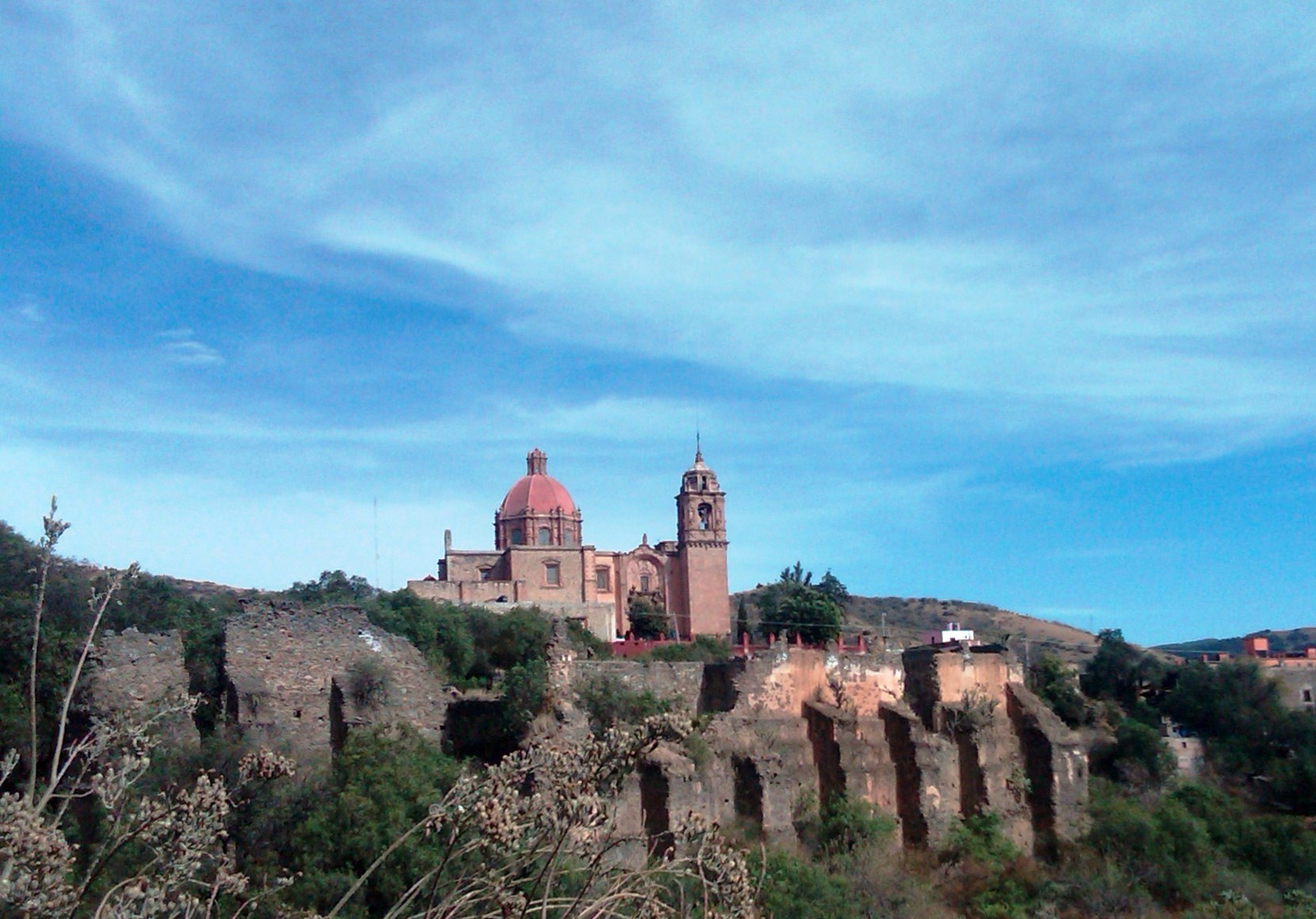 Silver mining complex of La Valenciana, Guanajuato, Mexico 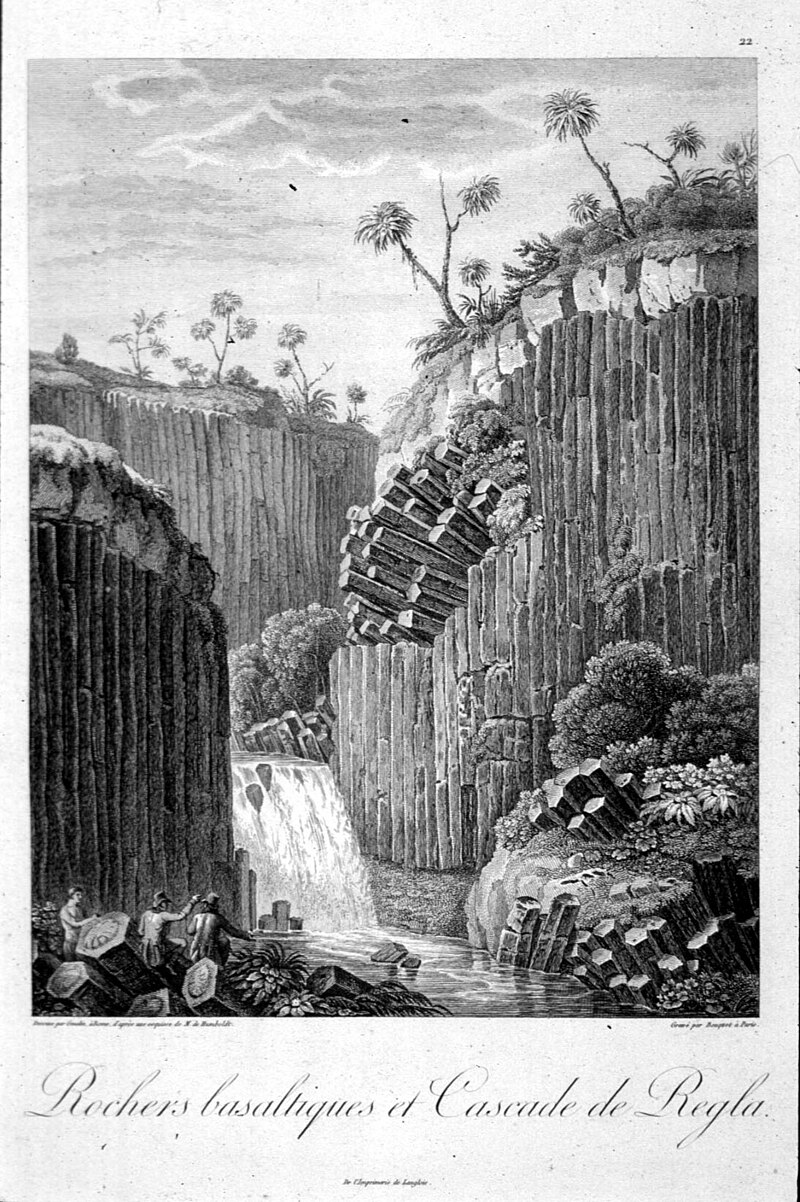 Basalt prisms at Santa María Regla, Mexico by Alexander von Humboldt, published in Vue des Cordillères et monuments des peuples indigènes de l'Amérique 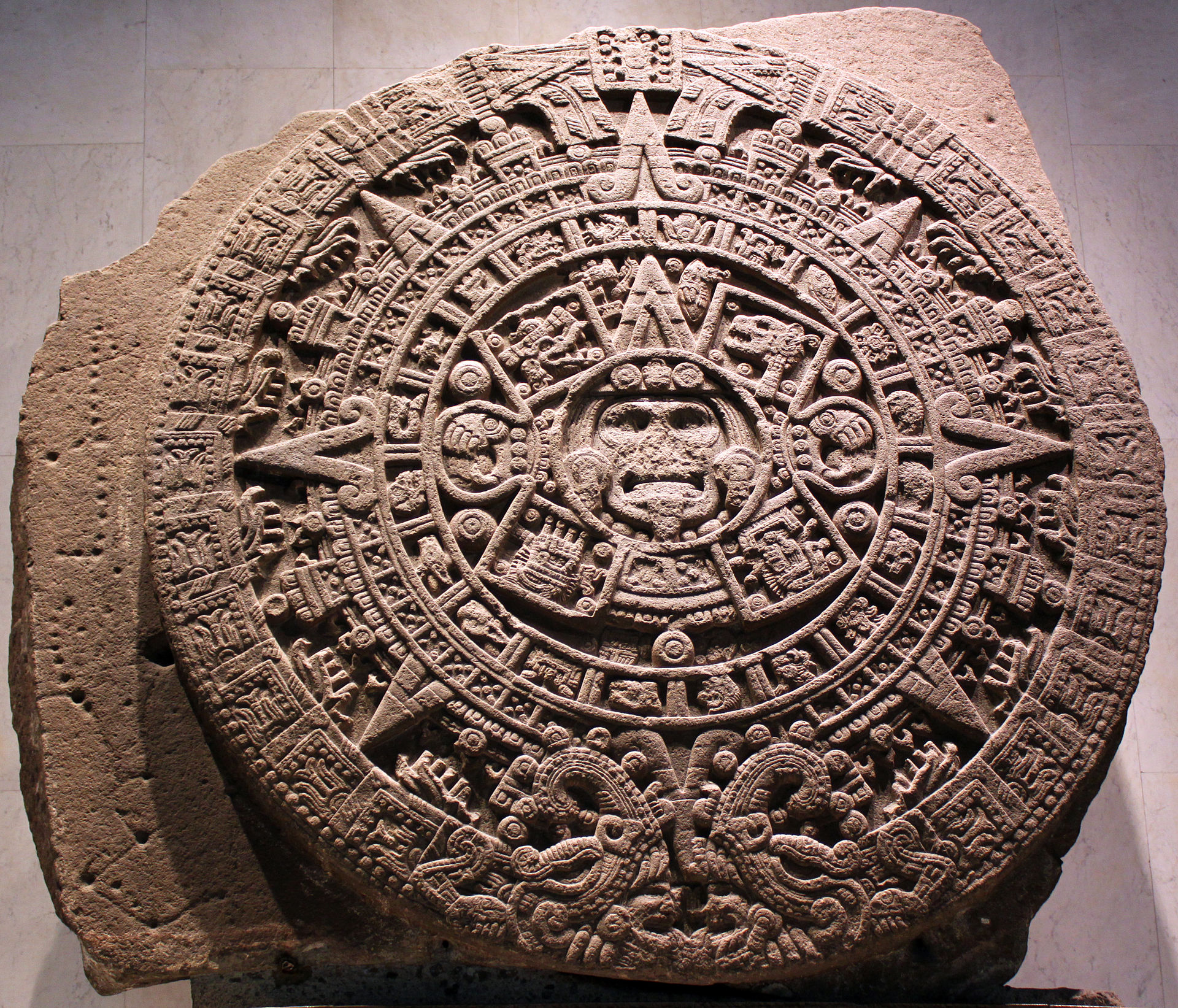 Aztec calendar stone 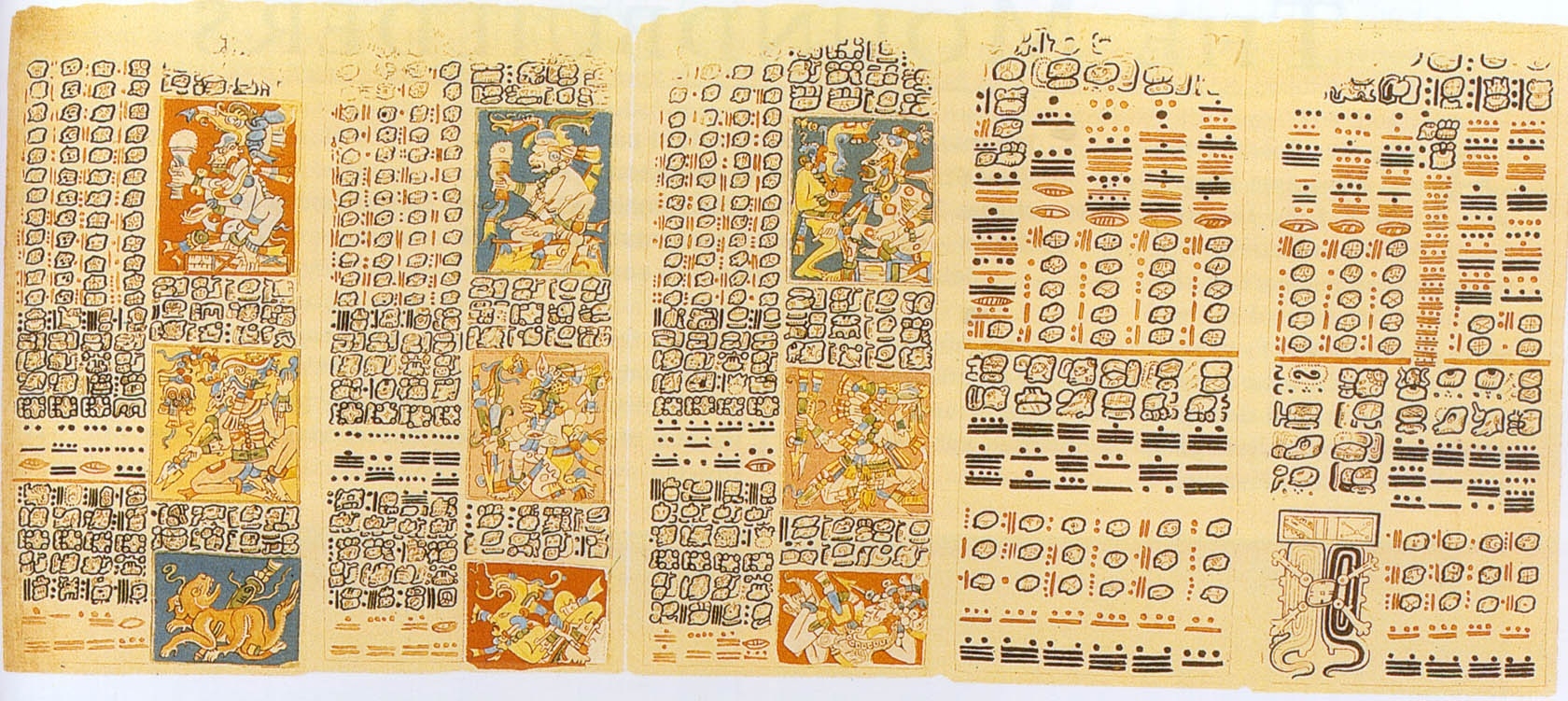 Dresden Codex, later identified as a Maya manuscript, published in part by Humboldt in 1810 Humboldt and Bonpland had not intended to go to New Spain, but when they were unable to join a voyage to the Pacific, they left the Ecuadorian port of Guayaquil and headed for Acapulco on Mexico's west coast. Even before Humboldt and Bonpland started on their way to New Spain's capital on Mexico's central plateau, Humboldt realized the captain of the vessel that brought them to Acapulco had reckoned its location incorrectly. Since Acapulco was the main west-coast port and the terminus of the Asian trade from the Spanish Philippines, having accurate maps of its location was extremely important. Humboldt set up his instruments, surveying the deep-water bay of Acapulco, to determine its longitude.[77][78] Humboldt and Bonpland landed in Acapulco on 15 February 1803, and from there they went to Taxco, a silver-mining town in modern Guerrero. In April 1803, he visited Cuernavaca, Morelos. Impressed by its climate, he nicknamed the city the City of Eternal Spring.[79][80] Humboldt and Bonpland arrived in Mexico City, having been officially welcomed via a letter from the king's representative in New Spain, Viceroy Don José de Iturrigaray. Humboldt was also given a special passport to travel throughout New Spain and letters of introduction to intendants, the highest officials in New Spain's administrative districts (intendancies). This official aid to Humboldt allowed him to have access to crown records, mines, landed estates, canals, and Mexican antiquities from the prehispanic era.[81] Humboldt read the writings of Bishop-elect of the important diocese of Michoacan Manuel Abad y Queipo, a classical liberal, that were directed to the crown for the improvement of New Spain.[82] They spent the year in the viceroyalty, traveling to different Mexican cities in the central plateau and the northern mining region. The first journey was from Acapulco to Mexico City, through what is now the Mexican state of Guerrero. The route was suitable only for mule train, and all along the way, Humboldt took measurements of elevation. When he left Mexico a year later in 1804, from the east coast port of Veracruz, he took a similar set of measures, which resulted in a chart in the Political Essay, the physical plan of Mexico with the dangers of the road from Acapulco to Mexico City, and from Mexico City to Veracruz.[83] This visual depiction of elevation was part of Humboldt's general insistence that the data he collected be presented in a way more easily understood than statistical charts. A great deal of his success in gaining a more general readership for his works was his understanding that "anything that has to do with extent or quantity can be represented geometrically. Statistical projections [charts and graphs], which speak to the senses without tiring the intellect have the advantage of bringing attention to a large number of important facts".[84] Humboldt was impressed with Mexico City, which at the time was the largest city in the Americas, and one that could be counted as modern. He declared "no city of the new continent, without even excepting those of the United States, can display such great and solid scientific establishments as the capital of Mexico".[85] He pointed to the Royal College of Mines, the Royal Botanical Garden and the Royal Academy of San Carlos as exemplars of a metropolitan capital in touch with the latest developments on the continent and insisting on its modernity.[86] He also recognized important criollo savants in Mexico, including José Antonio de Alzate y Ramírez, who died in 1799, just before Humboldt's visit; Miguel Velásquez de León; and Antonio de León y Gama.[82] Humboldt spent time at the Valenciana silver mine in Guanajuato, central New Spain, at the time the most important in the Spanish empire.[87] The bicentennial of his visit in Guanajuato was celebrated with a conference at the University of Guanajuato, with Mexican academics highlighting various aspects of his impact on the city.[88] Humboldt could have simply examined the geology of the fabulously rich mine, but he took the opportunity to study the entire mining complex as well as analyze mining statistics of its output. His report on silver mining is a major contribution, and considered the strongest and best informed section of his Political Essay. Although Humboldt was himself a trained geologist and mining inspector, he drew on mining experts in Mexico. One was Fausto Elhuyar, then head of the General Mining Court in Mexico City, who, like Humboldt was trained in Freiberg. Another was Andrés Manuel del Río, director of Royal College of Mines, whom Humboldt knew when they were both students in Freiberg.[89] The Bourbon monarchs had established the mining court and the college to elevate mining as a profession, since revenues from silver constituted the crown's largest source of income. Humboldt also consulted other German mining experts, who were already in Mexico.[82] While Humboldt was a welcome foreign scientist and mining expert, the Spanish crown had established fertile ground for Humboldt's investigations into mining. Spanish America's ancient civilizations were a source of interest for Humboldt, who included images of Mexican manuscripts (or codices) and Inca ruins in his richly illustrated Vues des cordillères et monuments des peuples indigènes de l'Amerique (1810–1813), the most experimental of Humboldt's publications, since it does not have "a single ordering principle" but his opinions and contentions based on observation.[90] For Humboldt, a key question was the influence of climate on the development of these civilizations.[91] When he published his Vues des cordillères, he included a color image of the Aztec calendar stone (which had been discovered in 1790 buried in the main plaza of Mexico City), along with select drawings of the Dresden Codex and others he sought out later in European collections. His aim was to muster evidence that these pictorial and sculptural images could allow the reconstruction of prehispanic history. He sought out Mexican experts in the interpretation of sources from there, especially Antonio Pichardo, who was the literary executor of Antonio de León y Gama's work. For American-born Spaniards (criollos) who were seeking sources of pride in Mexico's ancient past, Humboldt's recognition of these ancient works and dissemination in his publications was a boon. He read the work of exiled Jesuit Francisco Javier Clavijero, which celebrated Mexico's prehispanic civilization, and which Humboldt invoked to counter the pejorative assertions about the new world by Buffon, de Pauw, and Raynal.[92] Humboldt ultimately viewed both the prehispanic realms of Mexico and Peru as despotic and barbaric.[93] However, he also drew attention to indigenous monuments and artifacts as cultural productions that had "both ... historical and artistic significance".[94] One of his most widely read publications resulting from his travels and investigations in Spanish America was the Essai politique sur le royaum de la Nouvelle Espagne, quickly translated to English as Political Essay on the Kingdom of New Spain (1811).[95] This treatise was the result of Humboldt's own investigations as well as the generosity of Spanish colonial officials for statistical data.[96] |
新スペイン(メキシコ)、1803年~1804年 メキシコ、グアナフアト州、ラ・バレンシアナの銀鉱山  アレクサンダー・フォン・フンボルトによる、メキシコ、サンタ・マリア・レグラの玄武岩のプリズム(方解石?)。Vue des Cordillères et monuments des peuples indigènes de l'Amérique(アメリカ大陸の山脈と先住民遺跡)に掲載。  アステカ暦の石  ドレスデン写本、後にマヤの写本と確認され、1810年にフンボルトによって一部が刊行された フンボルトとボンプランは、ニュー・スペインに行くつもりはなかったが、太平洋への航海に参加できなかったため、エクアドルのグアヤキル港を出発し、メキ シコ西海岸のアカプルコに向かった。フンボルトとボンプランがメキシコ中央高原にある新スペインの首都へ向かう前に、フンボルトは彼らをアカプルコへ運ん だ船長がその位置を誤って計算していたことに気づいた。アカプルコは西海岸の主要港であり、スペイン領フィリピンからのアジア貿易の終着点であったため、 その位置の正確な地図を持つことは極めて重要だった。フンボルトは測量器具を設置し、アカプルコの深水湾を調査して経度を測定した。[77][78] フンボルトとボンプランは1803年2月15日にアカプルコに上陸し、そこから現代のゲレロ州にある銀鉱山の町タスコへ向かった。1803年4月、彼はモ レロス州クエルナバカを訪れた。その気候に感銘を受け、この街を「永遠の春の都」と称した[79][80]。フンボルトとボンプランはメキシコシティに到 着し、新スペイン総督ドン・ホセ・デ・イトゥリガライから国王代理人による書簡を通じ、公式に歓迎を受けた。フンボルトは新スペイン全域を移動するための 特別通行証と、各行政区(総督府)の最高責任者である総督への紹介状も授与された。この公的支援により、彼は王室記録、鉱山、土地所有地、運河、そして先 コロンブス期メキシコの古代遺跡へのアクセスを許可された[81]。フンボルトは、ミチョアカン教区の司教候補者マヌエル・アバド・イ・ケイポ(古典的自 由主義者)が新スペインの改善のために王室に提出した文書を読んだ。[82] 彼らは副王領で1年間を過ごし、中央高原や北部の鉱山地帯にある様々なメキシコの都市を旅した。最初の旅はアカプルコからメキシコシティへ、現在のゲレー ロ州を通るルートだった。このルートはラバ隊列にしか適さず、道中ずっとフンボルトは標高測定を行った。1年後の1804年にメキシコを去る際、東海岸の 港ベラクルスから同様の測定を行い、その結果は『政治論考』内の図表となった。これはメキシコの地形図であり、アカプルコからメキシコシティ、メキシコシ ティからベラクルスまでの道路の危険性を示していた。[83] この標高の視覚的表現は、フンボルトが収集したデータを統計図表よりも理解しやすい形で提示すべきだと主張した姿勢の一端である。彼の著作がより広範な読 者層を獲得できた大きな要因は、「範囲や量に関わる事象は幾何学的に表現できる」という理解にあった。知性を疲弊させずに感覚に訴える統計的投影(図表や グラフ)は、多数の重要事実に注意を向ける利点がある」という彼の理解に起因していた。[84] フンボルトは当時アメリカ大陸最大の都市であり、近代的と評せられるメキシコシティに感銘を受けた。彼は「新大陸のどの都市も、アメリカ合衆国の都市さえ 例外とせず、メキシコ首都のような偉大で堅固な科学施設を誇れない」と宣言した。[85] 王立鉱山大学、王立植物園、サン・カルロス王立アカデミーを、大陸の最新動向に触れつつその近代性を主張する首都の模範として挙げたのである。[86] また、フンボルト訪問直前の1799年に死去したホセ・アントニオ・デ・アルサーテ・イ・ラミレス、ミゲル・ベラスケス・デ・レオン、アントニオ・デ・レ オン・イ・ガマら、メキシコの重要なクリオージョの学者たちも認めた。[82] フンボルトは当時スペイン帝国で最も重要な鉱山であった、ヌエバ・エスパーニャ中央部のグアナファトにあるバレンシアナ銀山を訪れた。[87] 彼のグアナファト訪問二百周年を記念し、グアナファト大学で会議が開催され、メキシコの学者たちが同市への彼の影響の様々な側面を強調した。[88] フンボルトは単にこの驚異的な富を生み出す鉱山の地質を調査するだけでもよかったが、彼は鉱山施設全体を研究し、その産出量の統計分析を行う機会を得た。 彼の銀鉱業に関する報告書は重要な貢献であり、『政治論考』の中で最も力強く、最も情報量の多い部分とされている。フンボルト自身は訓練を受けた地質学者 であり鉱山監督官であったが、メキシコの鉱業専門家たちの知見も活用した。その一人、ファウスト・エルユアルは当時メキシコシティの鉱山総監を務めてお り、フンボルト同様フライベルクで学んだ経歴を持つ。もう一人は王立鉱山学院の院長アンドレス・マヌエル・デル・リオで、フンボルトはフライベルク在学中 に彼と知り合いだった。[89] ブルボン王朝は銀の産出が王室の最大の収入源であったため、鉱業を専門職として確立すべく鉱山裁判所と鉱山大学を設立していた。フンボルトは既にメキシコ に滞在していた他のドイツ人鉱山専門家にも助言を求めた。[82] フンボルトは歓迎される外国人科学者・鉱山専門家であったが、スペイン王室が整えた環境こそが彼の鉱業調査の肥沃な土壌となっていた。 スペイン領アメリカにおける古代文明はフンボルトの関心の対象であり、彼はメキシコの写本(コデックス)やインカ遺跡の画像を、豊富な図版を伴う著作『ア メリカ山脈と先住民遺跡の図譜』(1810-1813年)に収録した。これはフンボルトの著作の中で最も実験的なもので、「単一の体系化原理」を持たず、 観察に基づく彼の意見と主張で構成されていた。[90] フンボルトにとって重要な疑問は、気候がこれらの文明の発展に与えた影響であった。[91] 『山脈と先住民の遺跡』刊行時には、アステカ暦石(1790年にメキシコシティ中心広場から発掘)の彩色図版に加え、ドレスデン写本や欧州所蔵品から後年 収集した図版を掲載した。彼の目的は、こうした図像や彫刻が先スペイン時代の歴史再構築に資する証拠を提示することにあった。彼は現地資料の解釈に精通し たメキシコ人専門家、特にアントニオ・デ・レオン・イ・ガマの著作の文学的執行者であったアントニオ・ピチャルドを特に求めた。メキシコの古代過去に誇り の源泉を求めるアメリカ生まれのスペイン人(クリオージョ)にとって、フンボルトによるこれらの古代作品の認知と著作を通じた普及は大きな恩恵であった。 彼は亡命イエズス会士フランシスコ・ハビエル・クラビヘロの著作を読んだ。この著作はメキシコの先コロンブス期文明を称賛するものであり、フンボルトはブ フォン、ド・ポー、レイナルによる新世界への貶めるような主張に対抗するためにこれを引用した[92]。フンボルトは最終的に、メキシコとペルーの先コロ ンブス期領域の両方を専制的かつ野蛮なものとして見なした。しかし彼は同時に、先住民の建造物や工芸品を「歴史的かつ芸術的意義を併せ持つ文化的産物」と して注目した。[94] スペイン領アメリカでの旅行と調査から生まれた彼の最も広く読まれた著作の一つが『新スペイン王国に関する政治論考』(Essai politique sur le royaum de la Nouvelle Espagne)であり、これはすぐに英語に翻訳され『新スペイン王国に関する政治論考』(1811年)として出版された。[95] この論文はフンボルト自身の調査と、スペイン植民地当局者による統計データの提供という寛大さの結果であった。[96] |
The United States, 1804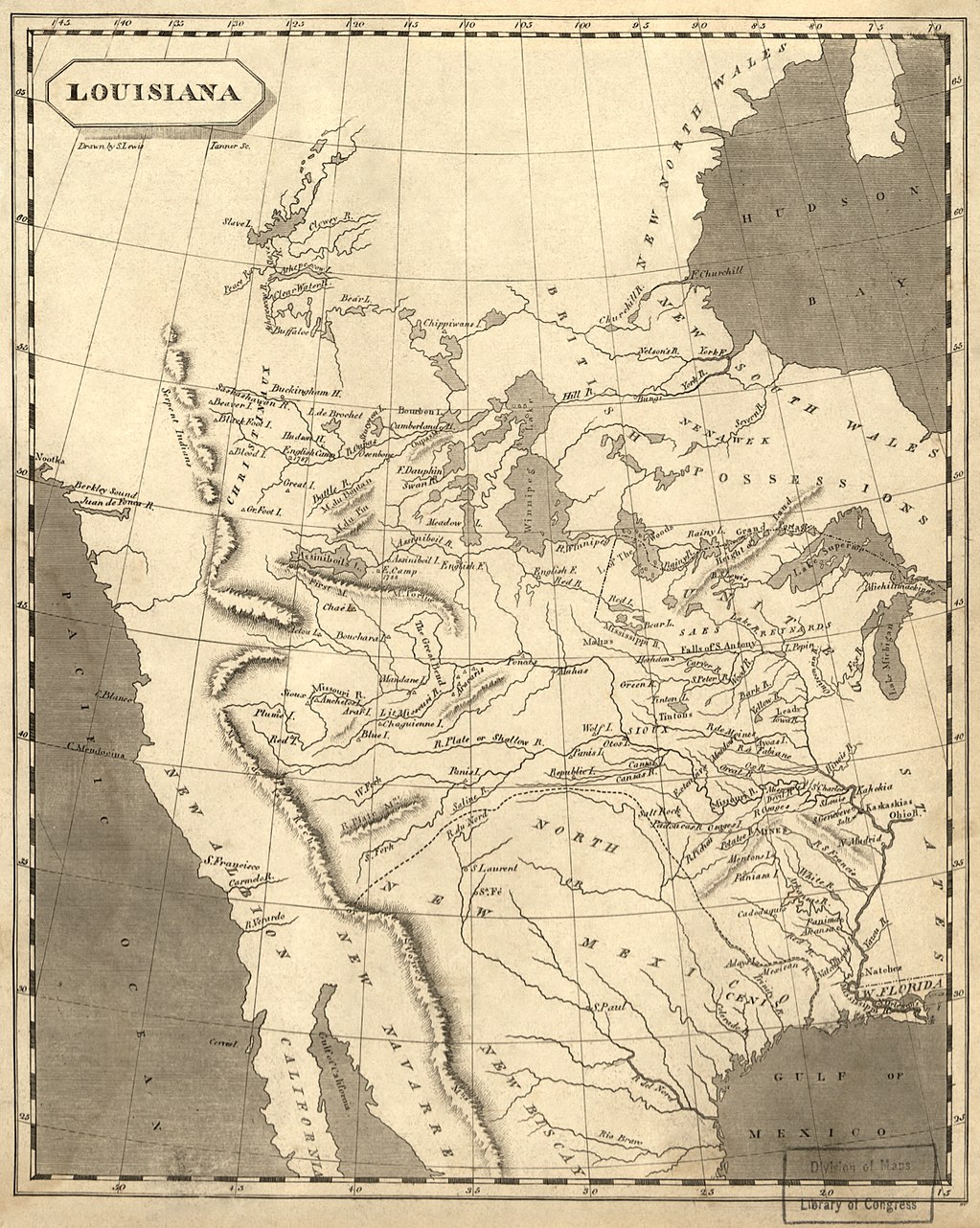 1804 map of the Louisiana Territory. Jefferson and his cabinet sought information from Humboldt when he visited Washington, D.C., about Spain's territory in Mexico, now bordering the U.S. Leaving from Cuba, Humboldt decided to take an unplanned short visit to the United States. Knowing that the current U.S. president, Thomas Jefferson, was himself a scientist, Humboldt wrote to him saying that he would be in the United States. Jefferson warmly replied, inviting him to visit the White House in the nation's new capital. In his letter Humboldt had gained Jefferson's interest by mentioning that he had discovered mammoth teeth near the Equator. Jefferson had previously written that he believed mammoths had never lived so far south. Humboldt had also hinted at his knowledge of New Spain.[97] Arriving in Philadelphia, which was a center of learning in the U.S., Humboldt met with some of the major scientific figures of the era, including chemist and anatomist Caspar Wistar, who pushed for compulsory smallpox vaccination, and botanist Benjamin Smith Barton, as well as physician Benjamin Rush, a signer of the Declaration of Independence, who wished to hear about cinchona bark from a South American tree, which cured fevers.[98] Humboldt's treatise on cinchona was published in English in 1821.[99] After arriving in Washington D.C, Humboldt held numerous intense discussions with Jefferson on both scientific matters and also his year-long stay in New Spain. Jefferson had only recently concluded the Louisiana Purchase, which now placed New Spain on the southwest border of the United States. The Spanish minister in Washington, D.C. had declined to furnish the U.S. government with information about Spanish territories, and access to the territories was strictly controlled. Humboldt was able to supply Jefferson with the latest information on the population, trade agriculture and military of New Spain. This information would later be the basis for his Essay on the Political Kingdom of New Spain (1810). Jefferson was unsure of where the border of the newly-purchased Louisiana was precisely, and Humboldt wrote him a two-page report on the matter. Jefferson would later refer to Humboldt as "the most scientific man of the age". Albert Gallatin, Secretary of the Treasury, said of Humboldt "I was delighted and swallowed more information of various kinds in less than two hours than I had for two years past in all I had read or heard." Gallatin, in turn, supplied Humboldt with information he sought on the United States.[97] After six weeks, Humboldt set sail for Europe from the mouth of the Delaware and landed at Bordeaux on 3 August 1804. |
アメリカ合衆国、1804年 1804年のルイジアナ準州の地図。ジェファーソン大統領とその閣僚は、フンボルトがワシントンD.C.を訪れた際、スペインのメキシコ領(現在のアメリカ国境地帯)に関する情報を求めた。 キューバを出発したフンボルトは、予定外の短い米国訪問を決めた。当時の米国大統領トーマス・ジェファーソン自身が科学者であることを知っていたフンボル トは、米国に滞在する旨を彼に手紙で伝えた。ジェファーソンは温かい返事を返し、新首都にあるホワイトハウスを訪問するよう招待した。フンボルトは書簡 で、赤道付近でマンモスの歯を発見したと述べ、ジェファーソンの関心を引いた。ジェファーソンは以前、マンモスがこれほど南の地に生息したことはないと記 していたのである。フンボルトはまた、新スペインに関する知識をほのめかしていた[97]。 フィラデルフィアに到着したフンボルトは、当時の主要な科学者たちと面会した。その中には、天然痘予防接種の義務化を推進した化学者・解剖学者カスパー・ ウィスター、植物学者ベンジャミン・スミス・バートン、そして独立宣言署名者であり医師のベンジャミン・ラッシュも含まれていた。ラッシュは南米産のキナ 樹皮について聞きたがっていた。この樹皮は熱病を治す効果があったのだ。[98] フンボルトのキナに関する論文は1821年に英語で出版された。[99] ワシントンD.C.に到着後、フンボルトはジェファーソンと科学問題や新スペインでの1年間の滞在について数多くの熱心な議論を交わした。ジェファーソン はルイジアナ購入を完了したばかりで、これにより新スペインは米国の南西国境に位置することになった。ワシントンD.C.のスペイン公使は、スペイン領土 に関する情報を米国政府に提供することを拒否し、領土へのアクセスは厳しく制限されていた。フンボルトはジェファーソンに、ニュー・スペインの人口、貿 易、農業、軍事に関する最新情報を提供することができた。この情報は後に、彼の『ニュー・スペイン政治王国論』(1810年)の基礎となる。 ジェファーソンは新たに購入したルイジアナの国境がどこにあるのか正確に把握できていなかった。フンボルトはこの件について2ページにわたる報告書を彼に 提出した。ジェファーソンは後にフンボルトを「この時代で最も科学的な人物」と呼んだ。財務長官アルバート・ガラティンはフンボルトについて「私は大いに 喜び、わずか2時間足らずで、過去2年間に読んだものや聞いたもの全てよりも多様な情報を吸収した」と述べた。ガラティンは逆に、フンボルトが求めていた アメリカ合衆国に関する情報を提供した。[97] 6週間後、フンボルトはデラウェア川河口からヨーロッパへ向けて出航し、1804年8月3日にボルドーに上陸した。 |
| Travel diaries Humboldt kept a detailed diary of his sojourn to Spanish America, running some 4,000 pages, which he drew on directly for his multiple publications following the expedition. The leather-bound diaries themselves are now in Germany, having been returned from Russia to East Germany, where they were taken by the Red Army after World War II. Following German reunification, the diaries were returned to a descendant of Humboldt. For a time, there was concern about their being sold, but that was averted.[100] A government-funded project to digitize the Spanish American expedition as well as his later Russian expedition has been undertaken (2014–2017) by the University of Potsdam and the German State Library–Prussian Cultural Heritage Foundation.[101] |
旅行日記 フンボルトはスペイン領アメリカへの滞在について詳細な日記を記した。そのページ数は約4,000ページに及び、遠征後の複数の出版物に直接活用された。 革装丁の日記帳自体は現在ドイツにある。第二次世界大戦後、赤軍によってロシアから東ドイツへ持ち去られた後、返還されたのである。ドイツ再統一後、日記 はフンボルトの子孫に返還された。一時、売却の懸念があったが、それは回避された[100]。スペイン領アメリカ遠征および後のロシア遠征の日記をデジタ ル化する政府資金によるプロジェクトが、ポツダム大学とドイツ国立図書館・プロイセン文化財団によって実施されている(2014-2017年) [101]。 |
| Achievements of the Hispanic American expedition See also: Humboldtian science Humboldt's decades' long endeavor to publish the results of this expedition not only resulted in multiple volumes, but also made his international reputation in scientific circles. Humboldt came to be well-known with the reading public as well, with popular, densely illustrated, condensed versions of his work in multiple languages. Bonpland, his fellow scientist and collaborator on the expedition, collected botanical specimens and preserved them, but unlike Humboldt who had a passion to publish, Bonpland had to be prodded to do the formal descriptions. Many scientific travelers and explorers produced huge visual records which remained unseen by the general public until the late nineteenth century. In the case of the Malaspina Expedition, it was not until the late twentieth century when Mutis's botanical, some 12,000 drawings from New Granada, was published. Humboldt, by contrast, published immediately and continuously, using and ultimately exhausting his personal fortune, to produce both scientific and popular texts. Humboldt's name and fame were made by his travels to Spanish America, particularly his publication of the Political Essay on the Kingdom of New Spain; his image as the premier European scientist was a later development.[102] For the Bourbon crown, which had authorized the expedition, the returns were not only tremendous in terms of sheer volume of data on their New World realms, but in dispelling the vague and pejorative assessments of the New World by Guillaume-Thomas Raynal, Georges-Louis Leclerc, Comte de Buffon, and William Robertson. The achievements of the Bourbon regime, especially in New Spain, were evident in the precise data Humboldt systematized and published.[82] This memorable expedition may be regarded as having laid the foundation of the sciences of physical geography, plant geography, and meteorology. Key to that was Humboldt's meticulous and systematic measurement of phenomena with the most advanced instruments then available. He closely observed plant and animal species in situ, not just in isolation, noting all elements in relation to one other. He collected specimens of plants and animals, dividing the growing collection so that if a portion was lost, other parts might survive. 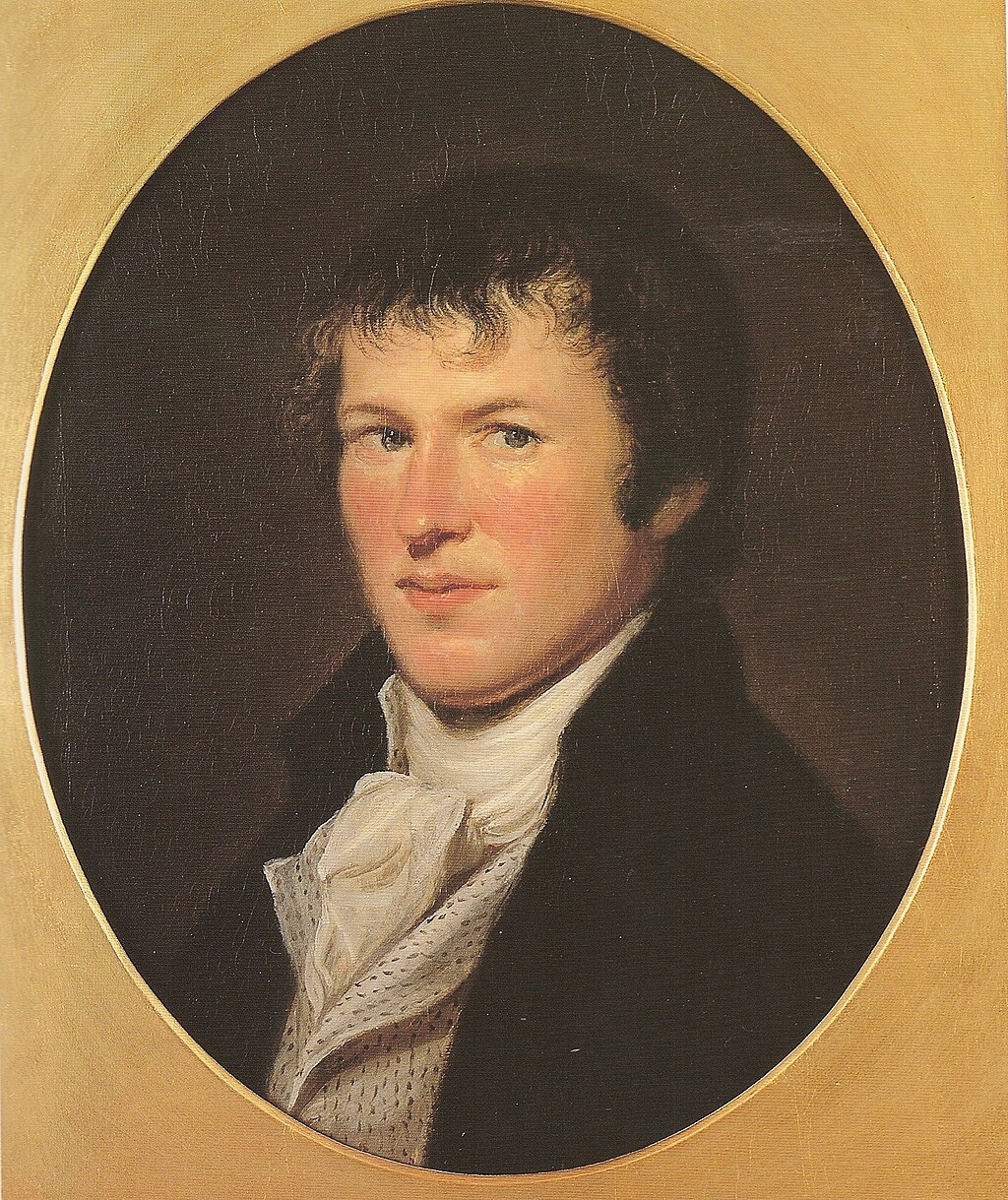 Humboldt depicted by American artist Charles Willson Peale, 1805, who met Humboldt when he visited the U.S. in 1804 Humboldt saw the need for an approach to science that could account for the harmony of nature among the diversity of the physical world. For Humboldt, "the unity of nature" meant that it was the interrelation of all physical sciences—such as the conjoining between biology, meteorology and geology—that determined where specific plants grew. He found these relationships by unraveling myriad, painstakingly collected data,[103] data extensive enough that it became an enduring foundation upon which others could base their work. Humboldt viewed nature holistically, and tried to explain natural phenomena without the appeal to religious dogma. He believed in the central importance of observation, and as a consequence had amassed a vast array of the most sophisticated scientific instruments then available. Each had its own velvet lined box and was the most accurate and portable of its time; nothing quantifiable escaped measurement. According to Humboldt, everything should be measured with the finest and most modern instruments and sophisticated techniques available, for that collected data was the basis of all scientific understanding. This quantitative methodology would become known as Humboldtian science. Humboldt wrote "Nature herself is sublimely eloquent. The stars as they sparkle in firmament fill us with delight and ecstasy, and yet they all move in orbit marked out with mathematical precision."[104] However, Andreas Daum has recently revisited the concept of Humboldtian Science and set it apart from "Humboldt's science".[105] |
ヒスパニック・アメリカ遠征の成果 関連項目: フンボルトの科学 フンボルトがこの遠征の成果を出版するために費やした数十年の努力は、複数の巻を成すだけでなく、科学界における彼の国際的な名声をもたらした。フンボル トは一般読者にも広く知られるようになり、彼の著作は多言語で、図版を豊富に盛り込んだ大衆向けの要約版として出版された。同行した科学者で共同研究者の ボンプランは植物標本を収集・保存したが、出版への情熱を持っていたフンボルトとは異なり、正式な記述を行うよう促される必要があった。多くの科学旅行者 や探検家は膨大な視覚的記録を残したが、それらが一般大衆の目に触れるようになったのは19世紀後半になってからだった。マラスピナ探検隊の場合、ムティ スがニューグラナダで描いた約12,000点の植物図譜が出版されたのは20世紀後半になってからである。これに対しフンボルトは、個人資産を使い果たす ほどに、科学的著作と大衆向け著作の両方を即座かつ継続的に出版した。フンボルトの名声はスペイン領アメリカへの旅行、特に『新スペイン王国に関する政治 論考』の出版によって確立された。彼がヨーロッパを代表する科学者としてのイメージを確立したのは、その後になってからのことである[102]。 この探検を許可したブルボン王朝にとって、その見返りは、新世界に関する膨大な量のデータというだけでなく、ギヨーム・トマ・レイナル、ジョルジュ・ル イ・ルクレール・ビュフォン伯爵、ウィリアム・ロバートソンによる新世界に対する曖昧で軽蔑的な評価を払拭したことでもあった。ブルボン王朝、特にニュー スペインにおけるその成果は、フンボルトが体系化し出版した正確なデータに明らかであった。[82] この記念すべき探検は、自然地理学、植物地理学、気象学の基礎を築いたものと見なすことができる。その鍵となったのは、フンボルトが当時入手可能な最先端 の機器を用いて、現象を綿密かつ体系的に測定したことである。彼は、植物や動物を単独で観察するだけでなく、その生息地で注意深く観察し、相互に関連する すべての要素を記録した。彼は動植物の標本を収集し、増え続けるコレクションを分割して保管した。これにより、一部が失われても他の部分が保存されるよう にしたのである。  1805年、アメリカ人画家チャールズ・ウィルソン・ピールが描いたフンボルトの肖像画。フンボルトが1804年にアメリカを訪問した際、ピールは彼と面会している。 フンボルトは、物理世界の多様性の中に存在する自然の調和を説明できる科学的アプローチの必要性を認識していた。彼にとって「自然の統一性」とは、生物 学・気象学・地質学といった全ての物理科学の相互関係が、特定の植物の生育地を決定するという意味であった。彼は、膨大な量の丹念に収集されたデータを解 きほぐすことでこれらの関係を発見した[103]。そのデータは極めて広範であり、後続の研究者が基盤とできる永続的な土台となった。フンボルトは自然を 全体として捉え、宗教的教義に頼らずに自然現象を説明しようとした。彼は観察の重要性を核心と信じ、その結果として当時入手可能な最も精巧な科学機器を数 多く集めた。各器具はベルベット張りの専用箱に収められ、当時最も正確かつ携帯性に優れていた。測定可能なものは何一つ逃さなかった。フンボルトによれ ば、あらゆるものは入手可能な最高峰の近代的器具と洗練された技術で計測されるべきであり、その収集データこそが科学的理解の基盤となるのだ。 この定量的手法は後にフンボルト科学として知られるようになる。フンボルトはこう記している。「自然そのものが崇高な雄弁さを備えている。大空にきらめく 星々は我々に歓喜と恍惚をもたらすが、それらはすべて数学的な精度で定められた軌道に沿って動いているのだ」[104]。しかしアンドレアス・ダウムは近 年、フンボルト的科学の概念を再検討し、「フンボルトの科学」とは区別する立場を取っている[105]。 |
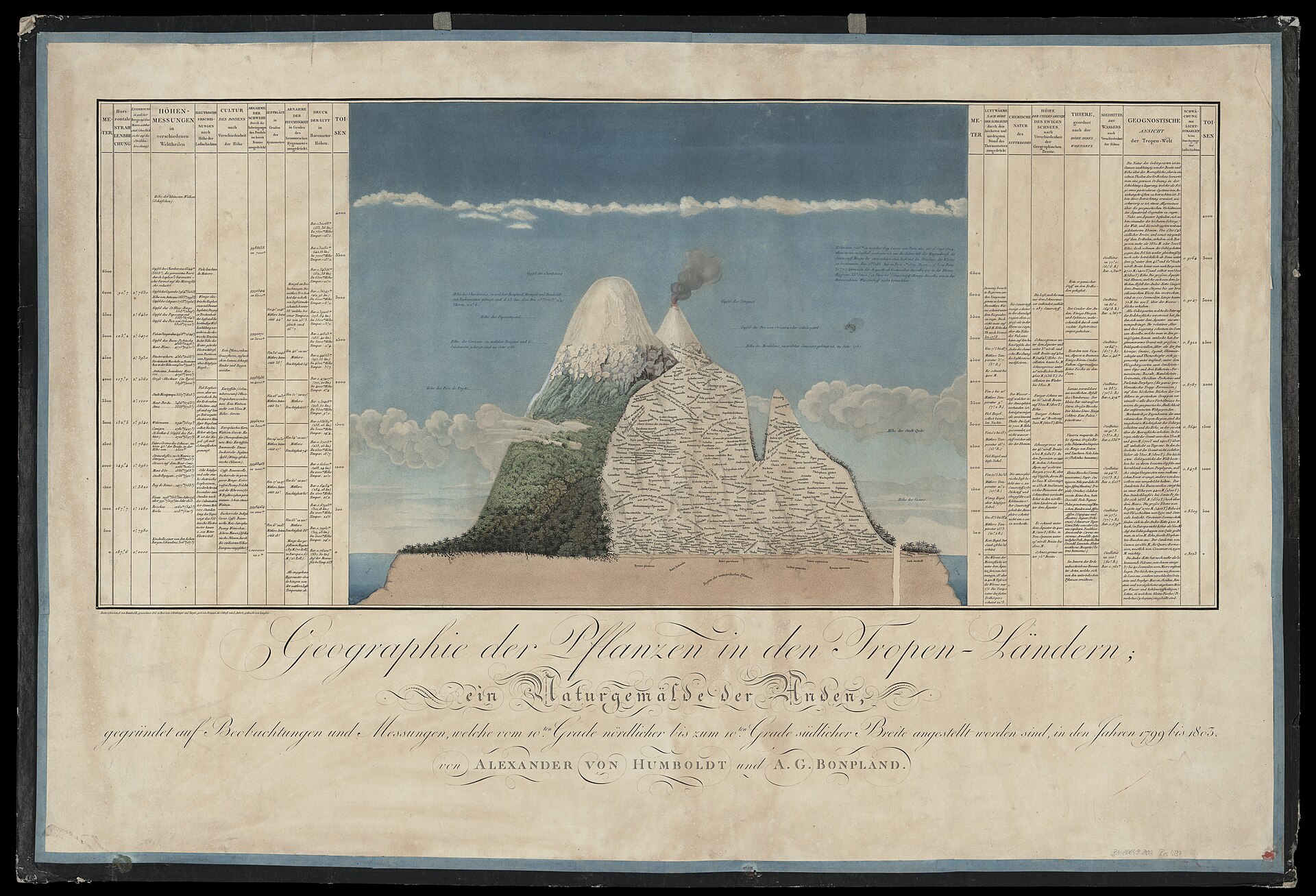 Humboldt's Naturgemälde, also known as the Chimborazo Map, is his depiction of the volcanoes Chimborazo and Cotopaxi in cross section, with detailed information about plant geography. The illustration was published in The Geography of Plants, 1807, in a large format (54 cm x 84 cm). Largely used for global warming analyses, this map depicts in fact the vegetation of another volcano: the Antisana.[106] His Essay on the Geography of Plants (published first in French and then German, both in 1807) was based on the then novel idea of studying the distribution of organic life as affected by varying physical conditions.[23] This was most famously depicted in his published cross-section of Chimborazo, approximately two feet by three feet (54 cm x 84 cm) color pictorial, he called Ein Naturgemälde der Anden and what is also called the Chimborazo Map. It was a fold-out at the back of the publication.[107] Humboldt first sketched the map when he was in South America, which included written descriptions on either side of the cross-section of Chimborazo. These detailed the information on temperature, altitude, humidity, atmosphere pressure, and the animal and plants (with their scientific names) found at each elevation. Plants from the same genus appear at different elevations. The depiction is on an east-west axis going from the Pacific coast lowlands to the Andean range of which Chimborazo was a part, and the eastern Amazonian basin. Humboldt showed the three zones of coast, mountains, and Amazonia, based on his own observations, but he also drew on existing Spanish sources, particularly Pedro Cieza de León, which he explicitly referred to. The Spanish American scientist Francisco José de Caldas had also measured and observed mountain environments and had earlier come to similar ideas about environmental factors in the distribution of life forms.[108] Humboldt was thus not putting forward something entirely new, but it is argued that his finding is not derivative either.[109] The Chimborazo map displayed complex information in an accessible fashion. The map was the basis for comparison with other major peaks. "The Naturgemälde showed for the first time that nature was a global force with corresponding climate zones across continents."[110] Another assessment of the map is that it "marked the beginning of a new era of environmental science, not only of mountain ecology but also of global-scale biogeophysical patterns and processes."[107] 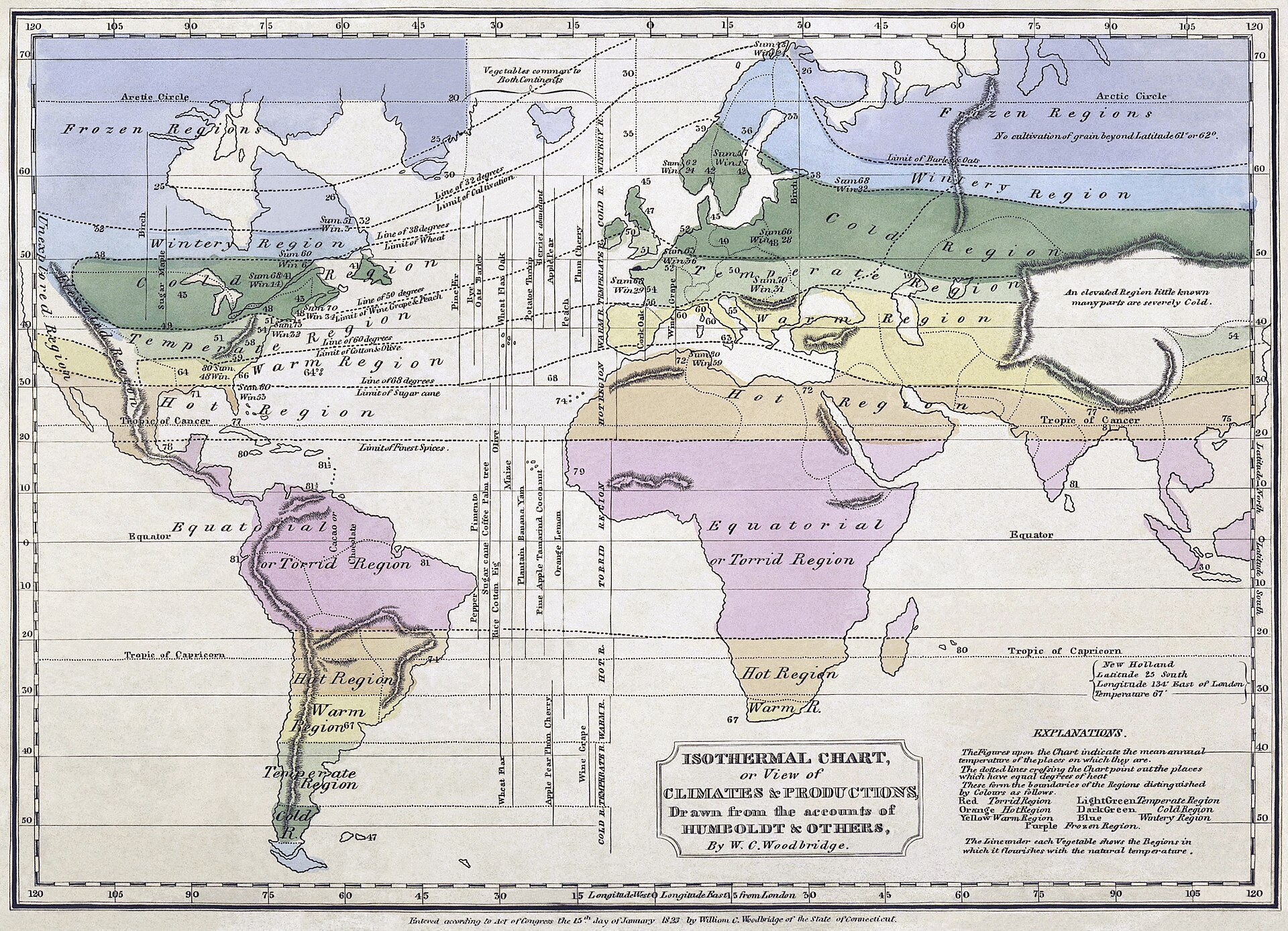 Isothermal map of the world using Humboldt's data by William Channing Woodbridge By his delineation (in 1817) of isothermal lines, he at once suggested the idea and devised the means of comparing the climatic conditions of various countries. He first investigated the rate of decrease in mean temperature with the increase in elevation above sea level, and afforded, by his inquiries regarding the origin of tropical storms, the earliest clue to the detection of the more complicated law governing atmospheric disturbances in higher latitudes.[23][111] This was a major contribution to climatology.[112][113] His discovery of the decrease in intensity of Earth's magnetic field from the poles to the equator was communicated to the Paris Institute in a memoir read by him on 7 December 1804. Its importance was attested by the speedy emergence of rival claims.[23] His services to geology were based on his attentive study of the volcanoes of the Andes and Mexico, which he observed and sketched, climbed, and measured with a variety of instruments. By climbing Chimborazo, he established an altitude record which became the basis for measurement of other volcanoes in the Andes and the Himalayas. As with other aspects of his investigations, he developed methods to show his synthesized results visually, using the graphic method of geologic-cross sections.[114] He showed that volcanoes fell naturally into linear groups, presumably corresponding with vast subterranean fissures; and by his demonstration of the igneous origin of rocks previously held to be of aqueous formation, he contributed largely to the elimination of erroneous views, such as Neptunism.[23] Humboldt was a significant contributor to cartography, creating maps, particularly of New Spain, that became the template for later mapmakers in Mexico. His careful recording of latitude and longitude led to accurate maps of Mexico, the port of Acapulco, the port of Veracruz, and the Valley of Mexico, and a map showing trade patterns among continents. His maps also included schematic information on geography, converting areas of administrative districts (intendancies) using proportional squares.[115] The U.S. was keen to see his maps and statistics on New Spain, since they had implication for territorial claims following the Louisiana Purchase.[116] Later in life, Humboldt published three volumes (1836–39) examining sources that dealt with the early voyages to the Americas, pursuing his interest in nautical astronomy in the fifteenth and sixteenth centuries. His research yielded the origin of the name "America", put on a map of the Americas by Martin Waldseemüller.[117] |
 フンボルトの『自然図譜』(別名チンボラソ図)は、チンボラソ山とコトパクシ山の断面図を描き、植物地理学の詳細な情報を記したものである。この図版は 1807年刊行の『植物地理学』に大型判(54cm×84cm)で掲載された。主に地球温暖化分析に用いられるこの地図は、実際には別の火山、アンティサ ナの植生を描いている。[106] 彼の『植物地理論』(1807年にまずフランス語で、次いでドイツ語で出版)は、変化する物理的条件が生物の分布に与える影響を研究するという当時として は斬新な考えに基づいていた。[23] この概念は、チンボラソ断面図として最も有名に表現された。約2フィート×3フィート(54cm×84cm)の彩色図版で、彼はこれを『アンデスの自然絵 画』(Ein Naturgemälde der Anden)と呼び、チンボラソ地図とも称される。出版物の裏表紙に折り込み図として掲載されていた。[107] フンボルトは南米滞在中にこの図を初めてスケッチした。チンボラソ断面図の両側には、各標高における気温・高度・湿度・気圧、そして発見された動植物(学 名付き)の詳細な記述が添えられていた。同じ属の植物が異なる標高に現れる。図示は太平洋沿岸の低地からアンデス山脈(チンボラソ山を含む)を経て東側の アマゾン盆地へと続く東西軸に沿って描かれている。フンボルトは自らの観察に基づき海岸部、山岳部、アマゾニアの三地域を示したが、既存のスペイン資料、 特にペドロ・シエサ・デ・レオンの著作を明示的に参照しながら描いた。スペイン系アメリカ人科学者フランシスコ・ホセ・デ・カルダスも山岳環境を測量・観 察し、生物分布における環境要因について先に同様の考えに至っていた[108]。したがってフンボルトが完全に新規なものを提示したわけではないが、彼の 発見が単なる模倣でもないことは議論されている[109]。チンボラソの地図は複雑な情報を分かりやすく示した。この地図は他の主要な山岳との比較の基礎 となった。「 『自然の絵画』は初めて、自然が大陸を越えて対応する気候帯を持つ地球規模の力であることを示した。」[110] この地図に対する別の評価では、「山岳生態学だけでなく、地球規模の生物地球物理学的パターンとプロセスにおいても、環境科学の新時代の始まりを画した」 とされている。[107]  ウィリアム・チャニング・ウッドブリッジによるフンボルトのデータを用いた世界等温線図 彼は(1817年に)等温線を明示したことで、様々な国の気候条件を比較する概念を即座に示唆し、その手段を考案した。彼はまず海抜高度の上昇に伴う平均 気温の低下率を調査し、熱帯暴風雨の起源に関する研究を通じて、高緯度地域の大気擾乱を支配するより複雑な法則の解明に向けた最初の手がかりを提供した。 [23][111] これは気候学への主要な貢献であった。[112][113] 彼が発見した、地球磁場の強度が極から赤道に向かって減少するという事実は、1804年12月7日に彼がパリ学士院で発表した論文で伝えられた。その重要性は、競合する主張が急速に現れたことで証明された。[23] 彼の地質学への貢献は、アンデス山脈とメキシコの火山に対する入念な研究に基づいていた。彼はこれらの火山を観察し、スケッチし、登頂し、様々な機器を用 いて測定した。チンボラソ山への登頂により、彼は高度測定の基準となる記録を確立し、これがアンデス山脈やヒマラヤ山脈の他の火山測定の基礎となった。他 の研究分野と同様に、彼は統合された結果を視覚的に示す手法を開発した。地質断面図という図解法を用いることで、火山が自然線状群をなすことを示した。こ れはおそらく広大な地下断層に対応するものであった。また、従来水成説で説明されていた岩石の火成起源を実証し、ネプチューニズムのような誤った見解の排 除に大きく貢献した。[23] フンボルトは地図学にも大きく貢献し、特にニュースペインの地図を作成した。それらは後のメキシコの製図家たちの模範となった。彼の緯度経度の精密な記録 は、メキシコ本土、アカプルコ港、ベラクルス港、メキシコ盆地の正確な地図、そして大陸間の貿易パターンを示す地図の制作につながった。彼の地図には地理 に関する概略情報も含まれており、行政区画(総督府)の面積を比例した正方形を用いて換算していた[115]。アメリカ合衆国は、ルイジアナ購入後の領土 主張に関わるため、彼のニュー・スペインに関する地図と統計を熱心に求めた。[116] その後、フンボルトは 3 巻(1836 年~1839 年)の著作を出版し、15 世紀および 16 世紀の航海天文学への関心を追求しながら、アメリカ大陸への初期の航海に関する資料を調査した。彼の研究により、マーティン・ヴァルトゼーミュラーがアメ リカ大陸の地図に付けた「アメリカ」という名前の由来が明らかになった。[117] |
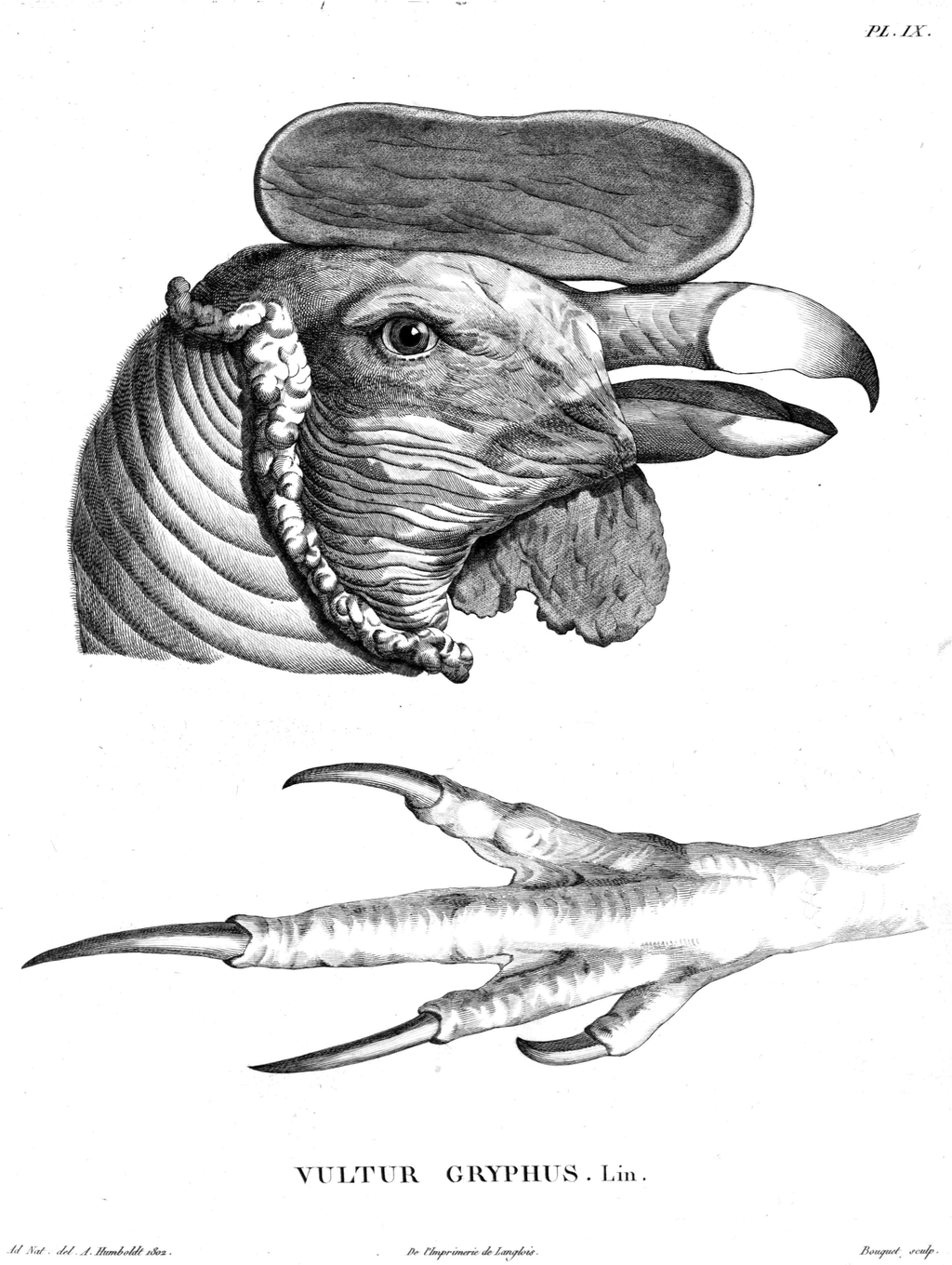 Humboldt's depiction of an Andean condor, an example of his detailed drawing Humboldt conducted a census of the indigenous and European inhabitants in New Spain, publishing a schematized drawing of racial types and populations distribution, grouping them by region and social characteristics.[118] He estimated the population to be six million individuals.[119][120] He estimated Indians to be forty percent of New Spain's population, but their distribution being uneven; the most dense were in the center and south of Mexico, the least dense in the north. He presented these data in chart form, for easier understanding.[121] He also surveyed the non-Indian population, categorized as Whites (Spaniards), Negroes, and castes (castas).[122] American-born Spaniards, so-called creoles had been painting depictions of mixed-race family groupings in the eighteenth century, showing father of one racial category, mother of another, and the offspring in a third category in hierarchical order, so racial hierarchy was an essential way elites viewed Mexican society.[123] Humboldt reported that American-born Spaniards were legally racial equals of those born in Spain, but the crown policy since the Bourbons took the Spanish throne privileged those born in Iberia. Humboldt observed that "the most miserable European, without education and without intellectual cultivation, thinks himself superior to whites born in the new continent".[124] The truth in this assertion, and the conclusions derived from them, have been often disputed as superficial, or politically motivated, by some authors, considering that between 40% and 60% of high offices in the new world were held by creoles.[125][126] The enmity between some creoles and the peninsular-born whites increasingly became an issue in the late period of Spanish rule, with creoles increasingly alienated from the crown. Humboldt's assessment was that royal government abuses and the example of a new model of rule in the United States were eroding the unity of whites in New Spain.[127] Humboldt's writings on race in New Spain were shaped by the memorials of the classical liberal, enlightened Bishop-elect of Michoacán, Manuel Abad y Queipo, who personally presented Humboldt with his printed memorials to the Spanish crown critiquing social and economic conditions and his recommendations for eliminating them.[128][126] One scholar says that his writings contain fantastical descriptions of America, while leaving out its inhabitants, stating that Humboldt, coming from the Romantic school of thought, believed '... nature is perfect till man deforms it with care'.[129] The further assessment is that he largely neglected the human societies amidst nature. Views of indigenous peoples as 'savage' or 'unimportant' leaves them out of the historical picture.[129] Other scholars counter that Humboldt dedicated large parts of his work to describing the conditions of slaves, indigenous peoples, mixed-race castas, and society in general. He often showed his disgust for the slavery[13]and inhumane conditions in which indigenous peoples and others were treated and he often criticized Spanish colonial policies.[130] Humboldt was not primarily an artist, but he could draw well, allowing him to record a visual record of particular places and their natural environment. Many of his drawings became the basis for illustrations of his many scientific and general publications. Artists whom Humboldt influenced, such as Johann Moritz Rugendas, followed in his path and painted the same places Humboldt had visited and recorded, such as the basalt formations in Mexico, which was an illustration in his Vues des Cordillères.[131][132] The editing and publication of the encyclopedic mass of scientific, political and archaeological material that had been collected by him during his absence from Europe was now Humboldt's most urgent desire. After a short trip to Italy with Joseph Louis Gay-Lussac for the purpose of investigating the law of magnetic declination and a stay of two and a half years in Berlin, in the spring of 1808, he settled in Paris. His purpose for being located there was to secure the scientific cooperation required for bringing his great work through the press. This colossal task, which he at first hoped would occupy but two years, eventually cost him twenty-one, and even then it remained incomplete. |
 フンボルトによるアンデスコンドルの描写。彼の詳細な描画の一例である フンボルトは新スペインにおける先住民とヨーロッパ系住民の人口調査を実施し、人種類型と人口分布を地域別・社会的特性別に分類した模式図を発表した [118]。彼は人口を600万人と推定した。[119][120] 彼は先住民がヌエバ・エスパーニャ人口の40%を占めると推定したが、その分布は不均一であった。最も密集していたのはメキシコ中部と南部で、最も疎だっ たのは北部であった。彼はこれらのデータを理解しやすくするため、図表形式で提示した。[121] また、非先住民人口についても調査を行い、白人(スペイン人)、黒人、混血(カスタス)に分類した。[122] 18世紀には、いわゆるクレオールと呼ばれるアメリカ生まれのスペイン人たちが、混血家族の階層的構成を描いた絵画を残している。父親が一方の人種カテゴ リー、母親が別のカテゴリー、そして子孫が第三のカテゴリーに属するという順序で示されており、人種的階層はエリート層がメキシコ社会を見る上で不可欠な 視点であった。[123] フンボルトは、アメリカ生まれのスペイン人は法的にはスペイン生まれの者と同じ人種的地位にあると報告した。しかしブルボン家がスペイン王位を継承して以 来、王室政策はイベリア半島生まれの者を優遇していた。フンボルトは「最も貧しく、教育も知的教養もないヨーロッパ人ですら、新大陸生まれの白人より自分 の方が優れていると考えている」と観察した。[124] この主張の真実性、およびそこから導かれる結論は、新大陸の高官職の40%から60%がクレオールによって占められていたことを考慮すると、表面的である とか政治的動機によるものだと、一部の著者によってしばしば争われてきた。[125][126] スペイン統治後期には、一部のクレオールと半島生まれの白人との敵意が深刻な問題となり、クレオールは次第に王室から疎外されていった。フンボルトは、王 政の暴政とアメリカ合衆国における新たな統治モデルの事例が、ヌエバ・エスパーニャにおける白人社会の結束を蝕んでいると評価した。[127] フンボルトの新スペインにおける人種論は、古典的自由主義者で啓蒙主義者であるミチョアカン州司教候補マヌエル・アバド・イ・ケイポの陳情書に影響を受け た。ケイポは自らフンボルトに、社会経済状況を批判しその解消策を提言した印刷済みの陳情書をスペイン王室宛てに手渡したのである。[128][126] ある学者は、フンボルトの著作にはアメリカ大陸の幻想的な描写が含まれる一方、その住民は省かれていると指摘する。ロマン主義思想に根ざしたフンボルトは 「…自然は人間が注意深く歪めるまでは完璧である」と信じていたという。[129] さらに、彼は自然の中に存在する人間社会をほとんど無視していたと評価される。先住民を「野蛮」あるいは「取るに足らない」と見なす視点は、彼らを歴史的 描写から排除した。[129] これに対し他の学者は、フンボルトが著作の大部分を奴隷、先住民、混血のカスタス、そして社会全般の状況を記述することに費やしたと反論する。彼はしばし ば奴隷制[13]や先住民らが置かれた非人道的な状況への嫌悪を示し、スペイン植民地政策を頻繁に批判した。[130] フンボルトは主に芸術家ではなかったが、優れた画力を持ち、特定の場所とその自然環境を視覚的に記録することができた。彼の多くの素描は、数多くの科学出 版物や一般向け出版物の挿絵の基礎となった。フンボルトの影響を受けた画家たち、例えばヨハン・モーリッツ・ルゲンダスは彼の足跡を辿り、フンボルトが訪 れて記録した同じ場所を描いた。例えばメキシコの玄武岩地形は、彼の『コルディエラ山脈の眺め』の挿絵となったのである。[131][132] ヨーロッパを離れている間に収集した膨大な科学的・政治的・考古学的資料を編集し出版することが、今やフンボルトにとって最も切実な願いとなった。磁気偏 角の法則を調査するためジョゼフ・ルイ・ゲイ=リュサックと共にイタリアへ短期間旅行した後、ベルリンで2年半滞在し、1808年の春にパリに定住した。 彼がそこに拠点を置いた目的は、自身の偉大な著作を出版するために必要な科学的協力を確保するためであった。当初はわずか2年で完了すると期待していたこ の巨大な作業は、結局21年を費やすことになり、それでもなお未完のままだった。 |
Scholarly and public recognition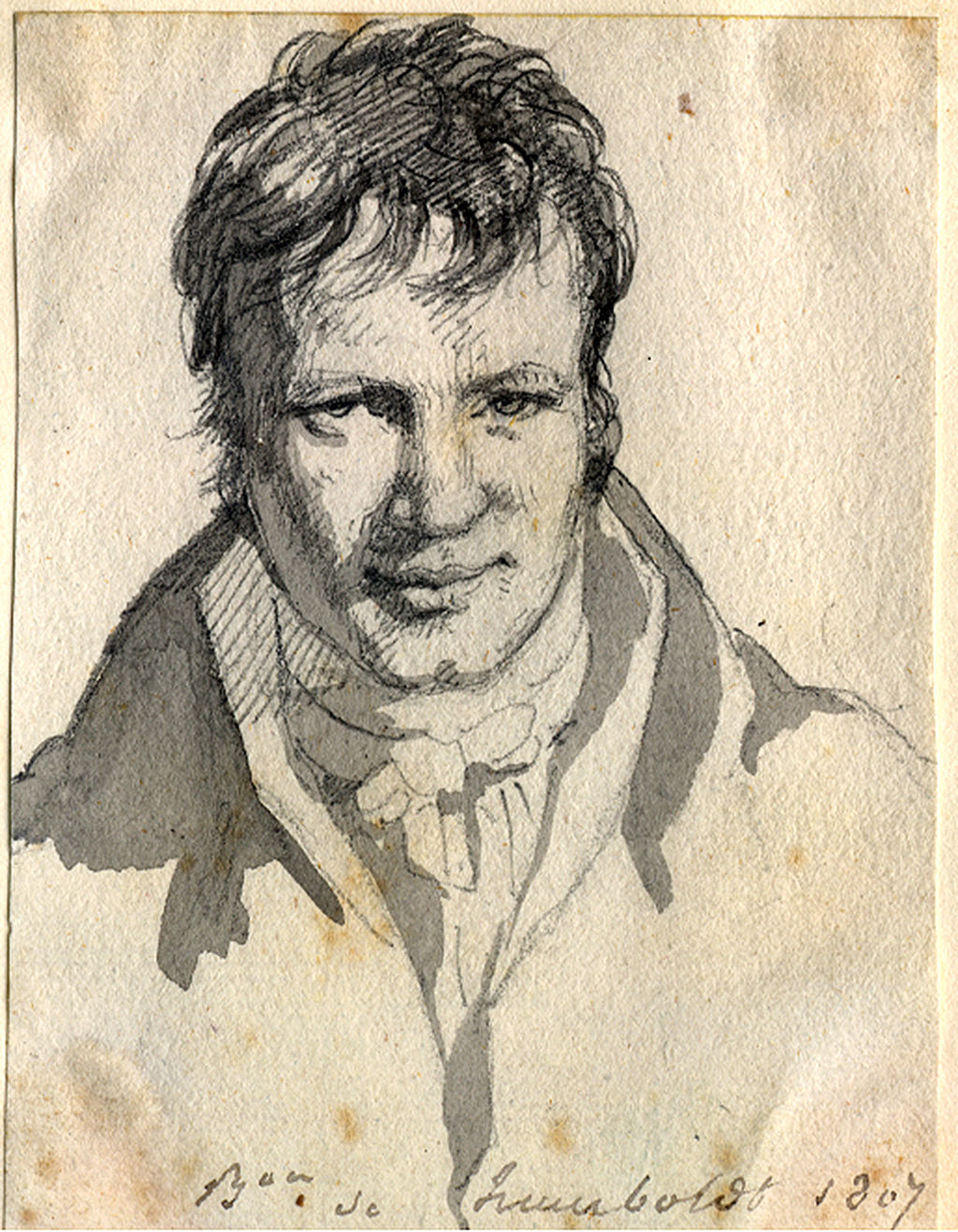 Humboldt in Berlin 1807 During his lifetime Humboldt became one of the most famous men in Europe.[133] Academies, both native and foreign, were eager to elect him to their membership, the first being The American Philosophical Society[134] in Philadelphia, which he visited at the tail end of his travel through the Americas. He was elected to the Prussian Academy of Sciences in 1805.[135] Over the years other learned societies in the U.S. elected him a member, including the American Antiquarian Society (Worcester, MA) in 1816;[136] the Linnean Society of London in 1818; the New York Historical Society in 1820; a Foreign Honorary Member of the American Academy of Arts and Sciences in 1822;[137] the American Ethnological Society (New York) in 1843; and the American Geographical and Statistical Society, (New York) in 1856.[138] He was elected a foreign member of the Royal Swedish Academy of Sciences in 1810. The Royal Society, whose president Sir Joseph Banks had aided Humboldt as a young man, now welcomed him as a foreign member.[139] After Mexican independence from Spain in 1821, the Mexican government recognized him with high honors for his services to the nation. In 1827, the first President of Mexico, Guadalupe Victoria granted Humboldt Mexican citizenship[140] and in 1859, the President of Mexico, Benito Juárez, named Humboldt a hero of the nation (benemérito de la nación).[141] The gestures were purely honorary; he never returned to the Americas following his expedition. Importantly for Humboldt's long-term financial stability, King Frederick William III of Prussia conferred upon him the honor of the post of royal chamberlain, without at the time exacting the duties. The appointment had a pension of 2,500 thalers, afterwards doubled. This official stipend became his main source of income in later years when he exhausted his fortune on the publications of his research. Financial necessity forced his permanent relocation to Berlin in 1827 from Paris. In Paris he found not only scientific sympathy, but the social stimulus which his vigorous and healthy mind eagerly craved. He was equally in his element as the lion of the salons and as the savant of the Institut de France and the observatory.  Memorial plaque, Alexander von Humboldt, Karolinenstraße 19, Berlin-Tegel, Germany On 12 May 1827 he settled permanently in Berlin, where his first efforts were directed towards the furtherance of the science of terrestrial magnetism. In 1827, he began giving public lectures in Berlin, which became the basis for his last major publication, Kosmos (1845–62).[71] For many years, it had been one of his favorite schemes to secure, by means of simultaneous observations at distant points, a thorough investigation of the nature and law of "magnetic storms" (a term invented by him to designate abnormal disturbances of Earth's magnetism). The meeting at Berlin, on 18 September 1828, of a newly formed scientific association, of which he was elected president, gave him the opportunity of setting on foot an extensive system of research in combination with his diligent personal observations. His appeal to the Russian government, in 1829, led to the establishment of a line of magnetic and meteorological stations across northern Asia. Meanwhile, his letter to the Duke of Sussex, then (April 1836) president of the Royal Society, secured for the undertaking, the wide basis of the British dominions. The Encyclopædia Britannica, Eleventh Edition, observes, "Thus that scientific conspiracy of nations which is one of the noblest fruits of modern civilization was by his exertions first successfully organized".[142] However, earlier examples of international scientific cooperation exist, notably the 18th-century observations of the transits of Venus. In 1856, U.S. diplomat John Bigelow published Memoir of the Life and Public Services of John Charles Fremont. He dedicated it "To Alexander von Humboldt, this memoir of one whose genius he was among the first to discover and acknowledge, is respectfully inscribed by The Author."[143] In 1869, the 100th year of his birth, Humboldt's fame was so great that cities all over America celebrated his birth with large festivals. In New York City, a bust of his head was unveiled in Central Park.[144] Scholars have speculated about the reasons for Humboldt's declining renown among the public. Sandra Nichols has argued that there are three reasons for this: First, a trend towards specialization in scholarship. Humboldt was a generalist who connected many disciplines in his work. Today, academics have become more and more focused on narrow fields of work. Humboldt combined ecology, geography and even social sciences. Second, a change in writing style. Humboldt's works, which were considered essential to a library in 1869, had flowery prose that fell out of fashion. One critic said they had a "laborious picturesqueness". Humboldt himself said that, "If I only knew how to describe adequately how and what I felt, I might, after this long journey of mine, really be able to give happiness to people. The disjointed life I lead makes me hardly certain of my way of writing". Third, a rising anti-German sentiment in the late 1800s and the early 1900s due to heavy German immigration to the United States and later World War 1.[144] On the eve of the 1959 hundredth anniversary of the death of Humboldt, the government of West Germany planned significant celebrations in conjunction with nations that Humboldt visited.[145] |
学術的・社会的評価 1807年、ベルリンのフンボルト フンボルトは生前、ヨーロッパで最も著名な人物の一人となった[133]。国内外の学術団体はこぞって彼を会員に迎えようと躍起になった。最初に選出した のはフィラデルフィアのアメリカ哲学会[134]であり、フンボルトはアメリカ大陸旅行の終盤に同会を訪問している。1805年にはプロイセン科学アカデ ミーの会員に選出された。[135] その後も米国の諸学協会が相次いで彼を会員に選出した。1816年にはアメリカ古代史協会(マサチューセッツ州ウースター)、[136]1818年にはロ ンドン・リンネ協会、 1820年にはニューヨーク歴史協会、1822年にはアメリカ芸術科学アカデミー外国人名誉会員[137]、1843年にはアメリカ民族学会(ニューヨー ク)、1856年にはアメリカ地理統計学会(ニューヨーク)の会員にそれぞれ選出された。[138] 1810年にはスウェーデン王立科学アカデミーの外国人会員に選出された。若き日のフンボルトを支援したジョセフ・バンクス卿が会長を務めた王立協会は、 彼を外国人会員として迎え入れた。[139] 1821年にメキシコがスペインから独立した後、メキシコ政府は国家への貢献を称え、彼に高い栄誉を与えた。1827年には初代メキシコ大統領グアダルー ペ・ビクトリアがフンボルトにメキシコ国籍を授与した[140]。1859年にはベニート・フアレス大統領が彼を国家の英雄(ベネメリート・デ・ラ・ナシ オン)に指名した[141]。これらの栄誉は純粋に名誉的なもので、フンボルトは探検以降、二度とアメリカ大陸に戻ることはなかった。 フンボルトの長期的な経済的安定にとって重要なことに、プロイセン王フリードリヒ・ヴィルヘルム3世は、当時職務を課すことなく、彼に宮廷侍従の称号を授 けた。この任命には2,500ターラーの年金が付随し、後に倍増された。この公的給付は、研究成果の出版に財産を使い果たした晩年、彼の主な収入源となっ た。経済的な必要から、1827年にパリからベルリンへ永住することを余儀なくされた。パリでは、科学的な共感だけでなく、彼の活発で健全な精神が切望し ていた社会的刺激も見つけた。彼は、サロンでの人気者としても、フランス学士院や天文台の学者としても、同様にその才能を発揮した。  アレクサンダー・フォン・フンボルトの記念碑、ドイツ、ベルリン・テーゲル、カロリネン通り 19 番地 1827年5月12日、彼はベルリンに永住し、そこで最初の取り組みは地磁気科学の推進に向けられた。1827年、彼はベルリンで公開講演を開始し、それが彼の最後の大著『コスモス』(1845年~1862年)の基礎となった。[71] 長年にわたり、彼は、遠隔地での同時観測によって、「磁気嵐」(地球の磁気の異常な乱れを指す、彼が発明した用語)の性質と法則を徹底的に調査すること を、最も重要な計画の一つとしてきた。1828年9月18日、ベルリンで新たに結成された科学協会の会合が開かれ、彼はその会長に選出された。この機会を 利用して、彼は自身の勤勉な個人観測と組み合わせた広範な研究システムを立ち上げた。1829年にロシア政府に働きかけた結果、北アジア全域に磁気・気象 観測所のネットワークが設置された。一方、当時(1836年4月)王立協会会長であったサセックス公爵への書簡により、この事業は英国植民地全域を基盤と する広範な基盤を確保した。 ブリタニカ百科事典第 11 版は、「こうして、現代文明の最も高貴な成果のひとつである国家間の科学的協力は、彼の努力によって初めて成功裏に組織化された」と記している [142]。しかし、国際的な科学協力のより早い例も存在し、特に 18 世紀の金星の太陽面通過の観測が挙げられる。 1856年、米国の外交官ジョン・ビグローは『ジョン・チャールズ・フレモントの生涯と公職に関する回顧録』を出版した。彼はこの回顧録を「アレクサン ダー・フォン・フンボルトに捧げる。彼の天才をいち早く発見し、認めた人物である。著者は敬意を込めてこの回顧録を記す」と記している。 1869年、生誕100周年を迎えたフンボルトの名声は、アメリカ中の都市で大規模な祝賀祭りが開催されるほど大きかった。ニューヨーク市では、セントラルパークに彼の胸像が除幕された。 学者たちは、フンボルトの名声が一般大衆の間で低下した理由について様々な推測をしている。サンドラ・ニコルズは、その理由として3つを挙げている。 第一に、学問の専門分化傾向である。フンボルトは学際的総合研究者であり、多くの分野を自身の研究で結びつけた。現代の学者はますます狭い専門領域に集中している。フンボルトは生態学、地理学、さらには社会科学までも統合した。 第二に、文体の変化である。1869年には図書館の蔵書として不可欠とされたフンボルトの著作は、華麗な修辞を多用した文体で書かれており、これは時代遅 れとなった。ある批評家は「労力を要する絵のような美しさ」と評した。フンボルト自身もこう述べている。「もし自分の感じたことを適切に描写する方法を 知っていたなら、この長い旅の後に、人々に真の幸福を与えられたかもしれない。断片的な生活を送る私は、自分の文章の書き方に確信が持てない」 第三に、1800年代後半から1900年代初頭にかけて、ドイツからの大規模な移民と第一次世界大戦を背景に高まった反ドイツ感情である[144]。 1959年、フンボルト没後100周年の前夜、西ドイツ政府はフンボルトが訪れた国々と共同で大規模な記念行事を計画した[145]。 |
Expedition in Russia, 1829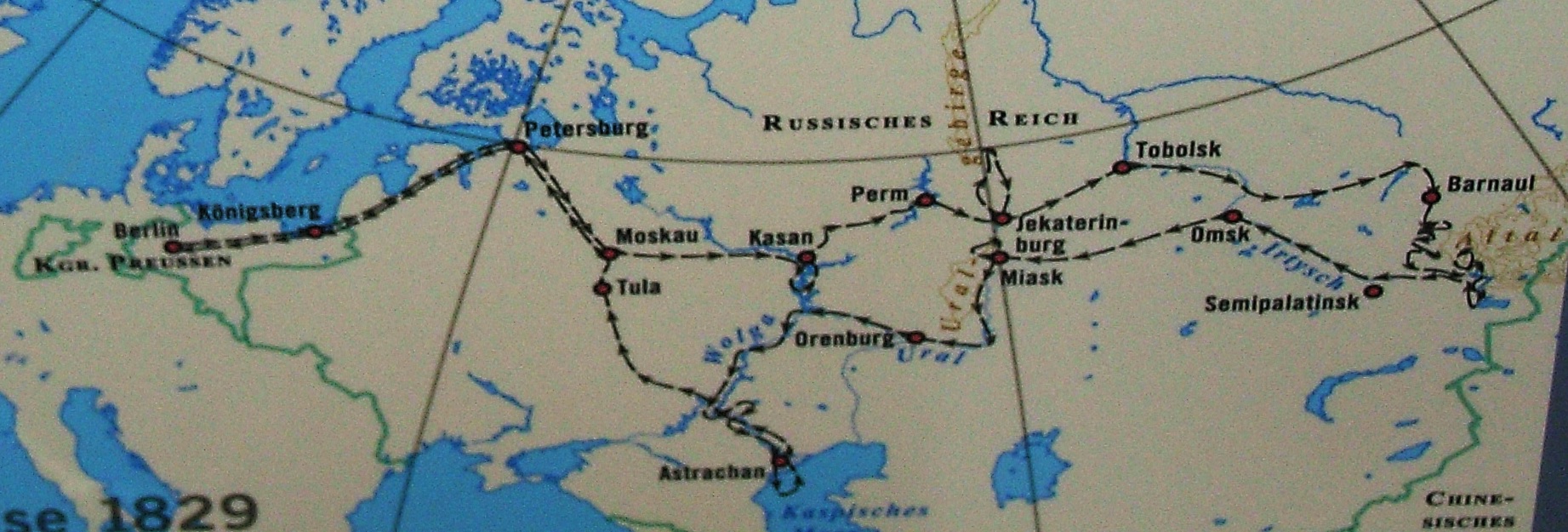 Map of Humboldt's expedition to Russia in 1829 In 1811, and again in 1818, projects of Asiatic exploration were proposed to Humboldt, first by Tsar Nicholas I's Russian government, and afterwards by the Prussian government; but on each occasion, untoward circumstances interposed. It was not until he had begun his sixtieth year that he resumed his early role of traveler in the interests of science. The Russian Finance Minister, Count Georg von Cancrin, contacted Humboldt about whether a platinum-based currency was possible in Russia and invited him to visit the Ural Mountains. Humboldt was not encouraging about a platinum-based currency, when silver was the standard as a world currency. But the invitation to visit the Urals was intriguing, especially since Humboldt had long dreamed of going to Asia. He had wanted to travel to India and made considerable efforts to persuade the British East India Company to authorize a trip, but those efforts were fruitless.[146] When Russia renewed its earlier invitation to Humboldt, he accepted.[147] The Russians sought to entice Humboldt by engaging his enduring interest in mining sites, for comparative scientific purposes for Humboldt, but for the Russians to gain expert knowledge about their resources. For Humboldt, the Russian monarch's promise to fund the trip was extremely important, since Humboldt's inherited 100,000 thaler fortune was gone and he lived on the Prussian government pension of 2,500–3,000 thalers as the monarch's chamberlain. The Russian government gave an advance of 1200 chervontsev in Berlin and another 20,000 when he arrived in Saint Petersburg.[148] Humboldt was eager to travel not just to the Urals, but also across the steppes of Siberia to Russia's border with China. Humboldt wrote Cancrin saying that he intended to learn Russian to read mining journals in the language.[149] As the details of the expedition were worked out, Humboldt said that he would travel to Russia in his own French coach, with a German servant, as well as Gustav Rose, a professor of chemistry and mineralogy. He also invited Christian Gottfried Ehrenberg to join the expedition, to study water micro-organisms in Lake Baikal and the Caspian Sea. Humboldt himself was keen to continue his studies of magnetism of mountains and mineral deposits. As was usual for his research, he brought scientific instruments to take the most accurate measurements.[150] The Russians organized the local arrangements, including lodging, horses, accompanying crew. Humboldt's title for the expedition was as an official of the Department of Mines. As the expedition neared dangerous areas, he had to travel in a convoy with an escort.[148] Physically Humboldt was in good condition, despite his advancing years, writing to Cancrin "I still walk very lightly on foot, nine to ten hours without resting, despite my age and my white hair".[151] 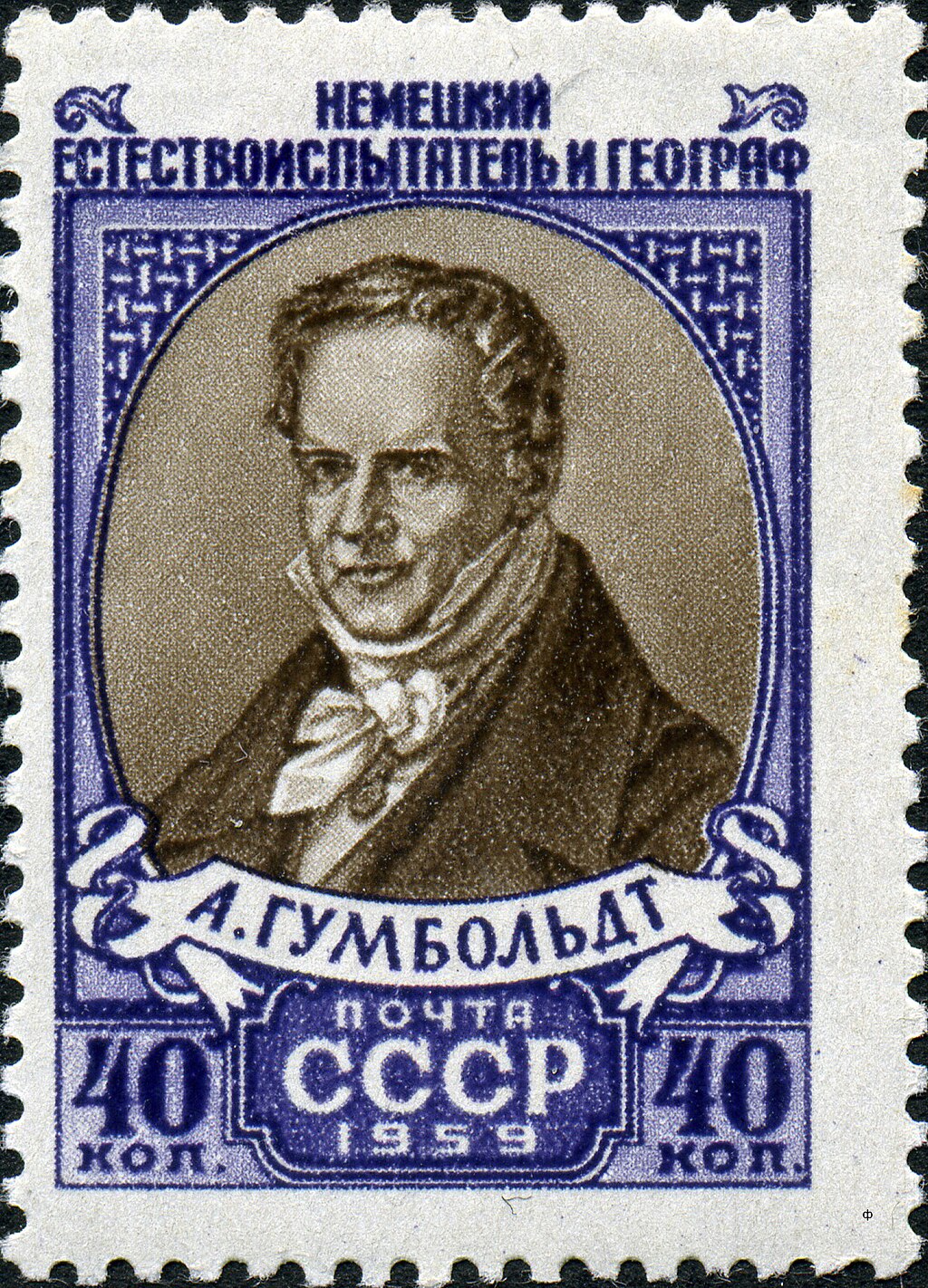 1959 postage stamp from the Soviet Union Between May and November 1829 he and the growing expedition traversed the wide expanse of the Russian empire from the Neva to the Yenisei, accomplishing in twenty-five weeks a distance of 9,614 miles (15,472 km). Humboldt and the expedition party travelled by coach on well maintained roads, with rapid progress being made because of changes of horses at way stations. The party had grown, with Johann Seifert, who was a huntsman and collector of animal specimens; a Russian mining official; Count Adolphe Polier, one of Humboldt's friends from Paris; a cook; plus a contingent of Cossacks for security. Three carriages were filled with people, supplies, and scientific instruments. For Humboldt's magnetic readings to be accurate, they carried an iron-free tent.[152] This expedition was unlike his Spanish American travels with Bonpland, with the two alone and sometimes accompanied by local guides. The Russian government was interested in Humboldt's finding prospects for mining and commercial advancement of the realm and made it clear that Humboldt was not to investigate social issues, nor criticize social conditions of Russian serfs. In his publications on Spanish America, he did comment on the conditions of the indigenous populations, and deplored black slavery, but well after he had left those territories.[153] As Humboldt discovered, the government kept tight control of the expedition, even when it was 1,000 miles (1,600 km) from Moscow, with local government officials greeting the expedition at every stop. The itinerary was planned with Tobolsk the farthest destination, then a return to Saint Petersburg. Humboldt wrote to the Russian Minister Cancrin that he was extending his travel, knowing that the missive would not reach him in time to scuttle the plan. The further east he journeyed into wilder territory, the more Humboldt enjoyed it. They still followed the Siberian Highway and made excellent progress, sometimes a hundred miles (160 km) in a day.[154] Although they were halted at the end of July and warned of an anthrax outbreak, Humboldt decided to continue despite the danger. "At my age, nothing should be postponed".[155] The journey though carried out with all the advantages afforded by the immediate patronage of the Russian government, was too rapid to be profitable scientifically. The correction of the prevalent exaggerated estimate of the height of the Central Asian plateau, and the prediction of the discovery of diamonds in the gold-washings of the Urals, were important aspects of these travels. In the end, the expedition took 8 months, travelled 15,500 km, stopped at 658 post stations, and used 12,244 horses.[156] One writer claims that "Nothing was quite as Humboldt wanted it. The entire expedition was a compromise."[157] The Russian emperor offered Humboldt an invitation to return to Russia, but Humboldt declined, due to his disapproval of Nicholas's restrictions on his freedom of movement during the expedition and his ability to freely report on it.[158] Humboldt published two works on the Russian expedition, first Fragments de géologie et de climatologie asiatiques in 1831, based on lectures he gave on the topic. In 1843, he completed the three-volume Asie Centrale,[159] which he dedicated to Tsar Nicholas, which he called "an unavoidable step, as the expedition was accomplished at his expense".[160] As of 2016, these works have not been translated to English.[161] His 1829 expedition to Russia when he was an old man is much less known than his five-year travels in Spanish America, which had resulted in many published volumes over the decades since his 1804 r |
ロシア遠征、1829年 1829年フンボルトのロシア遠征地図 1811年、そして1818年にも、アジア探検計画がフンボルトに提案された。最初は皇帝ニコライ1世のロシア政府から、その後プロイセン政府からであっ た。しかしその度に、不都合な事情が介入した。彼が科学の利益のために旅人としての初期の役割を再開したのは、60歳を迎えてからであった。 ロシア財務大臣ゲオルク・フォン・カンクリン伯爵は、ロシアにおけるプラチナ通貨の可能性についてフンボルトに問い合わせ、ウラル山脈訪問を招待した。世 界通貨として銀が標準だった当時、フンボルトはプラチナ通貨に前向きではなかった。しかしウラル訪問の招待は興味深いものだった。特にフンボルトが長年ア ジア行きを夢見ていたからだ。彼はインドへの渡航を望み、イギリス東インド会社に旅行許可を得るよう相当な努力を重ねたが、その努力は実を結ばなかった。 [146] ロシアがフンボルトへの以前の招待を再提示した際、彼はこれを受け入れた。[147] ロシア側は、フンボルトの鉱山地帯への持続的な関心を誘引材料とした。フンボルトにとっては比較科学研究の目的であったが、ロシア側にとっては自国の資源 に関する専門知識を得るためであった。フンボルトにとって、ロシア皇帝が旅費を負担すると約束したことは極めて重要だった。なぜなら、彼が相続した10万 ターラーの財産は尽き、プロイセン政府から宮廷侍従として支給される年2500~3000ターラーの年金で生活していたからだ。ロシア政府はベルリンで 1200チェルヴォンツェフを前払いし、サンクトペテルブルク到着時にさらに2万を支給した[148]。 フンボルトはウラル山脈だけでなく、シベリアの草原を越えてロシアと中国の国境まで旅することを熱望していた。彼はカンスリン宛ての手紙で、鉱業雑誌を読 むためにロシア語を習得するつもりだと記している。[149] 遠征の詳細が決まるにつれ、フンボルトは自身のフランス製馬車とドイツ人従者、さらに化学・鉱物学教授グスタフ・ローゼを伴ってロシアへ向かうと述べた。 またクリスティアン・ゴットフリート・エーレンベルクを遠征に招き、バイカル湖とカスピ海の水生微生物を研究させる計画も立てた。フンボルト自身は山岳と 鉱床の磁気研究を継続することに強い意欲を持っていた。彼の研究では常として、最も正確な測定を行うための科学機器を持参した。[150] ロシア側は宿泊施設、馬、随行要員を含む現地手配を組織した。フンボルトの遠征における肩書は鉱山省の役人であった。遠征が危険地域に近づくにつれ、護衛 付きの護送隊で移動せざるを得なかった。[148] フンボルトは高齢にもかかわらず体調は良好で、カンクリン宛ての手紙に「白髪混じりの老齢にもかかわらず、今も9~10時間休みなく軽やかに歩き回っている」と記している。[151]  1959年ソビエト連邦発行切手 1829年5月から11月にかけ、拡大を続ける探検隊はネヴァ川からエニセイ川までロシア帝国の広大な領域を横断し、25週間で9,614マイル (15,472キロメートル)の距離を移動した。フンボルトと隊員たちは整備された道路を馬車で移動し、中継地点での馬の交換により迅速な進捗が実現され た。一行はさらに増員され、狩猟師兼動物標本収集家のヨハン・ザイフェルト、ロシアの鉱山官吏、パリ時代の友人アドルフ・ポリエ伯爵、調理人、そして警備 のためのコサック部隊が加わった。三台の馬車には人員、物資、科学機器が詰め込まれた。フンボルトの磁気測定を正確に行うため、鉄分を含まないテントが携 行された[152]。この探検は、ボンプランと二人きりで現地ガイドを伴うこともあったスペイン領アメリカでの旅とは異なっていた。ロシア政府は、フンボ ルトが鉱業や国家の商業発展の可能性を探ることに興味を示し、社会問題の調査やロシア農奴の社会状況への批判は禁じることを明確にした。スペイン領アメリ カに関する著作では、先住民の生活状況について言及し、黒人奴隷制を嘆いたが、それは現地を離れた後のことだった[153]。フンボルトが知ったように、 政府は遠征隊を厳しく管理しており、モスクワから1,000マイル(1,600km)離れた地点でも、各停留地で地方政府の役人が出迎えた。旅程はトボリ スクを最遠の目的地とし、その後サンクトペテルブルクへ戻る計画だった。 フンボルトはロシアのカンクリン大臣に旅行延長の書簡を送った。その書簡が計画を阻止できる時期に届くことはないと承知の上での行動だった。東へ進むほど 荒れ地が広がるが、フンボルトはその旅路をますます楽しんだ。一行は依然としてシベリア街道を進み、1日に100マイル(160キロ)も進むなど順調だっ た[154]。7月末に炭疽菌の発生を警告され進路を阻まれたが、フンボルトは危険を顧みず継続を決断した。「この年頃になって、何も先延ばしにするべき ではない」と。[155] この旅はロシア政府の直接的な後援によるあらゆる利点を享受して行われたものの、科学的に有益と言えるほど十分な時間をかけてはいなかった。中央アジア高 原の標高に関する従来の過大評価の修正、ウラル山脈の砂金採掘地におけるダイヤモンド発見の予測は、この旅の重要な成果であった。結局、遠征は8か月を要 し、15,500キロメートルを移動、658の駅舎に滞在し、12,244頭の馬を使用した。[156] ある著者は「フンボルトの望む通りには何も進まなかった。遠征全体が妥協の産物だった」と述べている[157]。ロシア皇帝はフンボルトに再訪を要請した が、皇帝が遠征中の移動の自由と報告の自由を制限したことに不満を抱いたフンボルトはこれを断った。[158] フンボルトはロシア遠征に関する著作を2点出版した。最初の『アジアの地質学と気候学の断片』は1831年、彼がこの主題について行った講義を基にしてい る。1843年には3巻からなる『中央アジア』[159]を完成させ、皇帝ニコライに献呈した。彼はこれを「遠征が彼の費用で行われた以上、避けられない 措置」と呼んだ。[160] 2016年現在、これらの著作は英語に翻訳されていない。[161] 老齢期の1829年のロシア遠征は、1804年の南米探検から数十年にわたり出版された多くの著作を生んだ5年間の南米旅行に比べ、はるかに知られていな い。 |
| Works Cosmos See also: Cosmos (Humboldt book) 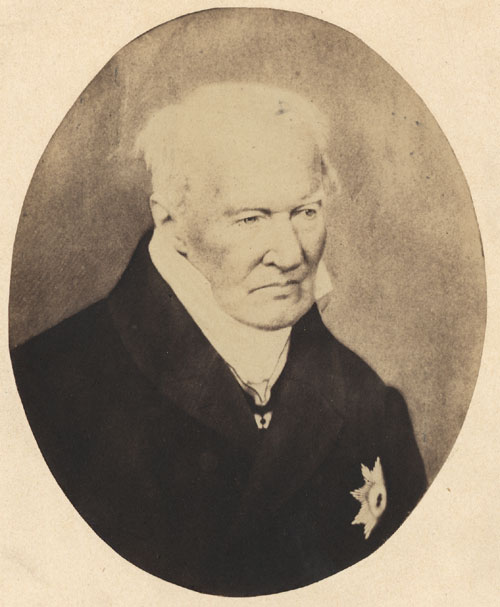 Photograph of Humboldt in his later years Kosmos was Humboldt's multi-volume effort in his later years to write a work bringing together all the research from his long career. The writing took shape in lectures he delivered before the University of Berlin in the winter of 1827–28. These lectures would form "the cartoon for the great fresco of the [K]osmos".[162] His 1829 expedition to Russia supplied him with data comparative to his Latin American expedition.[163] The first two volumes of the Kosmos were published between the years 1845 and 1847 and were intended to comprise the entire work, but Humboldt published three more volumes, one of which was posthumous. Humboldt had long aimed to write a comprehensive work about geography and the natural sciences. The work attempted to unify the sciences then known in a Kantian framework. With inspiration from German Romanticism, Humboldt sought to create a compendium of the world's environment.[14] He spent the last decade of his long life—as he called them, his "improbable" years—continuing this work. The third and fourth volumes were published in 1850–58; a fragment of a fifth appeared posthumously in 1862. His reputation had long since been made with his publications on the Spanish American expedition. There is not a consensus on the importance of Kosmos. One scholar, who stresses the importance of Humboldt's Political Essay on the Kingdom of New Spain as essential reading, dismisses Kosmos as "little more than an academic curiosity".[164] A different opinion is that Kosmos was his "most influential book".[163] 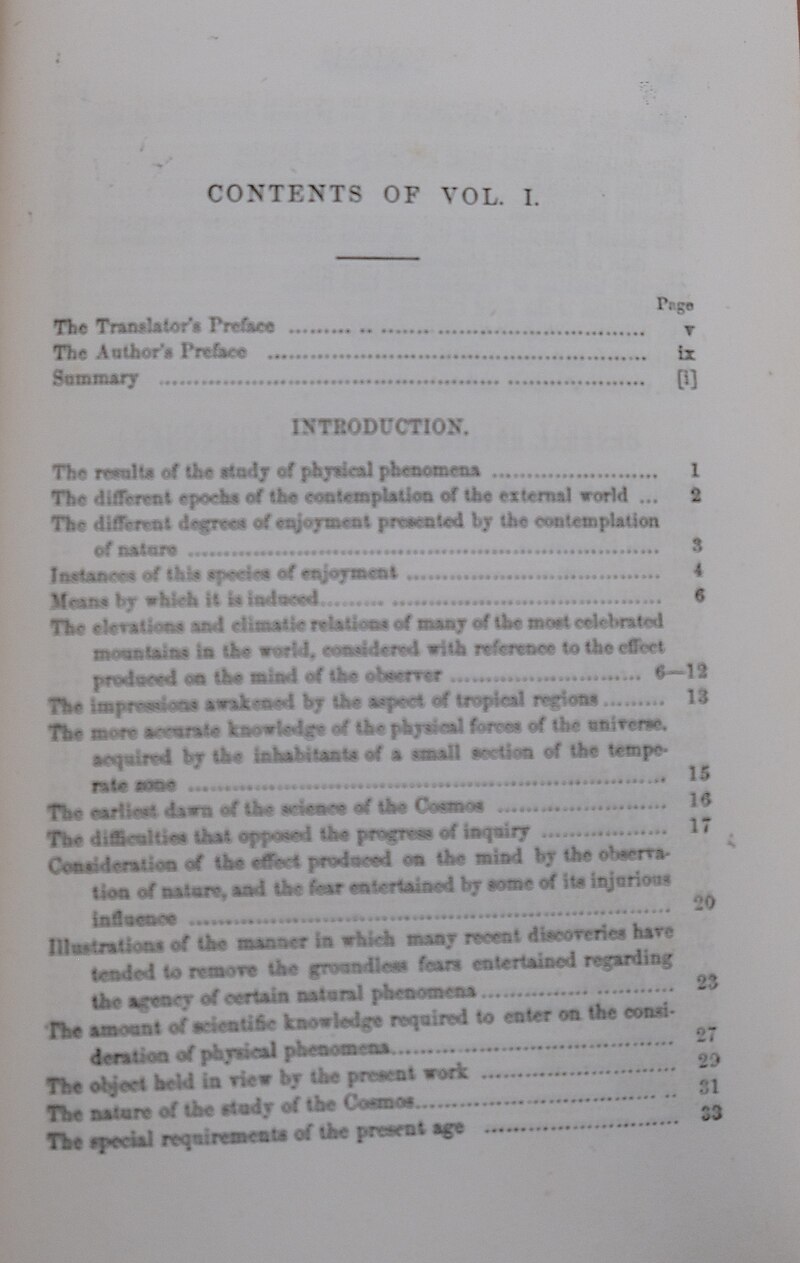 First page of the table of contents to volume 1 of "Cosmos," translated by Elise Otté (1849) First page of the table of contents to volume 1 of "Cosmos," translated by Elise Otté (1849) As with most of Humboldt's works, Kosmos was also translated into multiple languages in editions of uneven quality. It was very popular in Britain and America. In 1849 a German newspaper commented that in England two of the three different translations were made by women, "while in Germany most of the men do not understand it".[165] The first translation by Augustin Pritchard—published anonymously by Mr. Baillière (volume I in 1845 and volume II in 1848)—suffered from being hurriedly made. In a letter Humboldt said of it: "It will damage my reputation. All the charm of my description is destroyed by an English sounding like Sanskrit."[citation needed] The other two translations were made by Elizabeth Juliana Leeves Sabine under the superintendence of her husband Col. Edward Sabine (4 volumes 1846–1858), and by Elise Otté (5 volumes 1849–1858, the only complete translation of the 4 German volumes). These three translations were also published in the United States. The numbering of the volumes differs between the German and the English editions. Volume 3 of the German edition corresponds to the volumes 3 and 4 of the English translation, as the German volume appeared in 2 parts in 1850 and 1851. Volume 5 of the German edition was not translated until 1981, again by a woman.[166] Otté's translation benefited from a detailed table of contents, and an index for every volume; of the German edition only volumes 4 and 5 had (extremely short) tables of contents, and the index to the whole work only appeared with volume 5 in 1862. Less well known in Germany is the atlas belonging to the German edition of the Cosmos "Berghaus' Physikalischer Atlas", better known as the pirated version by Traugott Bromme under the title "Atlas zu Alexander von Humboldt's Kosmos" (Stuttgart 1861).[citation needed] In Britain, Heinrich Berghaus planned to publish together with Alexander Keith Johnston a "Physical Atlas". But later Johnston published it alone under the title "The Physical Atlas of Natural Phenomena". In Britain its connection to the Cosmos seems not have been recognized.[167] |
著作 コスモス 関連項目: コスモス (フンボルトの著作)  晩年のフンボルトの写真 コスモスは、フンボルトが晩年に取り組んだ多巻にわたる著作であり、長年の研究の成果を総括するものであった。この著作は、1827年から1828年の冬 にかけてベルリン大学で行った講義を基に形作られた。これらの講義は「[K]osmosという巨大なフレスコ画の下絵」となるはずだった[162]。 1829年のロシア遠征は、ラテンアメリカ遠征と比較可能なデータを提供した[163]。 『コスモス』の最初の2巻は1845年から1847年の間に刊行され、全巻を網羅する予定であったが、フンボルトはさらに3巻を刊行し、うち1巻は死後出 版された。フンボルトはかねてより地理学と自然科学に関する包括的な著作を執筆することを目指していた。この著作は、当時知られていた科学をカント的な枠 組みで統合しようとする試みであった。ドイツ・ロマン主義に触発され、フンボルトは世界の環境に関する大要の編纂を目指した[14]。彼は長寿の生涯の最 後の10年——自らが「ありえない年」と呼んだ時期——をこの作業に費やした。第3巻と第4巻は1850年から58年に刊行され、第5巻の一部は1862 年に遺稿として出版された。 彼の評判は、スペイン領アメリカ探検に関する著作によってとっくに確立されていた。『コスモス』の重要性については意見が分かれている。『新スペイン王国 に関する政治論考』を必読の書として重要視するある学者は、『コスモス』を「学術的な珍品に過ぎない」と一蹴している[164]。一方で『コスモス』こそ が彼の「最も影響力のある著作」だったとする見解もある[163]。  『コスモス』第1巻目次表の初版(エリゼ・オッテ訳、1849年) 『コスモス』第1巻目次表の初版(エリゼ・オッテ訳、1849年) フンボルトの他の著作と同様、「コスモス」も複数の言語に翻訳されたが、その品質はまちまちであった。英国と米国では非常に人気があった。1849年、ド イツの新聞は、英国では3つの翻訳のうち2つが女性によって行われているのに対し、「ドイツではほとんどの男性が理解していない」と報じている。 [165] オーガスティン・プリッチャードによる最初の翻訳(1845年に第1巻、1848年に第2巻がベイリエール社から匿名で出版)は、急いで作成されたため質 が劣っていた。フンボルトは手紙の中で、この翻訳について「私の評判を傷つけるだろう。私の記述の魅力をすべて、サンスクリット語のように聞こえる英語が 台無しにしている」と述べている。[要出典] 他の 2 つの翻訳は、エリザベス・ジュリアナ・リーヴス・サバインが夫のエドワード・サバイン大佐の監督のもとで(1846 年から 1858 年にかけて 4 巻)、そしてエリーゼ・オッテが(1849 年から 1858 年にかけて 5 巻、4 巻のドイツ語版を完全に翻訳した唯一の翻訳)行った。これら 3 つの翻訳も米国で出版された。巻の番号は、ドイツ語版と英語版で異なっている。ドイツ語版の巻3は、英語訳の巻3と巻4に対応する。ドイツ語版は1850 年と1851年に2部構成で刊行されたためである。ドイツ語版の 5 巻は、1981 年になってようやく、再び女性によって翻訳された。オッテの翻訳は、詳細な目次と全巻の索引が役立った。ドイツ語版では 4 巻と 5 巻にのみ(非常に短い)目次があり、全巻の索引は 1862 年の 5 巻で初めて掲載された。ドイツではあまり知られていないが、ドイツ語版『コスモス』に付属するアトラス「ベルクハウスの物理アトラス」は、トラウゴット・ ブロムによる海賊版「アレクサンダー・フォン・フンボルトのコスモスに関するアトラス」(シュトゥットガルト、1861年)としてよく知られている。 英国では、ハインリッヒ・ベルクハウスがアレクサンダー・キース・ジョンストンと共同で「物理アトラス」を出版する計画を立てていた。しかし、後にジョン ストンは「自然現象の物理アトラス」というタイトルで単独で出版した。英国では、このアトラスが『コスモス』と関連があることは認識されていなかったよう だ。 |
Other publications Muisca numerals as noted by Humboldt Alexander von Humboldt published prolifically throughout his life. Many works were published originally in French or German, then translated to other languages, sometimes with competing translation editions. Humboldt himself did not keep track of all the various editions.[168] He wrote specialized works on particular topics of botany, zoology, astronomy, mineralogy, among others, but he also wrote general works that attracted a wide readership, especially his Personal Narrative of Travels to the Equinoctial Regions of the New Continent during the years 1799–1804.[169] His Political Essay on the Kingdom of New Spain was widely read in Mexico itself, the United States, as well as in Europe.[170] Many of the original works have been digitally scanned by the Biodiversity Heritage Library.[171] There have been new editions of print works, including his Views of the Cordilleras and Monuments of the Indigenous Peoples of the Americas (2014), which includes reproductions of all the color and black and white plates. In the original edition, the publication was in a large format and quite expensive.[172] There is a 2009 translation of his Geography of Plants[173] and a 2014 English edition of Views of Nature.[174] |
その他の出版物 フンボルトが記したムイスカ数字 アレクサンダー・フォン・フンボルトは生涯を通じて多作だった。多くの著作は、もともとフランス語やドイツ語で出版され、その後他の言語に翻訳された。時 には、競合する翻訳版も出版された。フンボルト自身は、さまざまな版をすべて把握していたわけではない[168]。彼は、植物学、動物学、天文学、鉱物学 などの特定のテーマに関する専門書を執筆したが、幅広い読者層を集めた一般書も執筆した。特に、1799年から1804年にかけての新大陸の赤道地域への 旅の個人的な記録は、メキシコ国内はもちろん、米国やヨーロッパでも広く読まれた[170]。[169] 彼の『新スペイン王国に関する政治論考』は、メキシコ国内はもちろん、アメリカ合衆国やヨーロッパでも広く読まれた。[170] 原典の多くは生物多様性遺産図書館によってデジタル化されている。[171] 印刷物の新版も刊行されており、例えば『アメリカ大陸のコルディエラ山脈と先住民遺跡図譜』(2014年)には全カラー図版・白黒図版の複製が収録されて いる。初版は大型判で非常に高価であった[172]。2009年には『植物地理学』の英訳版[173]が、2014年には『自然の景観』の英語版 [174]が刊行されている。 |
Influence on scientists and artists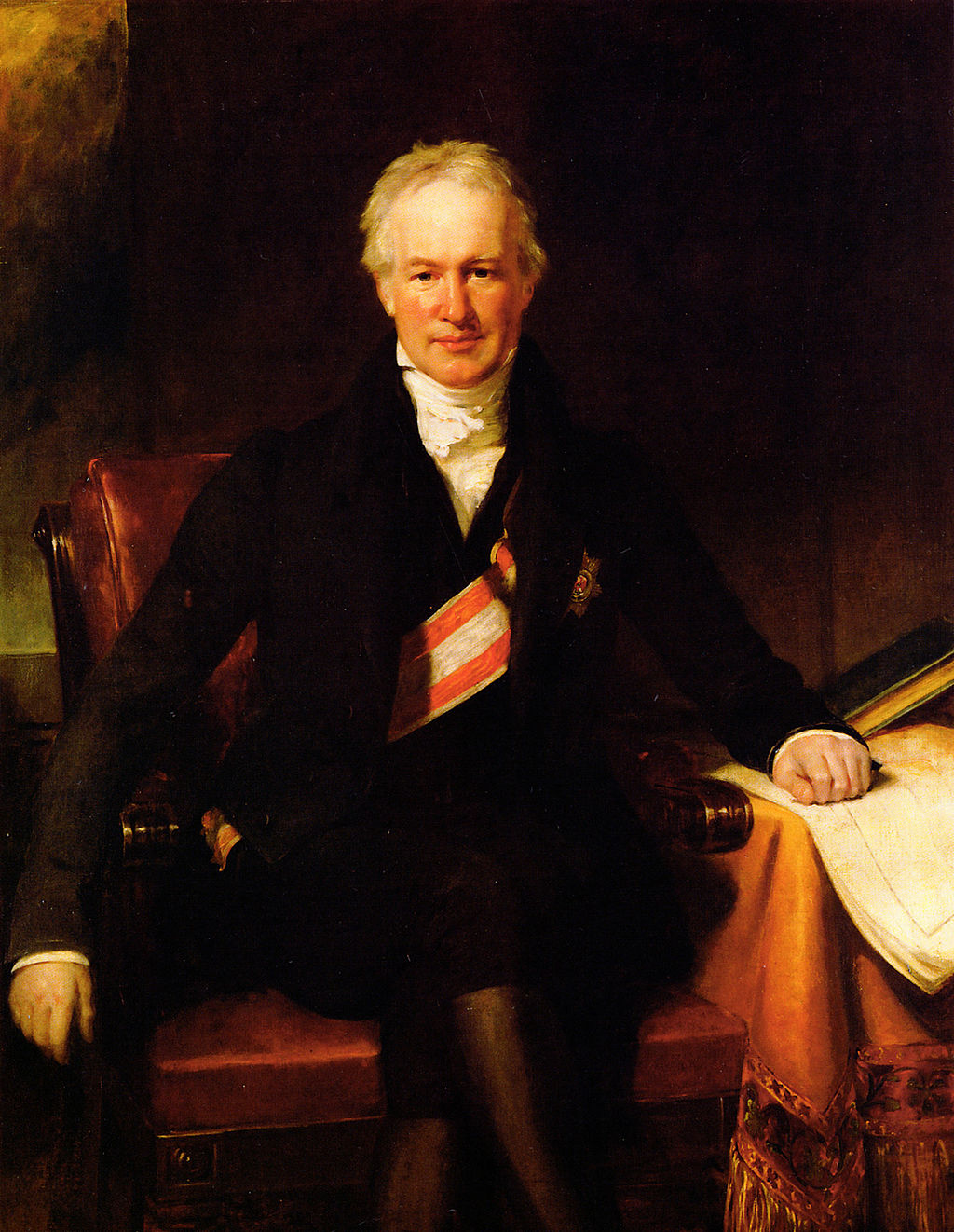 Humboldt, portrait by Henry William Pickersgill (1831) Humboldt was generous toward his friends and mentored young scientists. He and Bonpland parted ways after their return to Europe, and Humboldt largely took on the task of publishing the results of their Latin American expedition at Humboldt's expense, but he included Bonpland as co-author on the nearly 30 published volumes. Bonpland returned to Latin America, settling in Buenos Aires, Argentina, then moved to the countryside near the border with Paraguay. The forces of Dr. José Gaspar Rodríguez de Francia, the strong man of Paraguay, abducted Bonpland after killing Bonpland's estate workers. Bonpland was accused of "agricultural espionage" and of threatening Paraguay's virtual monopoly on the cultivation of yerba mate. Despite international pressure, including the British government and Simón Bolívar's, along with European scientists including Humboldt, Francia kept Bonpland prisoner until 1831. He was released after nearly 10 years in Paraguay. Humboldt and Bonpland maintained a warm correspondence about science and politics until Bonpland's death in 1858.[175] During Humboldt's time in Paris, he met in 1818 the young and brilliant Peruvian student of the Royal Mining School of Paris, Mariano Eduardo de Rivero y Ustariz. Subsequently, Humboldt acted as a mentor of the career of this promising Peruvian scientist. Another recipient of Humboldt's aid was Louis Agassiz (1807–1873), who was directly aided with needed cash from Humboldt, assistance in securing an academic position, and help with getting his research on zoology published. Agassiz sent him copies of his publications and went on to gain considerable scientific recognition as a professor at Harvard.[176] Agassiz delivered an address to the Boston Society of Natural History in 1869, on the centenary of his patron's birth.[177] When Humboldt was an elderly man, he aided another young scholar, Gotthold Eisenstein, a brilliant, young, Jewish mathematician in Berlin, for whom he obtained a small crown pension and whom he nominated for the Academy of Science.[178] Humboldt's popular writings inspired many scientists and naturalists, including Charles Darwin, Henry David Thoreau, John Muir, George Perkins Marsh, Ernst Haeckel,[179] Ida Laura Pfeiffer[180] as well as brothers Richard and Robert Schomburgk[181] and Robert, Adolf, and Hermann Schlagintweit.[182] Humboldt carried on correspondence with many contemporaries and two volumes of letters to Karl August Varnhagen von Ense have been published.[183][184] Charles Darwin made frequent reference to Humboldt's work in his Voyage of the Beagle, where Darwin described his own scientific exploration of the Americas. In one note, he placed Humboldt first on the "list of American travellers".[185] Darwin's work was influenced by Humboldt's writing style as well. Darwin's sister remarked to him "you had, probably from reading so much of Humboldt, got his phraseology and the kind of flowery French expressions he uses".[186] When Darwin's Journal was published, he sent a copy to Humboldt, who responded, "You told me in your kind letter that, when you were young, the manner in which I studied and depicted nature in the torrid zones contributed toward exciting in you the ardour and desire to travel in distant lands. Considering the importance of your work, Sir, this may be the greatest success that my humble work could bring."[187] In his autobiography, Darwin recalled, reading "with care and profound interest Humboldt's Personal Narrative" and finding it one of the two most influential books on his work, which stirred in him "a burning zeal to add even the most humble contribution to the noble structure of Natural Science".[188] Humboldt would later reveal to Darwin in the 1840s that he had been deeply interested in Darwin's grandfather's poetry. Erasmus Darwin had published the poem The Loves of the Plants in the early 1800s. Humboldt praised the poem for combining nature and imagination, a theme that permeated Humboldt's own work.[189] 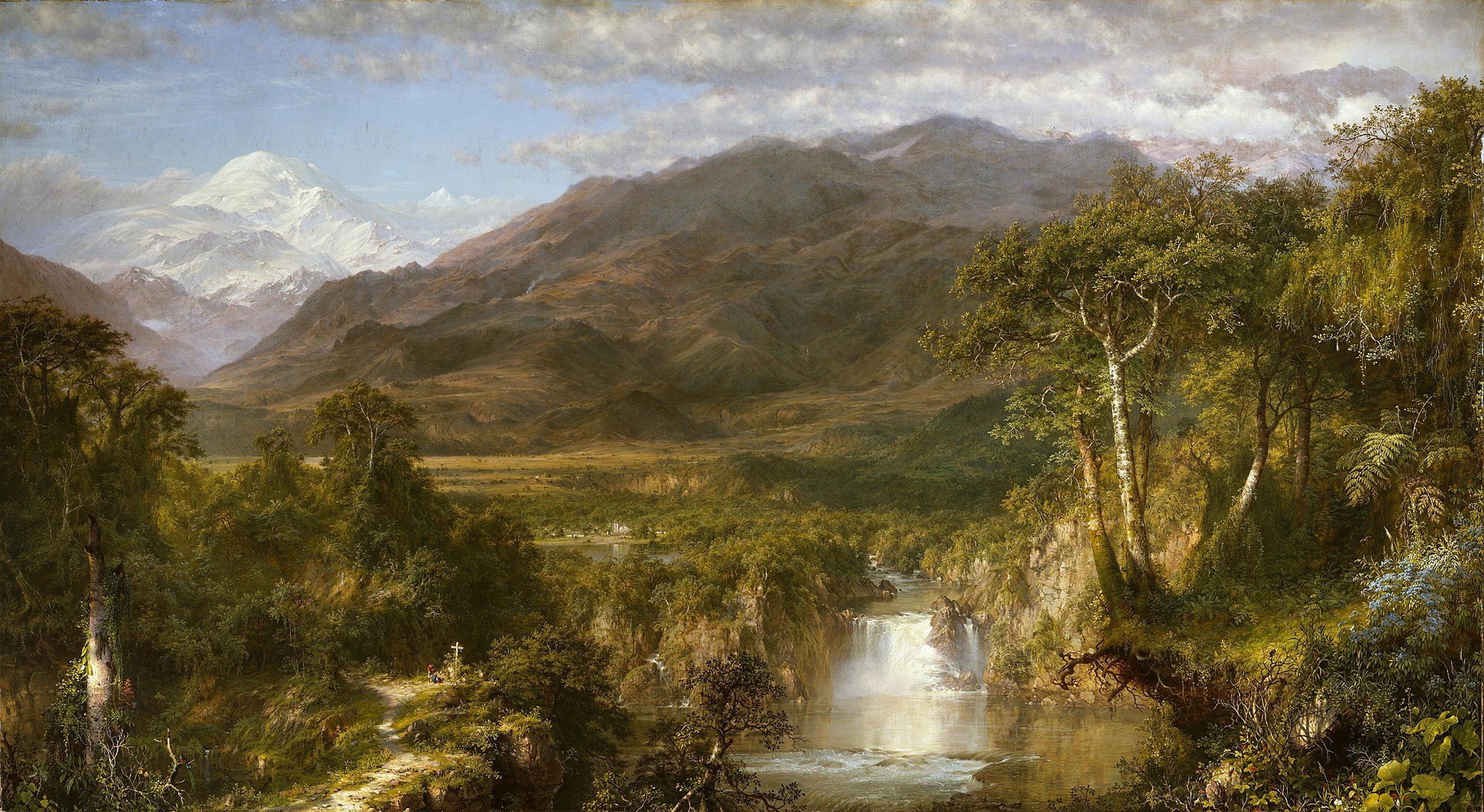 Frederic Edwin Church, The Heart of the Andes (1859) A number of nineteenth-century artists travelled to Latin America, following in the footsteps of Humboldt, painting landscapes and scenes of everyday life. Johann Moritz Rugendas, Ferdinand Bellermann, and Eduard Hildebrandt were three important European painters.[190] Frederic Edwin Church was the most famous landscape painter in the U.S. in the nineteenth century. His paintings of Andean volcanoes that Humboldt climbed helped make Church's reputation. His 5 foot by 10 foot painting entitled The Heart of the Andes "caused a sensation" when it was completed. Church had hoped to ship the painting to Berlin to show the painting to Humboldt, but Humboldt died a few days after Church's letter was written.[191][192][193][194] Church painted Cotopaxi three times, twice in 1855 and then in 1859 in eruption. George Catlin, most famous for his portraits of North American Indians and paintings of life among various North American tribes, also travelled to South America, producing a number of paintings. He wrote to Humboldt in 1855, sending him his proposal for South American travels. Humboldt replied, thanking him and sending a memorandum helping guide his travels.[195][196] Ida Laura Pfeiffer, one of the first female travelers who completed two trips around the world from 1846 to 1855, followed in Humboldt's footsteps. The two explorers met in Berlin in 1851 before Pfeiffer's second tour and again in 1855 when she returned to Europe. Humboldt provided Pfeiffer with an open letter of introduction in which he bade anyone who knew of his name to assist Madame Pfeiffer for her "inextinguishable energy of character which she has everywhere shown, to wheresoever's she has been called or better put, driven by her unconquerable passion to study nature and man."[197] |
科学者や芸術家への影響 フンボルト、ヘンリー・ウィリアム・ピッカースギルによる肖像画(1831年) フンボルトは友人に対して寛大であり、若い科学者たちを指導した。彼とボンプランはヨーロッパ帰還後に別々の道を歩み、フンボルトは自らの費用でラテンア メリカ探検の成果を出版する任務を主に引き受けたが、出版された約30巻の著作にはボンプランを共著者として名を連ねさせた。ボンプランはラテンアメリカ に戻り、アルゼンチンのブエノスアイレスに定住した後、パラグアイ国境近くの田舎へ移った。パラグアイの実力者ホセ・ガスパール・ロドリゲス・デ・フラン シア博士の軍勢は、ボンプランの農園労働者を殺害した後、ボンプランを拉致した。ボンプランは「農業スパイ行為」と、マテ茶栽培におけるパラグアイの事実 上の独占を脅かす行為で告発された。 イギリス政府やシモン・ボリバル、フンボルトを含む欧州の科学者らによる国際的な圧力にもかかわらず、フランシアは1831年までボンプランを囚人として 拘束した。パラグアイでの約10年間の拘束後、彼は解放された。フンボルトとボンプランは、1858年にボンプランが亡くなるまで、科学と政治について温 かい文通を続けた。[175] フンボルトがパリに滞在中、1818年にパリ王立鉱山学校の若き優秀なペルー人学生、マリアーノ・エドゥアルド・デ・リベロ・イ・ウスタリスと出会った。 その後フンボルトは、この有望なペルー人科学者のキャリアにおいて指導的役割を果たした。フンボルトの支援を受けたもう一人の人物はルイ・アガシ (1807–1873)である。フンボルトはアガシに直接必要な資金を提供し、学職の確保を支援し、動物学研究の出版を手助けした。アガシは自身の出版物 の写しをフンボルトに送り、ハーバード大学の教授としてかなりの科学的評価を得るに至った。[176] アガシズは、1869年、彼の恩人の生誕100周年を記念して、ボストン自然史協会で演説を行った。[177] フンボルトは、高齢になった後も、ベルリンに住む、若くて優秀なユダヤ人数学者、ゴットホルト・アイゼンシュタインという別の若い学者を支援し、彼のため に少額の年金を得させ、科学アカデミーの候補者に指名した。[178] フンボルトの一般向け著作は、チャールズ・ダーウィン、ヘンリー・デイヴィッド・ソロー、ジョン・ミューア、ジョージ・パーキンズ・マーシュ、エルンス ト・ヘッケル[179]、アイダ・ローラ・ファイファー[180]、リヒャルトとロベルト・ショーンブルク兄弟[181]、ロベルト、アドルフ、ヘルマ ン・シュラギントヴァイトなど、多くの科学者や自然学者に影響を与えた。[182] フンボルトは多くの同時代人と文通を行い、カール・アウグスト・ファルナゲン・フォン・エンゼへの手紙は 2 巻にまとめられて出版されている。[183][184] チャールズ・ダーウィンは、自身のアメリカ大陸の科学探検について記した『ビーグル号航海記』の中で、フンボルトの著作を頻繁に引用している。ある注記で は、ダーウィンはフンボルトを「アメリカ旅行者リスト」の筆頭に置いている[185]。ダーウィンの著作はフンボルトの文体にも影響を受けていた。ダー ウィンの姉は彼にこう指摘している。「おそらくフンボルトを多く読んだせいで、彼の表現様式や華やかなフランス語表現を身につけてしまったのだろう」と。 [186] ダーウィンの『日記』が出版された際、彼はその写しをフンボルトに送った。フンボルトはこう返答した。「貴殿の親切な手紙に記されていたように、貴殿が若 き日に、私が熱帯地域で自然を研究し描写した手法が、貴殿に遠方の地へ旅する熱意と願望を喚起する一助となったとのことだ。あなたの業績の重要性を考えれ ば、私のささやかな著作がもたらし得た最大の成功と言えるでしょう」と返答した。[187] 自伝の中でダーウィンは、フンボルトの『自然誌』を「注意深く深い興味を持って読み」、自身の研究に最も影響を与えた二冊の書籍の一つであり、自然科学と いう崇高な構造に「たとえささやかな貢献であっても加えたいという燃えるような熱意」を呼び起こしたと回想している。[188] フンボルトは後に1840年代、ダーウィンに自身の祖父の詩作に強い関心を抱いていたことを明かした。エラスムス・ダーウィンは1800年代初頭に詩集 『植物の愛』を出版していた。フンボルトはこの詩を、自然と想像力を融合させた点で称賛した。このテーマはフンボルト自身の著作全体に浸透していたのであ る。[189]  フレデリック・エドウィン・チャーチ『アンデスの心臓』(1859年) 19世紀には多くの芸術家がフンボルトの足跡を辿り、ラテンアメリカを訪れて風景や日常生活の情景を描いた。ヨハン・モーリッツ・ルゲンダス、フェルディ ナント・ベラーマン、エドゥアルト・ヒルデブラントは、ヨーロッパを代表する三人の画家であった。[190] フレデリック・エドウィン・チャーチは19世紀アメリカで最も著名な風景画家だった。フンボルトが登頂したアンデス火山を描いた彼の作品は、チャーチの評 判を確立するのに貢献した。5フィート×10フィートの作品『アンデスの心臓』は完成時に「センセーションを巻き起こした」。チャーチはこの絵をベルリン に送りフンボルトに見せたいと考えていたが、フンボルトはチャーチの手紙が書かれた数日後に亡くなった。チャーチはコトパクシ火山を三度描いた。1855 年に二度、そして1859年には噴火中の姿を描いた。 ジョージ・カトリンは、北米インディアンの肖像画や様々な北米部族の生活を描いた絵画で最も有名だが、南米にも旅し、数多くの絵画を制作した。彼は 1855年にフンボルトに手紙を書き、南米旅行の提案を送った。フンボルトは返事を書き、感謝の意を伝え、彼の旅行の指針となる覚書を送った。[195] [196] 1846年から1855年にかけて2度の世界周遊を成し遂げた初期の女性旅行家の一人、イーダ・ローラ・ファイファーはフンボルトの足跡を辿った。二人は 1851年、ファイファーの二度目の周遊前にベルリンで出会い、1855年に彼女がヨーロッパに戻った際にも再会している。フンボルトはファイファーに紹 介状を書き送った。その中で彼は、自分の名を知っている者なら誰でも、ファイファー夫人を支援するよう呼びかけた。その理由は「彼女がどこへ行っても示し てきた、消えることのない性格のエネルギー」であり、「彼女が呼ばれた場所、より正確に言えば、自然や人間を研究するという彼女の征服されざる情熱に駆り 立てられて行った場所」のためであった[197]。 |
Gallery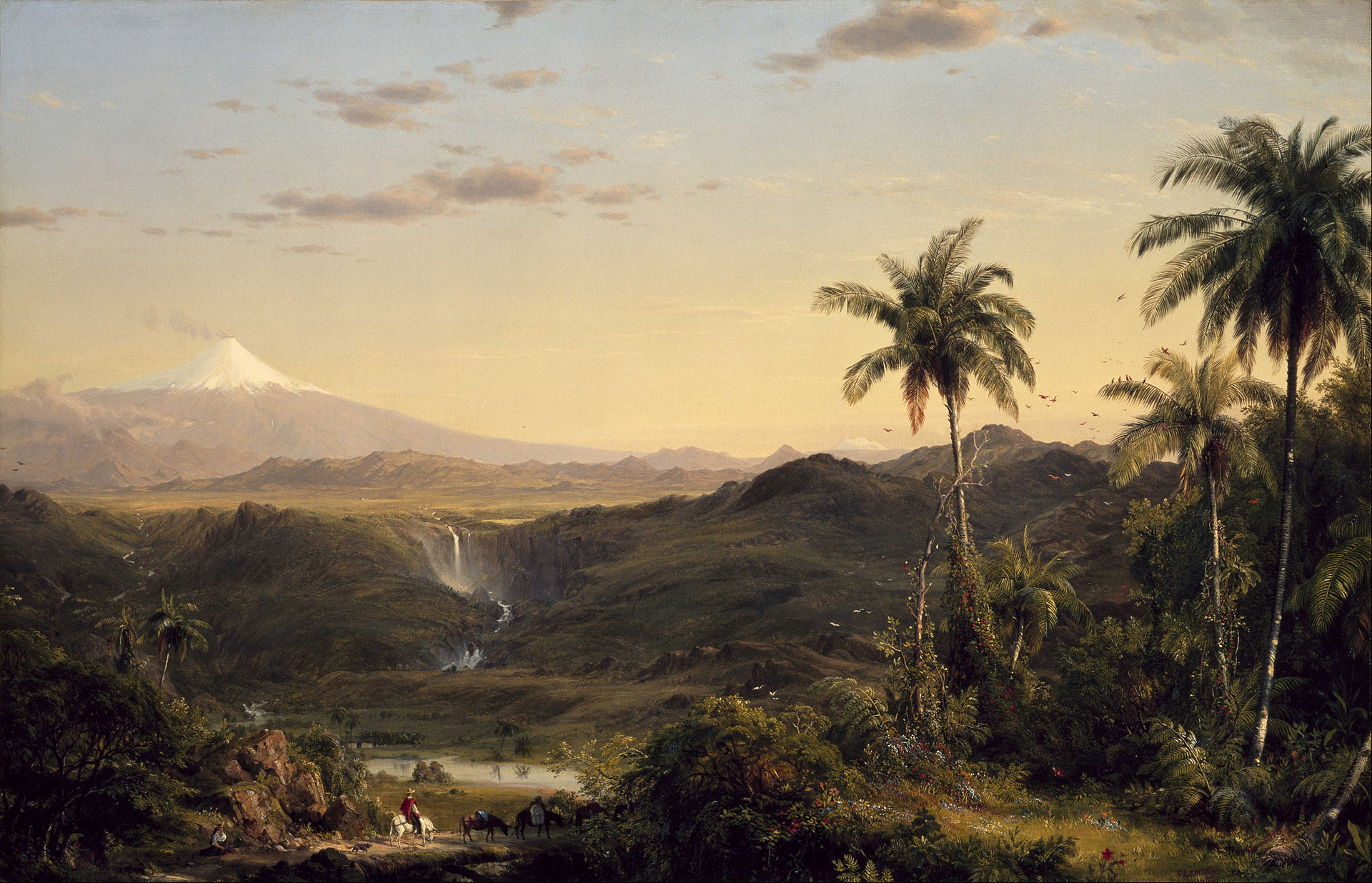 Frederic Edwin Church, Cotopaxi (1855) |
ギャラリー(省略) Frederic Edwin Church, Cotopaxi (1855) |
| Other aspects of Humboldt's life and career Humboldt and the Prussian monarchy In the Napoleonic wars, Prussia had capitulated to France, signing the Treaty of Tilsit. The Prussian royal family returned to Berlin, but sought better terms of the treaty and Friedrich Wilhelm III commissioned his younger brother Prince Wilhelm with this. Friedrich Wilhelm III asked Alexander to be part of the mission, charged with introducing the prince to Paris society. This turn of events for Humboldt could not have been better, since he desired to live in Paris rather than Berlin.[199] In 1814 Humboldt accompanied the allied sovereigns to London. Three years later he was summoned by the king of Prussia to attend him at the congress of Aachen. Again in the autumn of 1822 he accompanied the same monarch to the Congress of Verona, proceeded thence with the royal party to Rome and Naples and returned to Paris in the spring of 1823. Humboldt had long regarded Paris as his true home. Thus, when at last he received from his sovereign a summons to join his court at Berlin, he obeyed reluctantly. Between 1830 and 1848 Humboldt was frequently employed in diplomatic missions to the court of King Louis Philippe of France, with whom he always maintained the most cordial personal relations. Charles X of France had been overthrown, with Louis-Philippe of the house of Orléans becoming king. Humboldt knew the family, and he was sent by the Prussian monarch to Paris to report on events to his monarch. He spent three years in France, from 1830 to 1833. His friends François Arago and François Guizot, were appointed to posts in Louis-Philippe's government.[200] Humboldt's brother, Wilhelm, died on 8 April 1835. Alexander lamented that he had lost half of himself with the death of his brother. Upon the accession of the crown prince Frederick William IV in June 1840, Humboldt's favor at court increased. Indeed, the new king's craving for Humboldt's company became at times so importunate as to leave him only a few waking hours to work on his writing. Representation of indigenous population Humboldt's publications such as Personal Narrative of Travels to the Equinoctial Regions of the New Continent during the years 1799–1804 originate from a time when colonialism was prevalent. Within recent academic publications, there are arguments for and against Humboldt's own imperial bias. Within the book Imperial Eyes, Pratt argues for an implicit imperial bias within Humboldt's writing.[201] While Humboldt financed his expedition to the Spanish colonies independently, the Spanish monarchy allowed him to travel to South America.[201] Due to unrest within the Spanish colonies in South America, the Spanish crown implemented liberal reforms which led to greater support of the Spanish monarchy within the lower class.[201] However, Pratt points out that the reforms created opposition towards the Spanish rule within the upper class as the declining control of the Spanish monarchy would result in the white South American elite losing their privileges.[201] When Humboldt wrote about the natural world within South America, he portrayed it as neutral and free of people: If the indigenous population was mentioned within Humboldt's writing, Pratt argues, they were only represented when they were beneficial for Europeans.[201] Others argue that Humboldt was a German Columbus, as he described a virginal country that could be used for commerce by Europeans.[202] Other scholars counter Pratt's argumentation and refer to the abolitionist and anti-colonialist standpoint that Humboldt represents within his writing. An example is Humboldt's descriptions of the South American colonies in which he critiqued Spanish colonial rule.[203] His close relationship with Enlightenment values such as liberty and freedom led to his support of democracy and his subsequent support of the independence of South America.[204] In order to improve the material and political situation of the indigenous population, Humboldt included propositions within his writing that he also presented to the Spanish monarchy.[202] When witnessing a slave market, Humboldt was shocked by the treatment of black people which led him to become opposed to slavery and support the abolitionist movement throughout his life.[204] Within his descriptions in Personal Narratives, Humboldt also included the answers that were given to him by indigenous people. Additionally, Lubrich[who?] argues that despite the colonial and orientalist notions of his writing, Humboldt did not recreate these stereotypes, but deconstructed them.[202] |
フンボルトの生涯と経歴のその他の側面 フンボルトとプロイセン君主制 ナポレオン戦争において、プロイセンはティルジット条約に調印し、フランスに降伏した。プロイセン王室はベルリンに戻ったが、より有利な条約条件を求め、 フリードリヒ・ヴィルヘルム3世は弟のヴィルヘルム王子にこの任務を委ねた。フリードリヒ・ヴィルヘルム3世は、アレクサンダーにこの使節団への参加を求 め、王子をパリの社交界に紹介する任務を課した。ベルリンよりもパリでの生活を望んでいたフンボルトにとって、この展開はこれ以上ないほど好都合だった。 1814年、フンボルトは連合諸国の君主たちとともにロンドンを訪れた。3年後、彼はプロイセン国王から、アーヘン会議に同行するよう命じられた。 1822年の秋、彼は再び同じ君主を伴ってヴェローナ会議に出席し、そこから王室一行とともにローマとナポリを訪れ、1823年の春にパリに戻った。フン ボルトは長い間、パリを自分の本当の故郷と考えていた。そのため、ついに君主からベルリンの宮廷に来るよう召喚を受けたとき、彼はしぶしぶそれに従った。 1830年から1848年にかけて、フンボルトはフランス国王ルイ・フィリップの宮廷への外交使節として頻繁に派遣された。彼は常にルイ・フィリップと最 も親密な個人的関係を維持していた。フランス国王シャルル10世は廃位され、オルレアン家のルイ・フィリップが国王となった。フンボルトはこの家系を知っ ており、プロイセン国王からパリに派遣され、国王に事件の報告を行った。1830年から1833年まで、彼は3年間フランスで過ごした。彼の友人であるフ ランソワ・アラゴとフランソワ・ギゾーは、ルイ・フィリップの政府で要職に任命された。[200] フンボルトの兄、ヴィルヘルムは1835年4月8日に亡くなった。アレクサンダーは、兄の死によって自分の半分を失ったと嘆いた。1840年6月に皇太子 フリードリヒ・ヴィルヘルム4世が即位すると、フンボルトの宮廷での評価はさらに高まった。実際、新国王はフンボルトの付き添いを非常に切望し、フンボル トが執筆作業に充てることができる時間は、起きている時間のうちほんのわずかしか残らないほどであった。 先住民の人々の描写 フンボルトの『1799年から1804年にかけての新大陸赤道地域への旅の個人的な記録』などの著作は、植民地主義が蔓延していた時代に書かれたものであ る。近年の学術出版物では、フンボルト自身の帝国主義的偏向を支持する意見と反対する意見がある。『帝国の眼』という本の中で、プラットはフンボルトの著 作に暗黙の帝国主義的偏向があると主張している[201]。フンボルトはスペイン植民地への探検を独自に資金調達したが、スペイン王室は彼が南アメリカへ 渡航することを許可した。[201] 南米スペイン植民地内の動乱を受け、スペイン王室は自由主義的改革を実施した。これにより下層階級におけるスペイン王室への支持は高まった。[201] しかしプラットは、この改革が上流階級にスペイン支配への反発を生んだと指摘する。スペイン王室の支配力が弱まれば、南米の白人エリート層が特権を失う結 果となるからだ。[201] フンボルトが南米の自然界について記述する際、彼はそれを中立的で人間から解放されたものとして描いた。先住民がフンボルトの著作で言及される場合、プ ラットによれば、それはヨーロッパ人にとって有益な場面に限られていたという。[201] 他方、フンボルトを「ドイツのコロンブス」と評する見解もある。彼はヨーロッパ人による商業利用が可能な未開の地を描写したからである。[202] 他の学者たちはプラットの主張に反論し、フンボルトの著作に表れた奴隷制廃止論的・反植民地主義的立場を指摘する。例として、フンボルトがスペイン植民地 支配を批判した南米植民地の記述が挙げられる。[203] 自由といった啓蒙主義的価値観との深い関わりが、彼の民主主義支持と、その後の南米独立支援につながったのである。[204] 先住民の物質的・政治的状況改善のため、フンボルトは著作内に提言を盛り込み、スペイン王室にも提示した[202]。奴隷市場を目撃した際、黒人への扱い に衝撃を受けたフンボルトは、生涯にわたり奴隷制に反対し、廃止運動を支持するようになった。[204] 『個人旅行記』の記述において、フンボルトは先住民から得た回答も収録している。さらにルーブリッヒ[誰?]は、彼の著作に植民地主義的・オリエンタリズ ム的観念が存在するにもかかわらず、フンボルトはこうした固定観念を再生産せず、むしろ解体したと論じている。[202] |
Religion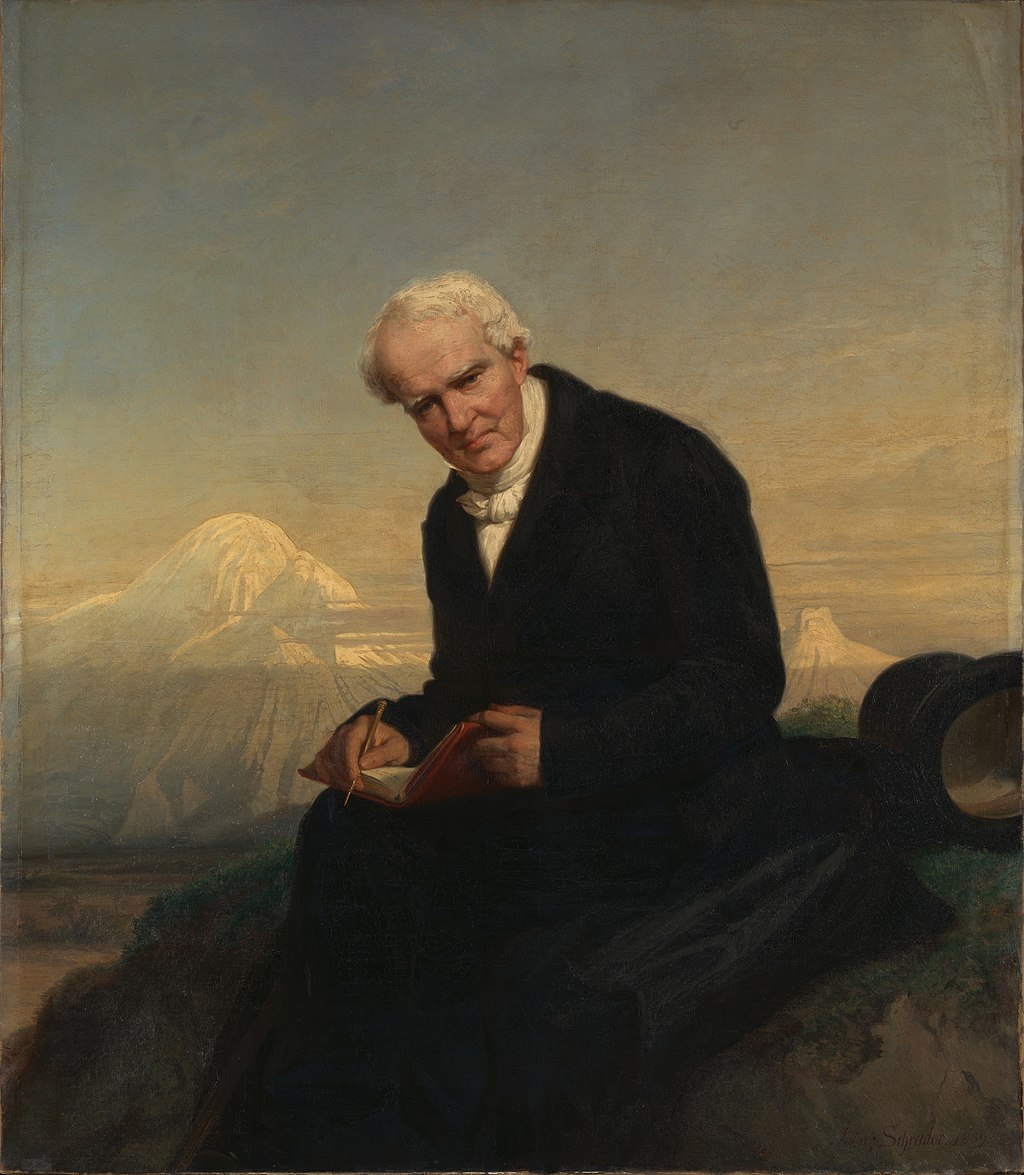 Portrait of Humboldt by Julius Schrader, 1859. Metropolitan Museum of Art Because Humboldt did not mention God in his work Cosmos, and sometimes spoke unfavourably of religious attitudes, it was occasionally speculated that he was a materialist philosopher, or perhaps an atheist.[205] However, unlike irreligious figures such as Robert G. Ingersoll, who went so far as to use Humboldtian science to campaign against religion,[206] Humboldt himself denied imputations of atheism. In a letter to Varnhagen von Ense he emphasized that he believed the world had indeed been created, writing of Cosmos: "...'creation' and the 'created world' are never lost sight of in the book. And did I not, only eight months ago, in the French translation, say, in the plainest terms: 'It is this necessity of things, this occult but permanent connection, this periodical return in the progress, development of formation, phenomena, and events which constitute 'Nature' submissive to a controlling power?'"[207] It has been argued that "although Humboldt emphasizes the basis of morality in the nature of man, he does acknowledge that a belief in God is linked directly to acts of virtue" and therefore "the dignity of man lies at the centre of Humboldt's religious thought".[208] Humboldt also believed firmly in an afterlife.[209] A letter he wrote to his friend Charlotte Hildebrand Diede states: "God constantly appoints the course of nature and of circumstances; so that, including his existence in an eternal future, the happiness of the individual does not perish, but on the contrary grows and increases."[210] Humboldt remained distant of organized religion, typical of a Protestant in Germany relating to the Catholic Church; Humboldt held deep respect for the ideal side of religious belief and church life within human communities.[211] He differentiated between "negative" religions, and those "all positive religions [which] consist of three distinct parts—a code of morals which is nearly the same in all of them, and generally very pure; a geological chimera, and a myth or a little historical novel".[212] In Cosmos, he wrote about how rich geological descriptions were found in different religious traditions, and stated: "Christianity gradually diffused itself, and, wherever it was adopted as the religion of the state, it not only exercised a beneficial condition on the lower classes by inculcating the social freedom of mankind, but also expanded the views of men in their communion with Nature...this tendency to glorify the Deity in his works gave rise to a taste for natural observation."[213] Humboldt showed religious tolerance towards Judaism, and he criticized the political Jews Bill, which was an initiative intended to establish legal discrimination against Jews. He called this an "abominable" law, since he hoped to see Jews being treated equally in society.[214] |
宗教 ユリウス・シュレーダー作、フンボルトの肖像画、1859年。メトロポリタン美術館 フンボルトは著作『コスモス』で神について言及せず、時に宗教的態度を批判的に語ったため、唯物論哲学者あるいは無神論者ではないかと推測されることが あった[205]。しかし、ロバート・G・インガーソルのように、フンボルトの科学を宗教批判に利用した無宗教の人物とは異なり[206]、フンボルト自 身は無神論のレッテルを否定した。ヴァルンハーゲン・フォン・エンゼへの手紙で、彼は世界が確かに創造されたと信じていることを強調し、『コスモス』につ いてこう書いている:「…『創造』と『創造された世界』は、この本の中で決して見失われることはない。そしてわずか8ヶ月前、フランス語訳において、私は 最も平易な言葉でこう述べていないか:『物事の必然性、この秘められたが恒常的な繋がり、形成・現象・出来事の進歩と発展における周期的な回帰こそが、 「自然」を統制する力に従属させる要素なのではないか?』」と記している[207]。 「フンボルトは道徳の基盤を人間の本性に置くことを強調しつつも、神への信仰が直接的に徳行と結びついていることを認めている」と論じられており、したがって「人間の尊厳こそがフンボルトの宗教思想の中心にある」とされる。[208] フンボルトは来世を固く信じていた。[209] 友人シャルロッテ・ヒルデブランド・ディーデへの書簡にはこう記されている: 「神は常に自然と状況の進路を定める。故に、永遠の未来における神の存在を含め、個人の幸福は滅びることなく、むしろ増大し発展するのだ」[210] フンボルトは組織化された宗教に対して距離を置いた。これはドイツのプロテスタントがカトリック教会に対して取る典型的な態度である。しかし彼は、人間共 同体における宗教的信念と教会生活の理想的な側面に対して深い敬意を抱いていた。[211] 彼は「否定的な宗教」と「全ての肯定的な宗教」を区別した。後者は「三つの明確な部分から成る——ほぼ共通で概して非常に純粋な道徳規範、地質学的空想、 そして神話あるいは小規模な歴史小説である」[212]。『コスモス』において、彼は様々な宗教伝統に豊かな地質学的記述が見られることを記し、こう述べ た: 「キリスト教は次第に広がり、国教として採用された地域では、人類の社会的自由を説くことで下層階級に有益な影響を与えただけでなく、人々が自然との交わ りにおいて視野を広げるよう促した…この『神の業を称える傾向』が、自然観察への嗜好を生み出したのだ」[213] フンボルトはユダヤ教に対して宗教的寛容を示し、ユダヤ人に対する法的差別を確立しようとする政治的ユダヤ人法案を批判した。彼はこれを「忌まわしい」法律と呼んだ。なぜなら、ユダヤ人が社会で平等に扱われることを望んでいたからである。[214] |
Sociality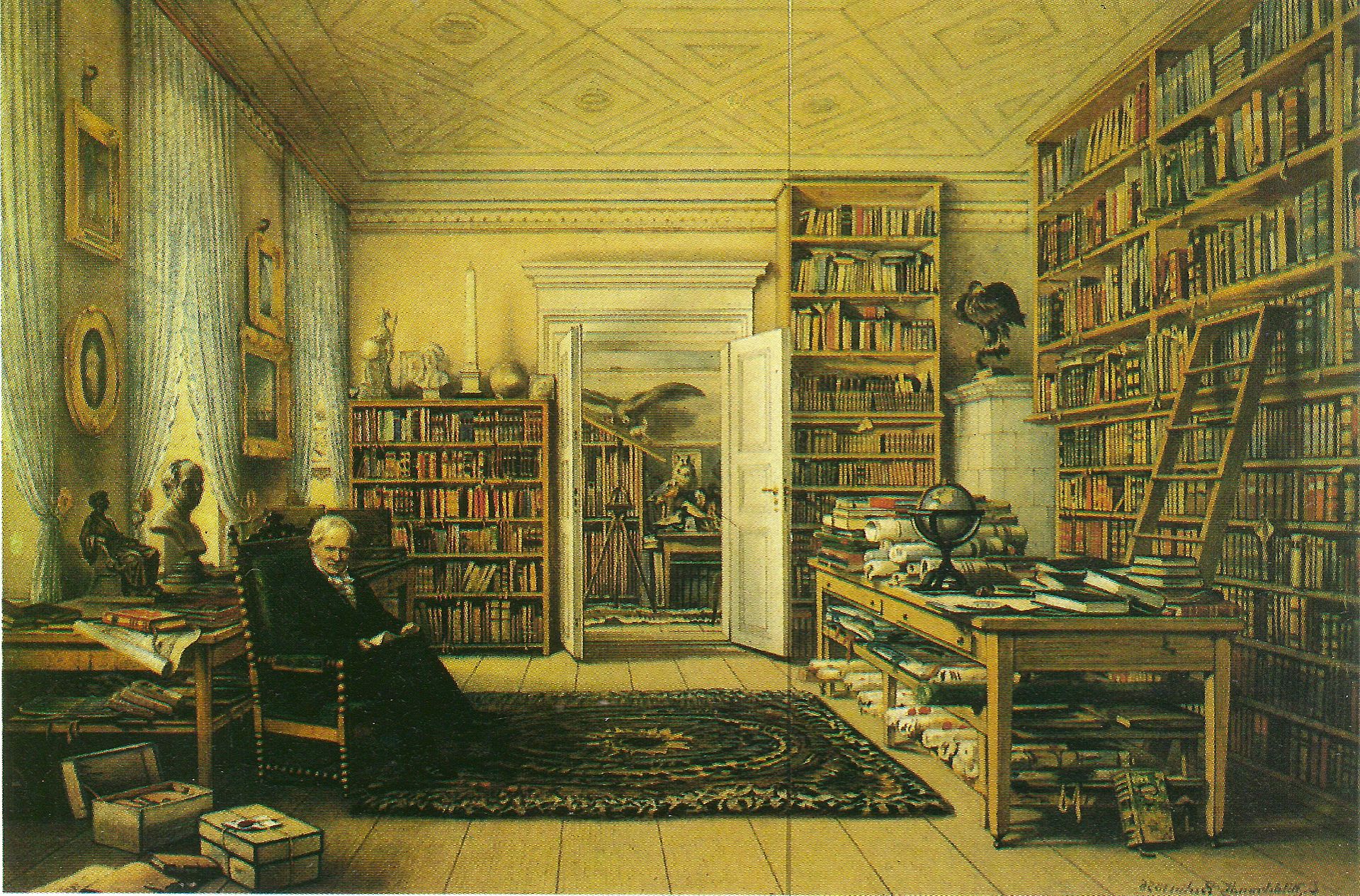 Humboldt in his library in his apartment, Oranienburger Straße, Berlin, by Eduard Hildebrandt Much of Humboldt's private life remains a mystery because he destroyed his private letters. While a gregarious personality, he may have harbored a sense of social alienation, which drove his passion for escape through travel.[215] Sexuality Humboldt never married: while he was friendly with a number of women, including Henriette, the wife of his mentor Marcus Herz, his sister-in-law Caroline von Humboldt stated "nothing will ever have a great influence on Alexander that doesn't come through men".[216] He had many strong male friendships, and at times had romances with men.[217] As a student he became infatuated with Wilhelm Gabriel Wegener, a theology student, penning a succession of letters expressing his "fervent love".[218] At 25 he met Reinhardt von Haeften (1772–1803), a 22-year-old lieutenant, with whom he lived and travelled for two years, and to whom he wrote in 1794: "I only live through you, my good precious Reinhardt". When von Haeften became engaged, Humboldt begged to remain living with him and his wife: "Even if you must refuse me, treat me coldly with disdain, I should still want to be with you... the love I have for you is not just friendship or brotherly love, it is veneration".[219] A traveling companion in the Americas for five years was Aimé Bonpland, and in Quito in 1802 he met the Ecuadorian aristocrat Don Carlos Montúfar, who travelled with Humboldt to Europe and lived with him. In France, Humboldt travelled and lived with the physicist and balloonist Joseph Louis Gay-Lussac. Later he had a deep friendship with the married French astronomer François Arago, whom he met daily for 15 years.[220] Humboldt once wrote "I don't know sensual needs".[216] However, a pious travelling companion, Francisco José de Caldas, accused him of frequenting houses in Quito where "impure love reigned", of making friends with "obscene dissolute youths", of giving vent to "shameful passions of his heart", and dropping him to travel with "Bonpland and his Adonis" [Montúfar].[221] Humboldt inherited a significant fortune, but the expense of his travels, and most especially of publishing (thirty volumes in all), had by 1834 made him totally reliant on the pension of King Frederick William III.[222] Although he preferred living in Paris, by 1836 the King had insisted he return to Germany. He lived with the Court at Sanssouci, and latterly in Berlin, with his valet Seifert, who had accompanied him to Russia in 1829.[223]  Signature of Humboldt late in life, when his handwriting became increasingly difficult to read Four years before his death, Humboldt executed a deed of gift transferring his entire estate to Seifert,[224][225] who had by then married and set up a household near Humboldt's apartment. Humboldt had become godfather to his daughter.[226] The scale of the bequest has always drawn speculation, especially as Seifert was some thirty years younger, and introducing lower class partners into households under the guise of servants was then a common practice.[227] In 1908, the sexual researcher Paul Näcke gathered reminiscences from homosexuals[228] including Humboldt's friend the botanist Carl Bolle, then nearly 90 years old: some of the material was incorporated by Magnus Hirschfeld into his 1914 study Homosexuality in Men and Women.[229] However, speculations about Humboldt's private life and possible homosexuality continue to remain a fractious issue amongst scholars, particularly as earlier biographers had portrayed him as "a largely asexual, Christ-like Humboldt figure...suitable as a national idol".[230] |
社会性 ベルリン、オラニエンブルガー通りのアパートの書斎にいるフンボルト。エドゥアルト・ヒルデブラント作 フンボルトの私生活の大半は謎に包まれている。彼は私的な手紙を破棄したからだ。社交的な性格でありながら、社会的な疎外感を抱えていた可能性があり、それが旅行による逃避への情熱を駆り立てたのかもしれない。[215] セクシュアリティ フンボルトは結婚しなかった。師であるマルクス・ヘルツの妻、ヘンリエッテをはじめ、多くの女性と親しくしていたが、義理の姉であるカロリーネ・フォン・ フンボルトは、「アレクサンダーに大きな影響を与えるものは、男性を通してしか得られない」と述べている。[216] 彼は多くの男性と強い友情を結び、時には男性と恋愛関係にもなった。[217] 学生時代、彼は神学部の学生であるヴィルヘルム・ガブリエル・ウェゲナーに夢中になり、彼の「熱烈な愛」を綴った手紙を次々と書いた[218]。25歳の とき、22歳の陸軍中尉、ラインハルト・フォン・ヘフテン(1772年~1803年)と出会い、2年間一緒に暮らし、旅をした。1794年、彼はヘフテン にこう書いた。「私はお前を通してのみ生きている、我が良き尊きラインハルトよ」。フォン・ヘフテンが婚約すると、フンボルトは彼と妻との同居を懇願し た。「たとえお前が拒絶し、冷たく軽蔑しても、私はなおお前と共にいたい…お前への愛は友情や兄弟愛ではなく、崇拝なのだ」。[219] アメリカ大陸では5年間、エイメ・ボンプランが旅の伴侶となった。1802年にはキトでエクアドルの貴族ドン・カルロス・モントゥファルと出会い、彼はフ ンボルトと共にヨーロッパへ渡り、同居した。フランスでは、物理学者で気球飛行士のジョゼフ・ルイ・ゲイ=リュサックと共に旅し生活した。後に既婚のフラ ンス人天文学者フランソワ・アラゴと深い友情を育み、15年間にわたり毎日顔を合わせた。[220] フンボルトはかつて「私は肉欲的な欲求を知らない」と記している。[216] しかし敬虔な旅の仲間フランシスコ・ホセ・デ・カルダスは、フンボルトがキトで「不純な愛がはびこる」家々に出入りし、「卑猥で放蕩な若者」と親交を結 び、「心の恥ずべき情熱」にふけり、最終的には「ボンプランとそのアドニス(モントゥファル)」と旅を共にするために自分を置き去りにしたと非難した。 [221] フンボルトは莫大な財産を相続したが、旅費、特に出版費(全30巻)の支出により、1834年までにフリードリヒ・ヴィルヘルム3世国王の年金に完全に依 存する状態となっていた。[222] パリでの生活を好んでいたが、1836年までに国王は彼のドイツ帰還を強く求めた。彼は宮廷と共にサンスーシーに居住し、後年はベルリンで、1829年に ロシア同行した従者ザイフェルトと共に暮らした。[223]  晩年のフンボルトの署名。筆跡が次第に判読困難となった時期のもの 死の4年前、フンボルトは全財産をザイフェルトへ譲渡する贈与証書を作成した。[224][225]。当時ザイフェルトは結婚し、フンボルトの住居近くに 家庭を構えていた。フンボルトは彼の娘の名付け親となっていた[226]。この遺贈の規模は常に憶測を呼んできた。特にザイフェルトが30歳ほど年下で あったこと、また当時、使用人という名目で下層階級のパートナーを家庭に迎え入れる慣行が一般的であったことからである[227]。 1908年、性科学者ポール・ネーケは同性愛者たち[228]から回想録を収集した。その中にはフンボルトの友人である植物学者カール・ボーレ(当時90 歳近く)も含まれていた。これらの資料の一部は、マグヌス・ヒルシュフェルトが1914年に発表した研究『男女の同性愛』に取り込まれた。しかしフンボル トの私生活や同性愛の可能性に関する推測は、学者の間で依然として論争の的となっている。特に初期の伝記作家たちが彼を「ほぼ無性愛の、キリストのような フンボルト像…国民的英雄としてふさわしい」と描いてきたためである。 |
| Illness and death On 24 February 1857, Humboldt suffered a minor stroke, which passed without perceptible symptoms.[231] It was not until the winter of 1858–1859 that his strength began to decline; on 6 May 1859, he died peacefully in Berlin, aged 89. His last words were reported to be "How glorious these sunbeams are! They seem to call Earth to the Heavens!"[232] His remains were conveyed in state through the streets of Berlin, in a hearse drawn by six horses. Royal chamberlains led the cortège, each charged with carrying a pillow with Humboldt's medals and other decorations of honor. Humboldt's extended family, descendants of his brother Wilhelm, walked in the procession. Humboldt's coffin was received by the prince-regent at the door of the cathedral. He was interred at the family resting-place at Tegel, alongside his brother Wilhelm and sister-in-law Caroline.[233] |
病気と死 1857年2月24日、フンボルトは軽い脳卒中を患ったが、目立った症状は現れなかった[231]。彼の体力が衰え始めたのは1858年から1859年の 冬になってからだった。1859年5月6日、彼はベルリンで89歳の生涯を静かに閉じた。最期の言葉は「なんて素晴らしい陽の光だろう!まるで大地を天へ と招いているようだ!」[232]と伝えられている。遺体は六頭立ての霊柩車でベルリンの街を公葬の列をなして運ばれた。王室侍従長たちが列の先頭を進 み、それぞれがフンボルトの勲章やその他の栄誉の装飾品を載せた枕を担いでいた。フンボルトの拡大家族、すなわち弟ヴィルヘルムの子孫たちも行列に加わっ た。フンボルトの棺は大聖堂の入口で摂政王太子によって迎えられた。彼はテーゲルの家族墓地に、弟ヴィルヘルムと義姉カロリーネの隣に埋葬された [233]。 |
| Honours and namesakes The honours which had been showered on Humboldt during their life continued after his death. More species are named after Humboldt than after any other human being.[15] The first centenary of Humboldt's birth was celebrated on 14 September 1869, with great enthusiasm in both the New and Old Worlds. Numerous monuments were constructed in his honour, such as Humboldt Park in Chicago, planned that year and constructed shortly after the Chicago fire. Newly explored regions and species named after Humboldt, as discussed below, also stand as a measure of his wide fame and popularity. "Scarcely was there a European order which Humboldt had not the right to wear", and "more than a hundred and fifty societies to which he had been elected". These included "the most celebrated Academies of the leading nations of Europe and America, and not merely those of a purely scientific character, but any which had for their object the spread of education and the advancement of civilisation." Additionally, he was at least an honorary member of academies and learned societies throughout Europe and America and "was invested with the degree of Doctor in three faculties".[234] Honours 1827 Honorary Doctor of the Imperial University of Dorpat[235] 1829: Actual Privy Counsellor, with the title of Excellency by King Frederick William III of Prussia[236] 1842: Chancellor of the Order of Merit, an administrative position empowered to appoint, by King Frederick William IV of Prussia[237] 1842: Pour le Mérite, Recipient (civil division)[238] 1844: Order of the Red Eagle, by King Frederick William IV of Prussia[239] 1847: Order of the Black Eagle, by King Frederick William IV of Prussia, the highest honour that was in the royal power to confer.[239] 1850: Knight Grand Cross of the Order of Saints Maurice and Lazarus[240] 1852: Copley Medal "For his eminent services in terrestrial physics"[241] 1853: Bavarian Maximilian Order for Science and Art by King Maximilian II of Bavaria "as the man who honours the order", "the hero of science in Germany".[242] 1863: Knight Grand Cross of the Order of Guadalupe[citation needed] Species named after Humboldt This section needs additional citations for verification. Please help improve this article by adding citations to reliable sources in this section. Unsourced material may be challenged and removed. (February 2015) (Learn how and when to remove this message) Humboldt described many geographical features and species that were hitherto unknown to Europeans. Species named after him include: Spheniscus humboldti – Humboldt penguin Dosidicus gigas – Humboldt squid Lilium humboldtii – Humboldt's lily Phragmipedium humboldtii – an orchid Quercus humboldtii – South American (Andean) oak Conepatus humboldtii – Humboldt's hog-nosed skunk[243] Annona humboldtii – Neotropical fruit tree or shrub Utricularia humboldtii – a bladderwort Geranium humboldtii – a cranesbill Salix humboldtiana – a South-American willow[244] Inia geoffrensis humboldtiana – Amazon river dolphin subspecies of Orinoco River basin Rhinocoryne humboldti – marine snail Bathybembix humboldti – marine snail Rhinella humboldti – Rivero's toad Pteroglossus humboldti – Humboldt's Araçari Hylocharis humboldtii – Humboldt's hummingbird Casignethus humboldti – beetle Elzunia humboldt – butterfly †Lenisambulatrix humboldti – Cambrian Lobopodia Squamulea humboldtiana – lichen[245] E. (S.) humboldti [246] |
栄誉と同名者 フンボルトが生前に受けた数々の栄誉は、死後も続いた。フンボルトの名を冠した生物種は、他のいかなる人物よりも多い。[15] フンボルト生誕100周年は1869年9月14日に祝われ、新旧両世界で大いに盛り上がった。彼を称える数多くの記念碑が建てられた。例えばシカゴのフン ボルト公園は、その年に計画され、シカゴ大火の直後に建設された。後述するように、新たに探検された地域やフンボルトに因んで命名された種も、彼の広範な 名声と人気の証左である。 「フンボルトが受ける資格のないヨーロッパの勲位などほとんど存在せず」、「彼が選出された学会は150以上にも及んだ」。これには「欧米主要国の最も著 名なアカデミーが含まれ、純粋に科学的性格のものだけでなく、教育普及と文明発展を目的とするあらゆる団体」が該当した。さらに彼は欧米全域のアカデミー や学術団体の名誉会員であり、「三つの学部の博士号を授与された」のである。[234] 栄誉 1827年 ドルパット帝国大学名誉博士[235] 1829年:プロイセン王フリードリヒ・ヴィルヘルム3世より実権ある枢密顧問官に任命、閣下称号を授与[236] 1842年:プロイセン王フリードリヒ・ヴィルヘルム4世より功績勲章長官に任命(任命権限を有する行政職) [237] 1842年:功績勲章(民間部門)受章者[238] 1844年:プロイセン王フリードリヒ・ヴィルヘルム4世より赤鷲勲章授与[239] 1847年:プロイセン王フリードリヒ・ヴィルヘルム4世より黒鷲勲章授与。王権が授与し得る最高位の栄誉であった[239] 1850年:聖モーリス・聖ラザロ騎士団大十字章[240] 1852年:コプリーメダル「地球物理学における卓越した功績に対して」[241] 1853年:バイエルン王マクシミリアン2世よりバイエルン科学芸術マクシミリアン勲章を授与。「この勲章に栄誉をもたらす人物として」、「ドイツ科学の英雄として」。[242] 1863年:グアダルーペ勲章騎士大十字章[出典必要] フンボルトに因んで命名された生物種 この節は検証可能な出典を必要とする。信頼できる出典をこの節に追加し、記事の改善に協力してほしい。出典のない記述は削除される可能性がある。(2015年2月)(このメッセージの削除方法と時期について) フンボルトは、それまでヨーロッパ人に知られていなかった多くの地理的特徴や生物種を記述した。彼にちなんで名付けられた種には以下がある: Spheniscus humboldti – フンボルトペンギン Dosidicus gigas – フンボルトイカ Lilium humboldtii – フンボルトユリ Phragmipedium humboldtii – ランの一種 Quercus humboldtii – 南米(アンデス)オーク Conepatus humboldtii – ハンボルトホッグノーズスカンク[243] Annona humboldtii – 新熱帯区の果樹または低木 Utricularia humboldtii – ウツボカズラ Geranium humboldtii – ハンボルトゼラニウム Salix humboldtiana – 南米ヤナギ [244] アマゾン川イルカ亜種(オリノコ川流域) ヒラタウミウシ バチベンビクス・フンボルトイ リネラ・フンボルトイ フンボルトアラーカリ ヒロカリス・フンボルトイ – フンボルトハチドリ カシグネトゥス・フンボルトイ – カブトムシ エルズニア・フンボルト – チョウ †レニサンブラトリクス・フンボルトイ – カンブリア紀のロボポディア スクアミュレア・フンボルトイアナ – 地衣類[245] E. (S.) humboldti [246] |
| Geographical features named after Humboldt Features named after him include:[247] Humboldt Bay – Bay in Northern California, United States Humboldt Current – off the west coast of South America Humboldt Glacier – in North West Greenland Humboldt River and Humboldt Lake – Nevada, United States[248] Humboldt Peak (Colorado) – 4,287 m mountain in Custer County, Colorado, United States Pico Humboldt – 4,940 m mountain in Mérida, Venezuela Humboldt Sink – Dry lake bed in Nevada, United States East and West Humboldt Range in Nevada, United States Sima Humboldt – sinkhole in Venezuela "Monumento Nacional Alejandro de Humboldt" at Caripe, Venezuela Mount Humboldt – 1,617 m (5,308 ft), New Caledonia Humboldt Mountains, Antarctic mountains discovered and mapped by the Third German Antarctic Expedition (1938–1939) Humboldt Mountains – Mountain Range in Fiordland National Park, New Zealand Humboldt Channel – natural waterway through the central Canadian Arctic Archipelago Humboldt Falls – 275 m Waterfall in Lower Hollyford Valley, Fiordland National Park, New Zealand Humboldt Redwoods State Park – in northern California, United States |
フンボルトに因んで名付けられた地理的特徴 彼に因んで名付けられた特徴には以下が含まれる:[247] フンボルト湾 – アメリカ合衆国カリフォルニア州北部の湾 フンボルト海流 – 南アメリカ西海岸沖 フンボルト氷河 – グリーンランド北西部 フンボルト川とフンボルト湖 – アメリカ合衆国ネバダ州 [248] ハンボルト峰(コロラド州) – アメリカ合衆国コロラド州カスター郡にある標高4,287メートルの山 ピコ・ハンボルト – ベネズエラ、メリダにある標高4,940メートルの山 ハンボルト・シンク – アメリカ合衆国ネバダ州にある干上がった湖底 東ハンボルト山脈と西ハンボルト山脈 – アメリカ合衆国ネバダ州にある山脈 シマ・フンボルト – ベネズエラの陥没穴 「アレハンドロ・デ・フンボルト国立記念碑」 – ベネズエラ、カリペ フンボルト山 – 標高1,617m(5,308フィート)、ニューカレドニア フンボルト山脈 – 第三回ドイツ南極探検隊(1938-1939年)によって発見・測量された南極山脈 フンボルト山脈 – ニュージーランド、フィヨルドランド国立公園内の山脈 フンボルト海峡 – カナダ中央北極諸島を貫く天然水路 フンボルト滝 – ニュージーランド、フィヨルドランド国立公園、ローワーホリーフォード渓谷にある275メートルの滝 フンボルトレッドウッド州立公園 – アメリカ合衆国、カリフォルニア州北部にある公園 |
| Places named after Humboldt The following places are named for Humboldt: Hacienda Humboldt, Chihuahua, Mexico Humboldt, South Dakota, United States Humboldt, Nebraska, United States Humboldt, Illinois, United States Humboldt, Iowa, United States Humboldt, Tennessee, United States Humboldt, Kansas, United States Humboldt, Minnesota, United States Humboldt, Arizona, United States Humboldt County, California, United States Fort Humboldt State Historic Park, Eureka, California, United States Humboldt County, Nevada, United States Humboldt County, Iowa, United States Humboldt, Saskatchewan, Canada Humboldt Park, Chicago, Illinois, United States Alejandro de Humboldt National Park, Cuba Alexander von Humboldt National Forest, Peru Humboldt-Toiyabe National Forest, Nevada & California, United States Humboldt Park, Buffalo, New York, United States Humboldt Parkway, Buffalo, New York, United States Astronomical features Mare Humboldtianum (lunar mare) 54 Alexandra (asteroid) 4877 Humboldt (asteroid) Geological objects The mineral humboldtine was named for Alexander by Mariano de Rivero in 1821.[249][250] Universities, colleges, and schools Humboldt University of Berlin Universities Humboldt University of Berlin is named after Alexander and his brother Wilhelm who founded it[251] Alexander von Humboldt Biological Resources Research Institute in Bogotá and Villa de Leiva, Colombia California State Polytechnic University, Humboldt in Arcata, California Universidad Alejandro de Humboldt in Caracas, Venezuela Schools Main article: List of schools named after Alexander von Humboldt Alexander-von-Humboldt-Gymnasium, Konstanz, Germany Alexander von Humboldt German International School Montreal, Montreal, Canada Colegio Alemán Alexander von Humboldt, Mexico City, Mexico Deutsche Schule Lima Alexander von Humboldt, Lima, Peru Colegio Humboldt, Caracas, Venezuela Humboldt Senior High School, St. Paul, Minnesota Lecture series Alexander von Humboldt also lends his name to a prominent lecture series in Human geography in the Netherlands (hosted by the Radboud University Nijmegen). It is the Dutch equivalent of the widely known annual Hettner lectures at the University of Heidelberg. The Alexander von Humboldt Foundation After his death, Humboldt's friends and colleagues created the Alexander von Humboldt Foundation (Stiftung in German) to continue his generous support of young academics. Although the original endowment was lost in the German hyperinflation of the 1920s, and again as a result of World War II, the Foundation has been re-endowed by the German government to award young academics and distinguished senior academics from abroad. It plays an important role in attracting foreign researchers to work in Germany and enabling German researchers to work abroad for a period. Dedications Edgar Allan Poe dedicated his last major work, Eureka: A Prose Poem, to Humboldt, "With Very Profound Respect". Humboldt's attempt to unify the sciences in his Kosmos was a major inspiration for Poe's project. In 2019, Josefina Benedetti composed Humboldt an Orchestral Suite in five movements. Ships Alexander von Humboldt is also a German ship named after the scientist, originally built in 1906 by the German shipyard AG Weser at Bremen as Reserve Sonderburg. She was operated throughout the North and Baltic Seas until being retired in 1986. Subsequently, she was converted into a three-masted barque by the German shipyard Motorwerke Bremerhaven, and was re-launched in 1988 as Alexander von Humboldt.[citation needed] The Jan De Nul Group operates a hopper dredger built in 1998 also named Alexander von Humboldt.[252] Recognitions by contemporaries Simón Bolívar wrote that "The real discoverer of South America was Humboldt, since his work was more useful for our people than the work of all conquerors".[253] Charles Darwin expressed his debt to Humboldt, and admiration for his work,[254] writing to Joseph Dalton Hooker that Humboldt was the "greatest scientific traveller who ever lived".[255] Wilhelm von Humboldt wrote that "Alexander is destined to combine ideas and follow chains of thoughts which would otherwise have remained unknown for ages. His depth, his sharp mind and his incredible speed are a rare combination." Johann Wolfgang Goethe observed that "Humboldt showers us with true treasures". Friedrich Schiller wrote that "Alexander impresses many, particularly when compared to his brother—because he shows off more!" José de la Luz y Caballero wrote that "Columbus gave Europe a New World; Humboldt made it known in its physical, material, intellectual, and moral aspects". Napoléon Bonaparte remarked "You have been studying Botanics? Just like my wife!" Claude Louis Berthollet said "This man is as knowledgeable as a whole academy". Thomas Jefferson remarked "I consider him the most important scientist whom I have met". Emil du Bois-Reymond wrote that "Every assiduous scholar ... is Humboldt's son; we are all his family."[256] Robert G. Ingersoll wrote that "He was to science what Shakespeare was to the drama".[257] Hermann von Helmholtz wrote that "During the first half of the present century we had an Alexander von Humboldt, who was able to scan the scientific knowledge of his time in its details, and to bring it within one vast generalization. At the present juncture, it is obviously very doubtful whether this task could be accomplished in a similar way, even by a mind with gifts so peculiarly suited for the purpose as Humboldt's was, and if all his time and work were devoted to the purpose."[258] |
フンボルトに因んで名付けられた場所 以下の場所はフンボルトに因んで名付けられている: ハシエンダ・フンボルト、チワワ州、メキシコ フンボルト、サウスダコタ州、アメリカ合衆国 フンボルト、ネブラスカ州、アメリカ合衆国 フンボルト、イリノイ州、アメリカ合衆国 フンボルト、アイオワ州、アメリカ合衆国 フンボルト、テネシー州、アメリカ合衆国 フンボルト、カンザス州、アメリカ合衆国 フンボルト、ミネソタ州、アメリカ合衆国 米国アリゾナ州ハンボルト 米国カリフォルニア州ハンボルト郡 米国カリフォルニア州ユーレカにあるフォート・ハンボルト州立歴史公園 米国ネバダ州ハンボルト郡 米国アイオワ州ハンボルト郡 カナダサスカチュワン州ハンボルト ハンボルト公園、シカゴ、イリノイ州、アメリカ合衆国 アレハンドロ・デ・ハンボルト国立公園、キューバ アレクサンダー・フォン・ハンボルト国有林、ペルー ハンボルト・トイヤベ国有林、ネバダ州およびカリフォルニア州、アメリカ合衆国 ハンボルト公園、バッファロー、ニューヨーク州、アメリカ合衆国 ハンボルト・パークウェイ、バッファロー、ニューヨーク州、アメリカ合衆国 天文学的特徴 ハンボルト海(月の海) 54 アレクサンドラ (小惑星) 4877 フンボルト (小惑星) 地質学的対象 鉱物フンボルトは、1821年にマリアーノ・デ・リベロによってアレクサンダーにちなんで名付けられた。 大学、カレッジ、学校 フンボルト大学ベルリン 大学 フンボルト大学ベルリンは、アレクサンダーと、その兄弟であるウィリアムにちなんで名付けられた。[251] コロンビア、ボゴタおよびビジャ・デ・レイバにあるアレクサンダー・フォン・フンボルト生物資源研究所 カリフォルニア州アーカタにあるカリフォルニア州立工科大学ハンボルト校 ベネズエラ、カラカスにあるアレハンドロ・デ・フンボルト大学 学校 主な記事:アレクサンダー・フォン・フンボルトにちなんで名付けられた学校のリスト アレクサンダー・フォン・フンボルト・ギムナジウム、ドイツ、コンスタンツ アレクサンダー・フォン・フンボルト・ジャーマン・インターナショナル・スクール・モントリオール、カナダ、モントリオール アレクサンダー・フォン・フンボルト・コレジオ・アレマン、メキシコ、メキシコシティ アレクサンダー・フォン・フンボルト・ドイチェ・シューレ・リマ、ペルー、リマ アレクサンダー・フォン・フンボルト・コレジオ、ベネズエ ハンボルト高校、ミネソタ州セントポール 講演シリーズ アレクサンダー・フォン・フンボルトは、オランダの人文地理学における著名な講演シリーズ(ラドバウド大学ナイメーヘンが主催)にもその名を残している。これは、ハイデルベルク大学で広く知られる毎年恒例のヘットナー講演に相当するオランダ版のものだ。 アレクサンダー・フォン・フンボルト財団 フンボルトの死後、彼の友人や同僚たちは、若い学者たちへの彼の寛大な支援を継続するために、アレクサンダー・フォン・フンボルト財団(ドイツ語で Stiftung)を設立した。当初の基金は、1920年代のドイツのハイパーインフレと、第二次世界大戦の結果として失われたが、ドイツ政府によって再 設立され、海外の若手学者や著名な上級学者に授与されている。この財団は、外国の研究者をドイツに招き、ドイツの研究者が一定期間海外で研究活動を行うこ とを可能にする上で重要な役割を果たしている。 献辞 エドガー・アラン・ポーは、最後の主要作品『ユーレカ:散文詩』をフンボルトに「深い敬意を込めて」捧げた。フンボルトが『コスモス』で科学の統一を試みたことは、ポーのプロジェクトに大きな影響を与えた。 2019年、ホセフィーナ・ベネデッティは、5つの楽章からなるオーケストラ組曲「フンボルト」を作曲した。 船 アレクサンダー・フォン・フンボルトは、この科学者にちなんで名付けられたドイツの船でもある。1906年にブレーメンのドイツ造船所AG Weserによって、Reserve Sonderburgとして建造された。1986年に退役するまで、北海とバルト海全域で運用されていた。その後、ドイツの造船所モーターヴェルケ・ブ レーマーハーフェンによって三本マストのバーク船に改造され、1988年にアレクサンダー・フォン・フンボルトとして再就航した。 ヤン・デ・ヌル・グループは、1998年に建造されたホッパー式浚渫船を運航しており、これもアレクサンダー・フォン・フンボルトと名付けられている。 同時代の人々による評価 シモン・ボリバルは、「南アメリカの真の発見者はフンボルトである。彼の業績は、あらゆる征服者たちの業績よりも、我々の民にとってより有用であった」と 記している。[253] チャールズ・ダーウィンは、フンボルトへの感謝と彼の業績への賞賛を表明し[254]、ジョセフ・ダルトン・フッカーに、フンボルトは「史上最高の科学旅 行者」であると書簡で伝えている。[255] ヴィルヘルム・フォン・フンボルトは、「アレクサンダーは、そうでなければ何世紀にもわたって知られぬままだったであろう考えを結びつけ、思考の連鎖をた どる運命にある。彼の深み、鋭い知性、そして驚異的なスピードは、稀有な組み合わせである」と記している。ヨハン・ヴォルフガング・ゲーテは、「フンボル トは我々に真の宝物を降り注いでくれる」と述べた。フリードリヒ・シラーは、「アレクサンダーは、特に彼の兄弟と比較すると、より多くの人々に強い印象を 与える。なぜなら、彼はより多くを誇示するからだ」と記している。ホセ・デ・ラ・ルス・イ・カバジェロは、「コロンブスはヨーロッパに新世界をもたらした が、フンボルトは、その物理的、物質的、知的、道徳的側面を明らかにした」と記している。 ナポレオン・ボナパルトは「植物学を研究していたのか?私の妻と同じだ!」と述べた。クロード・ルイ・ベルトレは「この男は、アカデミー全体と同じくらい 知識が豊富だ」と述べた。トーマス・ジェファーソンは「私は彼を、私が出会った中で最も重要な科学者だと思っている」と述べた。エミール・デュ・ボワ=レ イモンは「勤勉な学者たちは皆...フンボルトの息子であり、我々は皆彼の家族である」と書いた。[256] ロバート・G・インガーソルは「彼は科学にとって、シェイクスピアが演劇にとっての存在だった」と記している。[257] ヘルマン・フォン・ヘルムホルツは「今世紀の前半、アレクサンダー・フォン・フンボルトという人物がいた。彼は当時の科学的知識を詳細に分析し、それを一 つの広範な一般化にまとめ上げた。現時点では、この任務が、フンボルトのようにその目的に特異的に適した才能を持つ人物でさえ、その時間と労力をすべてそ の目的に捧げたとしても、同様の方法で達成できるかどうかは、明らかに非常に疑わしい」と記している。 |
| Works Scientific works Florae Fribergensis specimen plantas cryptogramicus praesertim subterraneas exhibens, 1793. Humboldt's observations of underground plants made when he was a mining inspector. Versuche über die gereizte Muskel- und Nervenfaser nebst Versuchen über den chemischen Prozess des Lebens in der Thier- und Pflanzenwelt. (2 volumes), 1797. Humboldt's experiments in galvanism and nerve conductivity. Ueber die unterirdischen Gasarten und die Mittel, ihren Nachtheil zu vermindern. Braunschweig: Vieweg 1799. Sur l'analyse de l'air atmosphérique, with J.L. Gay-Lussac. Paris 1805. German edition, Türbingen. Fragments de géologie et de climatologie asiatiques 2 vols. Paris, 1831; Tübingen, 1831 Asie centrale, recherches sur les chaînes des montagnes et la climotologie comparée. 3 vols. 1843 Le voyage aux régions equinoxiales du Nouveau Continent, fait en 1799–1804, par Alexandre de Humboldt et Aimé Bonpland (Paris, 1807, etc.), consisted of thirty folio and quarto volumes, including: Vues des Cordillères et monuments des peuples indigènes de l'Amérique (2 vols. folio, 1810) English translation: Researches concerning the institutions & monuments of the ancient inhabitants of America : with descriptions & views of some of the most striking scenes in the Cordilleras! (2 vols.) [exclamation point in the original title] English translation: Views of the Cordilleras and Monuments of the Indigenous Peoples of the Americas: A Critical Edition. Vera M. Kutzinski and Ottmar Ette, editors. Chicago: University of Chicago Press, 2014. ISBN 978-0-226-86506-5 Examen critique de l'histoire de la géographie du Nouveau Continent (4 vols. 1814–1834) Atlas géographique et physique du royaume de la Nouvelle Espagne (1811) Essai politique sur le royaume de la Nouvelle Espagne (1811); English translation: Political essay on the kingdom of New Spain containing researches relative to the geography of Mexico, (1811) biodiversitylibrary.org; Essai sur la géographie des plantes: accompagné d'un tableau physique des régions équinoxiales, fondé sur des mesures exécutées, depuis le dixième degré de latitude boréale jusqu'au dixième degré de latitude australe, pendant les années 1799, 1800, 1801, 1802 et 1803/ par Al. de Humboldt et A. Bonpland; rédigée par Al. de Humboldt (1805), biodiversitylibrary.org English translation by Sylvie Romanowski:Essay on the Geography of Plants. University of Chicago Press. (2009) Essai géognostique sur le gisement des roches dans les deux continents. Paris 1823. English and German editions. Essai politique sur l'îsle de Cuba. 2 vols. Paris 1828. English[260] and German editions. Relation historique du Voyage aux Régions équinoxiales du Nouveau Continent, etc. (1814–1825), an unfinished narrative of his travels, including the Essai politique sur l'île de Cuba, biodiversitylibrary.org Monographie des melastomacées (1833) Monographia Melastomacearum: continens plantas huius ordinis, hucusque collectas, praesertim per regnum Mexici, in provinciis Caracarum et Novae Andalusiae, in Peruvianorum, Quitensium, Novae Granatae Andibus, ad Orinoci, fluvii Nigri, fluminis Amazonum rupas nascentes (2 vols.) Cosmos : a sketch of a physical description of the universe by Alexander von Humboldt; translated from the German by E. C. Otté (5 vols.)[261] Cosmos: essai d'une description physique du monde (4 vols.) Gesammelte Werke von Alexander von Humboldt (12 vols.) Ansichten der Natur: mit wissenschaftlichen Erläuterungen Aphorismen aus der chemischen Physiologie der Pflanzen. Aus dem Lateinischen übersetzt von Gotthelf Fischer. Nebst einigen Zusätzen von Herrn Dr. und Prof. Hedwig und einer Vorrede von Herrn Dr. und Prof. Christ. Friedr. Ludwig. 1794. Aspects of nature, in different lands and different climates with scientific elucidations Atlas zu Alex. v. Humboldt's Kosmos in zweiundvierzig Tafeln mit erläuterndem Texte / herausgegeben von Traugott Bromme Briefe von Alexander von Humboldt an Varnhagen von Ense, aus den Jahren 1827 bis 1858 : nebst Auszügen aus Varnhagen's Tagebüchern und Briefen von Varnhagen und andern an Humboldt Ideen zu einer Geographie der Pflanzen: nebst einem Naturgemälde der Tropenländer : auf Beobachtungen und Messungen gegründet, welche vom 10ten Grade nördlicher bis zum 10ten Grade südlicher Breite, in den Jahren 1799, 1800, 1801, 1802 und 1803 angestellt worden sind / von Al. von Humboldt und A. Bonpland; bearbeitet und herausgegeben von dem erstern An illustration of the genus Cinchona :comprising descriptions of all the officinal Peruvian barks, including several new species, Baron de Humboldt's Account of the Cinchona forests of South America, and Laubert's Memoir on the different species of quinquina: to which are added several dissertations of Don Hippolito Ruiz on various medicinal plants of South America (1821); Kosmos. Entwurf einer physischen Weltbeschreibung von Alexander von Humboldt (5 vols.) Des lignes isothermes et de la distribution de la châleur sur le globe. Paris 1817. German edition, Türbingen. Personal narrative of travels to the equinoctial regions of America, during the years 1799–1804/ by Alexander von Humboldt and Aimé Bonpland; translated from the French of Alexander von Humboldt and edited by Thomasina Ross (vols 2 & 3), biodiversitylibrary.org Personal Narrative of Travels to the Equinoctial Regions of the New Continent. 7 vols. London. First edition in French, Paris: 1815–26. Viage âa las regiones equinocciales del nuevo continente: hecho en 1799 hasta 1804, por Al. de Humboldt y A. Bonpland; redactado por Alejandro de Humboldt; continuaciâon indispensable al ensayo polâitico sobre el reino de la Nueva Espaäna por el mismo autor (5 vols.), 1826. biodiversitylibrary.org Pflanzengeographie, nach Alexander von Humboldt's Werke ueber die geographische Vertheilhung der Gewächse: mit Anmerkungen, grösseren Beilagen aus andern pflanzengeographischen Schriften und einem Excurse über die bei pflanzengeographischen Floren-Vergleichungen nöthigen Rücksichten Plantes équinoxiales recueillies au Mexique :dans l'île de Cuba, dans les provinces de Caracas, de Cumana et de Barcelone, aux Andes de la Nouvelle Grenade, de Quito et du Pérou, et sur les bords du rio-Negro de Orénoque et de la rivière des Amazones (2 vols.) Recueil d'observations de zoologie et d'anatomie comparée : faites dans l'océan atlantique, dans l'intérieur du nouveau continent et dans la mer du sud pendant les années 1799, 1800, 1801, 1802 et 1803 / par Al. de Humboldt et A. Bonpland (2 vols.) Reise in die Aequinoctial-Gegenden des neuen Continents in den Jahren 1799, 1800, 1801, 1803 und 1804 (vol. 3) Relation historique du voyage aux régions équinoxiales du nouveau continent, fait en 1799, 1800, 1801, 1802, 1803, et 1804 (vol. 3) Tableaux de la nature; ou, Considérations sur les déserts, sur le physionomie des végétaux, sur les cataractes de l'Orénoque, sur la structure et l'action des volcans dans les différentes régions de la terre Views of nature, or, Contemplations on the sublime phenomena of creation : with scientific illustrations (1850) Views of nature: or, Contemplations on the sublime phenomena of creation; with scientific illustrations (1884) Other works Letters of Alexander von Humboldt to Varnhagen von Ense. From 1827 to 1858. With extracts from Varnhagen's diaries, and letters of Varnhagen and others to Humboldt. Tr. from the 2d German by Friedrich Kapp (ed.), biodiversitylibrary.org Letters of Alexander von Humboldt written between the years 1827 and 1858 to Varnhagen von Ense together with extracts from Varnhagen's diaries, and letters of Varnhagen and others to Humboldt/ authorized translation from the German (with explanatory notes and a full index of names), biodiversitylibrary.org Nova genera et species plantarum (7 vols. folio, 1815–1825), contains descriptions of above 4500 species of plants collected by Humboldt and Bonpland, was mainly compiled by Carl Sigismund Kunth; J. Oltmanns assisted in preparing the Recueil d'observations astronomiques (1808); Cuvier, Latreille, Valenciennes and Gay-Lussac cooperated in the Recueil d'observations de zoologie et d'anatomie comparée (1805–1833).[23] The standard author abbreviation Humb. is used to indicate this person as the author when citing a botanical name.[262] |
作品 科学作品 Florae Fribergensis specimen plantas cryptogramicus praesertim subterraneas exhibens、1793年。フンボルトが鉱山監督官だった頃に地下植物について行った観察結果。 刺激を受けた筋肉および神経繊維に関する実験、ならびに動植物界における生命の化学的プロセスに関する実験。(2 巻)、1797 年。ハンボルトのガルバニズムおよび神経伝導性に関する実験。 地下ガスおよびその悪影響を軽減する手段について。ブラウンシュヴァイク:Vieweg 1799 年。 大気分析について、J.L. ゲイ・リュサックと共著。パリ、1805年。ドイツ語版、テュービンゲン。 アジアの地質学および気候学に関する断片 2巻。パリ、1831年、テュービンゲン、1831年 中央アジア、山脈および比較気候学に関する研究。3巻。1843年 Le voyage aux régions equinoxiales du Nouveau Continent, fait en 1799–1804, par Alexandre de Humboldt et Aimé Bonpland (Paris, 1807, etc.), は、30 冊のフォリオおよびクォート版で構成され、以下が含まれている。 Vues des Cordillères et monuments des peuples indigènes de l'Amérique (2 巻、フォリオ、1810 年) 英語訳:Researches concerning the institutions & monuments of the ancient inhabitants of America : with descriptions & views of some of the most striking scenes in the Cordilleras! (2 巻) [原題の感嘆符] 英語訳:Views of the Cordilleras and Monuments of the Indigenous Peoples of the Americas: A Critical Edition. ベラ・M・クツィンスキー、オットマー・エッテ編。シカゴ:シカゴ大学出版局、2014年。ISBN 978-0-226-86506-5 新大陸の地理の歴史に関する批判的考察(4巻、1814年~1834年) 新スペイン王国の地理的・物理的アトラス(1811年) Essai politique sur le royaume de la Nouvelle Espagne (1811); 英語訳:メキシコ地理に関する研究を含む、ニュースペイン王国に関する政治論文 (1811) biodiversitylibrary.org; 植物の地理に関するエッセイ:1799年、1800年、1801年、1802年、1803年に、北緯10度から南緯10度まで実施された測定に基づく、赤 道地域の物理的図表を添付(アルフレッド・フォン・フンボルトとアルフレッド・ボンプラン著、アルフレッド・フォン・フンボルト著、1805年)、 biodiversitylibrary.org 英語訳: 1801、1802、1803 年、アルフレッド・フォン・フンボルトと A. ボンプランによる、アルフレッド・フォン・フンボルトが執筆(1805)、biodiversitylibrary.org シルヴィ・ロマノフスキーによる英語訳:植物の地理に関するエッセイ。シカゴ大学出版局。(2009) Essai géognostique sur le gisement des roches dans les deux continents. パリ 1823年。英語版およびドイツ語版。 Essai politique sur l'îsle de Cuba. 2巻。パリ 1828年。英語版[260]およびドイツ語版。 新大陸の赤道地域への旅の歴史的報告など(1814年~1825年)、彼の旅の未完の物語で、『キューバ島に関する政治論考』を含む、biodiversitylibrary.org メラストマ科植物に関するモノグラフ (1833) Monographia Melastomacearum: continens plantas huius ordinis, hucusque collectas, praesertim per regnum Mexici, in provinciis Caracarum et Novae Andalusiae, in Peruvianorum, Quitensium, Novae Granatae Andibus, ad Orinoci, fluvii Nigri, fluminis Amazonum rupas nascentes (2 巻) コスモス:アレクサンダー・フォン・フンボルトによる宇宙の物理的記述のスケッチ。E. C. オッテによるドイツ語からの翻訳(5巻)[261] コスモス:世界の物理的記述の試み(4巻) アレクサンダー・フォン・フンボルト全集(12巻) 自然の見解:科学的解説付き 植物の化学的生理学からの格言。ラテン語からゴットヘルフ・フィッシャーが翻訳。ヘドヴィグ博士および教授によるいくつかの追加、ならびにクリストフ・フリードリッヒ・ルートヴィヒ博士および教授による序文付き。1794年。 さまざまな土地、さまざまな気候における自然の側面と科学的解説 アレクサンダー・フォン・フンボルトの『コスモス』の42枚の図版と解説文からなるアトラス / トラウゴット・ブロムメ編 1827年から1858年にかけてのアレクサンダー・フォン・フンボルトからヴァルンハーゲン・フォン・エンゼへの手紙:ヴァルンハーゲンの日記からの抜粋、およびヴァルンハーゲンや他の人物からフンボルトへの手紙 植物地理学に関する考察:熱帯諸国の自然描写を添えて:1799年、1800年、1803年に、北緯10度から南緯10度まで、アルフレート・フォン・フ ンボルトとA. ボンプランドによって実施された観測と測定に基づく。編集・出版は前者による。1801年、1802年、1803年に実施された観測と測定に基づく/アル フレート・フォン・フンボルトとA.ボンプランドによる。前者が編集、出版。 キナノキ属の図解:ペルー産の薬用樹皮のすべて、いくつかの新種を含む説明、フンボルト男爵による南アメリカのキナノキ林に関する記述、ラウバートによる キナノキのさまざまな種に関する回顧録、それに南アメリカのさまざまな薬用植物に関するドン・イッポリト・ルイスによるいくつかの論文が追加されている (1821年)。 コスモス。アレクサンダー・フォン・フンボルトによる物理的な世界記述の草案(5巻)。 等温線と地球上の熱の分布について。パリ 1817年。ドイツ語版、テュービンゲン。 1799年から1804年にかけてのアメリカ赤道地域への旅の個人的な記録、アレクサンダー・フォン・フンボルトとエイメ・ボンプラン著。アレクサン ダー・フォン・フンボルトのフランス語版から翻訳、トマシーナ・ロス編集(第 2 巻および第 3 巻)、biodiversitylibrary.org 新大陸の赤道地域への旅の個人的な物語。全 7 巻。ロンドン。フランス語初版、パリ:1815–26 年。 Viage âa las regiones equinocciales del nuevo continente: hecho en 1799 hasta 1804, por Al. de Humboldt y A. Bonpland; redactado por Alejandro de Humboldt; continuaciâon indispensable al ensayo polâitico sobre el reino de la Nueva Espaäna por el mismo autor (5 vols.), 1826. biodiversitylibrary.org 植物地理学、アレクサンダー・フォン・フンボルトの植物の地理的分布に関する著作に基づく:注釈、他の植物地理学に関する著作からの大規模な付録、および植物地理学における植物相の比較に必要な考慮事項に関する補遺付き メキシコ、キューバ島、カラカス、クマナ、バルセロナ各州、ヌエバ・グラナダ、キト、ペルーのアンデス山脈、リオ・ネグロ・デ・オレノケ川、アマゾン川流域で収集された赤道植物(2巻) Recueil d『observations de zoologie et d』anatomie comparée : faites dans l『océan atlantique, dans l』intérieur du nouveau continent et dans la mer du sud pendant les années 1799, 1800, 1801, 1802 et 1803 / par Al. de Humboldt et A. Bonpland (2 vols.) 1799年、1800年、1801年、1803年、1804年に新大陸の赤道地域を旅して(第3巻) Relation historique du voyage aux régions équinoxiales du nouveau continent, fait en 1799, 1800, 1801, 1802, 1803、および 1804 年(第 3 巻) 自然の風景、あるいは、砂漠、植物の形態、オレノコ川の滝、地球のさまざまな地域における火山の構造と活動に関する考察 自然の風景、あるいは、創造の崇高な現象に関する考察:科学的図解付き (1850) Views of nature: or, Contemplations on the sublime phenomena of creation; with scientific illustrations (1884) その他の作品 アレクサンダー・フォン・フンボルトからヴァルナゲン・フォン・エンゼへの手紙。1827年から1858年まで。ヴァルナゲンの日記からの抜粋、および ヴァルナゲンやその他の人々からフンボルトへの手紙を含む。フリードリッヒ・カップ(編)によるドイツ語第2版からの翻訳、 biodiversitylibrary.org 1827年から1858年の間にアレクサンダー・フォン・フンボルトがヴァルナゲン・フォン・エンゼに宛てて書いた手紙、ヴァルナゲンの日記からの抜粋、 ヴァルナゲンやその他の人々がフンボルトに宛てて書いた手紙。ドイツ語からの公認翻訳(解説と完全な人名索引付き)、 biodiversitylibrary.org Nova genera et species plantarum(7巻、フォリオ、1815年~1825年)は、フンボルトとボンプランドが収集した4500種以上の植物に関する記述を収録してお り、主にカール・ジギスムント・クンツによって編集された。J. オルトマンスは、Recueil d'observations astronomiques(1808年)の編集を支援した。 |
| History of biology History of geography Humboldtian science Lejeune Dirichlet, Peter Gustav (1805–1859) List of explorers List of people from Berlin Rengger, Johann Rudolph (1795–1832) Romanticism in science Cartopology |
生物学の歴史 地理学の歴史 フンボルトの科学 ルジューヌ・ディリクレ、ペーター・グスタフ(1805–1859) 探検家のリスト ベルリン出身者のリスト レンガー、ヨハン・ルドルフ(1795–1832) 科学におけるロマン主義 地図学 |
| Note |
脚注 |
| Works cited Bleichmar, Daniela (2012). Visible Empire: Botanical Expeditions and Visual Culture in the Hispanic Enlightenment. Chicago London: University of Chicago Press. ISBN 978-0-226-05853-5. Brading, David (1991). "Chapter 23. Scientific Traveller". The First America : the Spanish Monarchy, Creole Patriots, and the Liberal State, 1492-1867. New York: Cambridge University Press. ISBN 0-521-39130-X. Bruhns, Karl, ed. (1873). Life of Alexander von Humboldt. Vol. II. Translated by Jane and Caroline Lassell. London: Longmans, Green, and Co. hdl:2027/uc2.ark:/13960/t5m903z33. Public Domain This article incorporates text from this source, which is in the public domain. Daum, Andreas W. (1994). "Celebrating Humanism in St. Louis: The Origins of the Humboldt Statue in Tower Grove Park, 1859‒1878". Gateway Heritage: Quarterly Magazine of the Missouri Historical Society. No. Fall 1994. pp. 48–58. Daum, Andreas W. (March 2019). "Social Relations, Shared Practices, and Emotions: Alexander von Humboldt's Excursion into Literary Classicism and the Challenges to Science around 1800". The Journal of Modern History. 91 (1). University of Chicago: 1–37. doi:10.1086/701757. S2CID 151051482. Daum, Andreas W. (2024a). Alexander von Humboldt: A Concise Biography. Trans. Robert Savage. Princeton, N.J.: Princeton University Press. ISBN 978-0-691-24736-6. Daum, Andreas W. (2024b). "Humboldtian Science and Humboldt's Science". History of Science. 63 (1). Sage: 29–51. doi:10.1177/00732753241252478. PMID 38770782. Daum, Andreas W. (2025). "A 'Temple of Liberty'? Alexander von Humboldt and the French Revolution". Annals of Science. 82. Taylor & Francis: 1–26. doi:10.1080/00033790.2024.2433232. PMID 39655387. de Terra, Helmut (1955). Humboldt: The Life and Times of Alexander von Humboldt, 1769–1859. New York: Alfred A. Knopf. OCLC 902143803. Dickinson, Robert Eric; Howarth, O. J. R. (1933). The Making of Geography (online Universal Digital Library, facsimile of original ed.). Oxford: Clarendon Press. OCLC 9640382. Helferich, Gerard (2004). Humboldt's Cosmos: Alexander von Humboldt and the Latin American journey That Changed the Way We See the World. New York: Gotham Books. ISBN 978-1-59240-052-2. James, Helen Dickson (1913). Humboldt's Ideal of Humanity (Master of Arts in German). University of Illinois. Kutzinski, Vera M.; Ette, Ottmar (2012). "The Art of Science: Alexander von Humboldt's Views of the Cultures of the World (Introduction)". Views of the Cordilleras and Monuments of the Indigenous Peoples of the Americas, A Critical Edition. By Alexander von Humboldt. Chicago: University of Chicago Press. p. xxi. ISBN 978-0-226-86506-5. Nicolson, Malcolm; Wilson, Jason (1995). Introduction. Personal Narrative of a Journey to the Equinoctial Regions of the New Continent. By Alexander von Humboldt. New York: Penguin Books. ISBN 978-0-14-044553-4. Rupke, Nicolaas (2008). Alexander von Humboldt: A Metabiography. Chicago: University of Chicago Press. ISBN 978-0-226-73149-0. Sachs, Aaron (2006). The Humboldt Current: Nineteenth-Century Exploration and the Roots of American Environmentalism. New York: Viking. ISBN 0-670-03775-3. Sachs, Aaron (2007). The Humboldt Current: A European Explorer and His American Disciples. Oxford and New York: Oxford University Press. ISBN 978-0-19-921519-5. Schwarz, Ingo (ed.), Alexander von Humboldt chronology, Berlin: Berlin-Brandenburg Academy of Sciences and Humanities – via edition humboldt digital, ed. by Ottmar Ette. Walls, Laura Dassow (2009). The Passage to Cosmos : Alexander von Humboldt and the Shaping of America. Chicago: University of Chicago Press. ISBN 978-0-226-87182-0. Wulf, Andrea (2015). The Invention of Nature : The Adventures of Alexander von Humboldt, the Lost Hero of Science. New York: Knopf. ISBN 978-1-84854-898-5. OCLC 911240481. Zimmerer, Karl S. (2011). "Mapping Mountains". In Jordana Dym; Karl Offen (eds.). Mapping Latin America: A Cartographic Reader. Chicago: University of Chicago Press. |
参考文献 ブライヒマー、ダニエラ(2012)。『可視の帝国:ヒスパニック啓蒙時代における植物探検と視覚文化』。シカゴ・ロンドン:シカゴ大学出版局。ISBN 978-0-226-05853-5。 Brading, David (1991). 「第 23 章 科学の旅人」. 『最初のアメリカ:スペイン君主制、クレオール愛国者、そして自由主義国家、1492-1867』. ニューヨーク:ケンブリッジ大学出版局. ISBN 0-521-39130-X. ブルーンズ、カール編(1873)。『アレクサンダー・フォン・フンボルトの生涯』第 II 巻。ジェーンとキャロライン・ラッセル訳。ロンドン:ロングマンズ、グリーン、アンド・カンパニー。hdl:2027/uc2.ark: /13960/t5m903z33。パブリックドメイン この記事は、パブリックドメインであるこの情報源のテキストを組み込んでいる。 ダウム、アンドレアス W. (1994). 「セントルイスにおけるヒューマニズムの称賛:タワーグローブ公園のフンボルト像の起源、1859年~1878年」. ゲートウェイ・ヘリテージ:ミズーリ歴史協会季刊誌. 1994年秋号. pp. 48–58. Daum, Andreas W. (2019年3月). 「社会的関係、共有された慣習、そして感情:アレクサンダー・フォン・フンボルトの文学的古典主義への遠征と1800年頃の科学への挑戦」. The Journal of Modern History. 91 (1). シカゴ大学: 1–37. doi:10.1086/701757. S2CID 151051482. ダウム、アンドレアス W. (2024a). アレクサンダー・フォン・フンボルト:簡潔な伝記。翻訳:ロバート・サベージ。ニュージャージー州プリンストン:プリンストン大学出版局。ISBN 978-0-691-24736-6. Daum, Andreas W. (2024b). 「フンボルトの科学とフンボルトの科学」. 科学史. 63 (1). Sage: 29–51. doi:10.1177/00732753241252478. PMID 38770782. Daum, Andreas W. (2025). 「『自由の寺院』?アレクサンダー・フォン・フンボルトとフランス革命」. Annals of Science. 82. Taylor & Francis: 1–26. doi:10.1080/00033790.2024.2433232. PMID 39655387. デ・テラ、ヘルムート (1955)。『フンボルト:アレクサンダー・フォン・フンボルトの生涯と時代、1769-1859』 ニューヨーク:アルフレッド・A・クノップ。OCLC 902143803。 ディキンソン、ロバート・エリック;ハウアート、O. J. R. (1933)。地理学の形成(オンライン ユニバーサル・デジタル・ライブラリー、原版複製)。オックスフォード:クラレンドン・プレス。OCLC 9640382。 ヘルフェリッヒ、ジェラルド(2004)。フンボルトの宇宙:アレクサンダー・フォン・フンボルトと、私たちの世界観を変えたラテンアメリカ旅行。ニューヨーク:ゴッサム・ブックス。ISBN 978-1-59240-052-2。 ジェームズ、ヘレン・ディクソン (1913)。『フンボルトの人類観 (ドイツ文学修士)』。イリノイ大学。 クツィンスキー、ヴェラ・M.、エッテ、オットマー (2012)。「科学の芸術:アレクサンダー・フォン・フンボルトの世界文化観(序論)」。『アメリカ大陸の先住民による山脈と遺跡の観賞、批判的版』。 アレクサンダー・フォン・フンボルト著。シカゴ:シカゴ大学出版局。p. xxi。ISBN 978-0-226-86506-5。 ニコルソン、マルコム、ウィルソン、ジェイソン(1995)。序文。新大陸の赤道地域への旅の個人的な物語。アレクサンダー・フォン・フンボルト著。ニューヨーク:ペンギンブックス。ISBN 978-0-14-044553-4。 ルプケ、ニコラス(2008)。アレクサンダー・フォン・フンボルト:メタ伝記。シカゴ:シカゴ大学出版局。ISBN 978-0-226-73149-0。 サックス、アーロン (2006)。『フンボルト海流:19 世紀の探検とアメリカ環境保護運動のルーツ』。ニューヨーク:バイキング。ISBN 0-670-03775-3。 サックス、アーロン (2007)。『フンボルト海流:ヨーロッパの探検家と彼のアメリカの弟子たち』。オックスフォードおよびニューヨーク:オックスフォード大学出版局。ISBN 978-0-19-921519-5。 シュワルツ、インゴ(編)、『アレクサンダー・フォン・フンボルト年表』、ベルリン:ベルリン・ブランデンブルク科学人文アカデミー – 版:humboldt digital、編:オットマー・エッテ。 ウォールズ、ローラ・ダソウ(2009)。『宇宙への旅:アレクサンダー・フォン・フンボルトとアメリカの形成』。シカゴ:シカゴ大学出版局。ISBN 978-0-226-87182-0。 ウルフ、アンドレア(2015)。『自然の発明:科学の失われた英雄、アレクサンダー・フォン・フンボルトの冒険』。ニューヨーク:Knopf。ISBN 978-1-84854-898-5。OCLC 911240481。 Zimmerer, Karl S. (2011). 「山々の地図作成」 Jordana Dym、Karl Offen 編『ラテンアメリカの地図作成:地図学読本』シカゴ:シカゴ大学出版局。 |
| Further reading Ackerknecht, Erwin H. (1955). "George Forster, Alexander von Humboldt, and Ethnology". Isis. 46 (2): 83–95. doi:10.1086/348401. ISSN 0021-1753. PMID 13242231. Botting, Douglas (1973). Humboldt and the Cosmos. New York: Harper & Row Publishers. Cañizares-Esguerra, Jorge (2005). "How Derivative was Humboldt?". In Schiebinger, Londa; Swan, Claudia (eds.). Colonial Botany: Science, Commerce, and Politics in the Early Modern World. Philadelphia: University of Pennsylvania Press. pp. 148–165. Chambers, David Wade (1996). "Centre Looks at Periphery: Alexander von Humboldt's Account of Mexican Science and Technology". Journal of Iberian and Latin American Studies. 2 (1): 94–113. doi:10.1080/13260219.1996.10431806. ISSN 1326-0219. Covarrubias, José E; Souto Mantecón, Matilde, eds. (2012). Economia, ciencia, y política: Estudios sobre Alexander von Humboldt a 200 aňos del ensayo político sobre el reino de la Nueva España (in Mexican Spanish). Mexico: Universidad Nacional Autónoma de México. Daum, Andreas W. (2025b). "Ambiguity as Principle: Alexander von Humboldt in the Revolution of 1848". HiN – International Review for Humboldt Studies. 26 (50): 45–63. doi:10.18443/378. Dettlebach, Michael (1996). "Humboldtian Science". In Nicholas Jardin; J.A. Secord; Emma C. Spary (eds.). Cultures of Natural History. Cambridge: Cambridge University Press. pp. 287–304. Echenberg, Myron J. (2017). Humboldt's Mexico: In the Footsteps of the Illustrious German Scientific Traveller. Montreal & Kingston: McGill-Queen's Press - MQUP. ISBN 978-0-7735-4940-1. OCLC 964328973. Foner, Philip S. (1983). "Alexander von Humboldt on Slavery in America". Science and Society. 47 (3): 330–342. doi:10.1177/003682378304700305. Godlewska, Anne (1999). "From Enlightenment Vision to Modern Science? Humboldt's Visual Thinking". In David N. Livingstone; Charles W. J. Withers (eds.). Geography and Enlightenment. Chicago: University of Chicago Press. pp. 236–275. Gould, Stephen Jay (1989). "Church, Humboldt, and Darwin: The Tension and Harmony of Art and Science". In Franklin Kelly; et al. (eds.). Frederic Edwin Church. Washington D.C.: Smithsonian Institution Press. Harvey, Eleanor Jones (14 April 2020). Alexander von Humboldt and the United States: Art, Nature, and Culture. Washington, DC: Princeton University Press. ISBN 978-0-691-20080-4. Hey'l, Bettina (2007). "Das Ganze der Natur und die Differenzierung des Wissens. Alexander von Humboldt als Schriftsteller". Quellen und Forschungen zur Literatur- und Kulturgeschichte (in German) (47). Berlin: de Gruyter: 281. Holl, Frank (1996). "Alexander von Humboldt's Expedition through Mexico". European Traveler-Artists in Nineteenth-Century Mexico. Mexico: Fomento Cultural Banamex. pp. 51–61. Holl, Frank, ed. Alejandro de Humboldt en México. Mexico City 1997. Kellner, Lotte. Alexander von Humboldt. New York: Oxford University Press 1963. Kiziak, Frederik L. (2021). Alexander von Humboldt und Thaddäus Haenke. Reisetagebücher über Südamerika (in German). Munich: GRIN Verlag. ISBN 978-3-346-69180-4. Klein, Ursula. Humboldts Preußen. Wissenschaft und Technik im Aufbruch. Darmstadt: Wissenschaftliche Buchgesellschaft 2015. Korneffel, Peter (2017). Die Humboldts in Berlin: Zwei Brüder erfinden die Gelehrtenrepublik. Elsengold Verlag GmbH. ISBN 978-3-944594-77-4. Kutzinski, Vera M. Alexander von Humboldt's Transatlantic Personae. New York: Routledge 2012. Lara Valdés, José Luis, ed. Bicentenario de Humboldt en Guanajuato (1803–2003). Guanajuato: Ediciones de la Rana 2003. Leibsohn, Dana; Mundy, Barbara E. (2015). "Making Sense of the Pre-Columbian". Vistas: Visual Culture in Spanish America, 1520–1820. Macgillivray, William (1833). The travels and researches of Alexander von Humboldt by W. Macgillivray; with a narrative of Humboldt's most recent researches. New York: J & J Harper. doi:10.5962/bhl.title.33029. Novgorodoff, Danica (2022). Alexander Von Humboldt: Explorer, Naturalist & Environmental Pioneer. New York: Crown. Macgillivray, W. (1833). The travels and researches of Alexander von Humboldt: being a condensed narrative of his journeys in the equinoctial regions of America, and in Asiatic Russia: together with analysis of his more important investigations. New York, N.Y: J. & J. Harper. doi:10.5962/bhl.title.22635. McCrory, Donald. Nature's Interpreter: The Life and Times of Alexander von Humboldt. London: Lutterworth 2010. McCullough, David. Brave Companions: Portraits in History, Chapter 1, "[Humboldt's] Journey to the Top of the World" New York: Simon & Schuster, 1992. Meinhardt, Maren (2018). A longing for wide and unknown things : the life of Alexander von Humboldt. London: Hurst & Company. ISBN 978-1-84904-890-3. Miranda, José (1962). Humboldt y México. Mexico City: Instituto de Historia, Universidad Nacional Autónoma de México. Nelken, Halina. Alexander von Humboldt. His Portraits and their Artists. A Documentary Iconography. Berlin: Dietrich Reimer Verlag 1980. Ortega y Medina, Juan A. Humboldt desde México. Mexico City: UNAM 1960. Ortega y Medina, Juan A. "Humboldt visto por los mexicanos" in Jorge A. Vivó Escoto, ed. Ensayos sobre Humboldt, pp. 237–258. Mexico City: UNAM 1962. Pausas, Juli G.; Bond, William J. (2019). "Humboldt and the reinvention of nature". Journal of Ecology. 107 (3): 1031–1037. Bibcode:2019JEcol.107.1031P. doi:10.1111/1365-2745.13109. hdl:10261/182537. ISSN 0022-0477. Quiñones Keber, Eloise (1996). "Humboldt and Aztec Art". Colonial Latin American Review. 5 (2): 277–297. doi:10.1080/10609169608569894. Rich, Nathaniel (22 October 2015). "The Very Great Alexander von Humboldt" (review of Wulf 2015 and Jedediah Purdy, After Nature: A Politics for the Anthropocene, Harvard University Press, 2015, 326 pp.)". The New York Review of Books. LXII (16): 37–39. Rooks, Timothy (12 July 2019). "How Alexander von Humboldt put South America on the map". Deutsche Welle. Retrieved 6 April 2021. Zea, Leopoldo; Magallón, Carlos, eds. (1999). Humboldt en México. Mexico City: Universidad Nacional Autónoma de México. Literary works Daniel Kehlmann's 2005 novel Die Vermessung der Welt, translated into English by Carol Brown Janeway as Measuring the World in 2006, explores Humboldt's life through the lens of historical fiction, contrasting his character and contributions to science with those of Carl Friedrich Gauss. Portrayals in film Werner Herzog portrays Humboldt in Edgar Reitz's 2013 film Home from Home. Measuring the World is a 2012 German / Austrian 3D film directed by Detlev Buck and was released in 2012 based on the eponymous novel by Daniel Kehlmann. Climbing the Chimborazo (Ascenso al volcán Chimborazo) (1989), a film directed by Rainer Simon. |
さらに読む Ackerknecht, Erwin H. (1955). 「ジョージ・フォースター、アレクサンダー・フォン・フンボルト、そして民族学」. Isis. 46 (2): 83–95. doi:10.1086/348401. ISSN 0021-1753. PMID 13242231. ボッティング、ダグラス (1973). 『フンボルトと宇宙』. ニューヨーク: ハーパー&ロウ出版社. カニサレス=エスゲラ、ホルヘ (2005). 「フンボルトはどれほど派生的だったか?」. シービンガー、ロンダ; スワン、クローディア (編). 『植民地時代の植物学:近世世界の科学、商業、政治』. フィラデルフィア: ペンシルベニア大学出版局. pp. 148–165. Chambers, David Wade (1996). 「中心は周辺を見る:アレクサンダー・フォン・フンボルトのメキシコ科学技術に関する記述」. Journal of Iberian and Latin American Studies. 2 (1): 94–113. doi:10.1080/13260219. 1996.10431806. ISSN 1326-0219. Covarrubias, José E; Souto Mantecón, Matilde, eds. (2012). Economia, ciencia, y política: Estudios sobre Alexander von Humboldt a 200 aňos del ensayo político sobre el reino de la Nueva España (メキシコスペイン語). メキシコ:メキシコ国立自治大学。 ダウム、アンドレアス W. (2025b). 「原則としての曖昧性:1848 年の革命におけるアレクサンダー・フォン・フンボルト」. HiN – フンボルト研究国際レビュー. 26 (50): 45–63. doi:10.18443/378. デトルバッハ、マイケル (1996). 「フンボルトの科学」. ニコラス・ジャルダン、J.A. セコード、エマ・C・スパリー (編). 『自然史の文化』. ケンブリッジ: ケンブリッジ大学出版局. pp. 287–304. エチェンバーグ、マイロン・J(2017)。『フンボルトのメキシコ:著名なドイツ人科学旅行者の足跡をたどって』。モントリオール&キングストン:マギル・クイーンズ出版 - MQUP。ISBN 978-0-7735-4940-1。OCLC 964328973。 フォナー、フィリップ・S(1983)。「アメリカにおける奴隷制度に関するアレクサンダー・フォン・フンボルト」。『科学と社会』 47 (3): 330–342. doi:10.1177/003682378304700305. ゴドルウェスカ、アン(1999)。「啓蒙主義のビジョンから現代科学へ?フンボルトの視覚的思考」。デイヴィッド・N・リビングストン、チャールズ・W・J・ウィザーズ(編)。『地理学と啓蒙主義』。シカゴ:シカゴ大学出版局。236-275 ページ。 グールド、スティーブン・ジェイ(1989)。「チャーチ、フンボルト、そしてダーウィン:芸術と科学の緊張と調和」。フランクリン・ケリーほか(編)。フレデリック・エドウィン・チャーチ。ワシントン D.C.:スミソニアン協会出版局。 ハーヴェイ、エレノア・ジョーンズ(2020年4月14日)。アレクサンダー・フォン・フンボルトとアメリカ合衆国:芸術、自然、文化。ワシントン D.C.:プリンストン大学出版局。ISBN 978-0-691-20080-4。 ヘイル、ベティナ (2007). 「自然全体の知識の差別化。作家としてのアレクサンダー・フォン・フンボルト」. 文学・文化史に関する資料と研究 (ドイツ語) (47). ベルリン: デ・グルイター: 281. ホール、フランク (1996). 「アレクサンダー・フォン・フンボルトのメキシコ探検」. 19 世紀メキシコにおけるヨーロッパ人旅行者・芸術家たち. メキシコ: Fomento Cultural Banamex. pp. 51–61. ホール、フランク編. アレハンドロ・デ・フンボルト・エン・メキシコ. メキシコシティ 1997. ケルナー、ロッテ。アレクサンダー・フォン・フンボルト。ニューヨーク:オックスフォード大学出版局 1963年。 キジアック、フレデリック・L. (2021)。アレクサンダー・フォン・フンボルトとタデウス・ヘンケ。南アメリカ旅行日記(ドイツ語)。ミュンヘン:GRIN Verlag。ISBN 978-3-346-69180-4。 クライン、ウルスラ。『フンボルトのプルーセン。科学と技術の勃興』 ダルムシュタット:Wissenschaftliche Buchgesellschaft 2015年。 コルネッフェル、ピーター (2017)。『ベルリンのフンボルト兄弟:二人の兄弟が学者の共和国を発明する』 Elsengold Verlag GmbH。ISBN 978-3-944594-77-4。 クツィンスキー、ヴェラ・M. 『アレクサンダー・フォン・フンボルトの大西洋横断の人格』. ニューヨーク:ラウトレッジ 2012. ララ・バルデス、ホセ・ルイス編. 『グアナフアトにおけるフンボルト生誕 200 周年 (1803–2003)』. グアナフアト:エディシオネス・デ・ラ・ラナ 2003. Leibsohn, Dana; Mundy, Barbara E. (2015). 「コロンブス以前の時代を理解する」. Vistas: Visual Culture in Spanish America, 1520–1820. Macgillivray, William (1833). W. マックギリブレイ著『アレクサンダー・フォン・フンボルトの旅行と研究』フンボルトの最新の研究に関する記述付き。ニューヨーク:J & J Harper。doi:10.5962/bhl.title.33029。 ノヴゴロドフ、ダニカ (2022)。アレクサンダー・フォン・フンボルト:探検家、自然学者、環境保護の先駆者。ニューヨーク:クラウン。 マクギリヴェイ、W. (1833)。アレクサンダー・フォン・フンボルトの旅行と研究:アメリカとアジアのロシアの赤道地域における彼の旅の要約、および彼のより重要な調査の 分析。ニューヨーク、ニューヨーク:J. & J. Harper。doi:10.5962/bhl.title.22635。 マックロリー、ドナルド。『自然の通訳者:アレクサンダー・フォン・フンボルトの生涯と時代』。ロンドン:ラッターワース、2010年。 マッカロー、デビッド。『勇敢な仲間たち:歴史上の肖像』第1章、「[フンボルトの]世界の頂上への旅」。ニューヨーク:サイモン&シュスター、1992年。 マレン・メインハート (2018)。広大で未知のものへの憧れ:アレクサンダー・フォン・フンボルトの生涯。ロンドン:ハースト&カンパニー。ISBN 978-1-84904-890-3。 ミランダ、ホセ(1962)。『フンボルトとメキシコ』。メキシコシティ:国立自治大学歴史研究所。 ネルケン、ハリナ。『アレクサンダー・フォン・フンボルト。彼の肖像と画家たち。ドキュメンタリー図像学』。ベルリン:ディートリッヒ・ライマー出版社 1980年。 オルテガ・イ・メディナ、フアン・A。『メキシコから見たフンボルト』。メキシコシティ:UNAM 1960年。 オルテガ・イ・メディナ、フアン A. 「メキシコ人見たフンボルト」 ホルヘ A. ヴィボ・エスコト編 『フンボルトに関するエッセイ』 pp. 237–258. メキシコシティ: UNAM 1962. パウサス、ジュリ G.; ボンド、ウィリアム J. (2019). 「フンボルトと自然の再発明」. Journal of Ecology. 107 (3): 1031–1037. Bibcode:2019JEcol.107.1031P. doi:10.1111/1365-2745.13109. hdl:10261/182537. ISSN 0022-0477. Quiñones Keber, Eloise (1996). 「フンボルトとアステカ美術」. 植民地ラテンアメリカレビュー. 5 (2): 277–297. doi:10.1080/10609169608569894. リッチ、ナサニエル(2015年10月22日)。「偉大なるアレクサンダー・フォン・フンボルト」(ウルフ 2015 および ジェデディア・パーディ著『自然の後:人新世のための政治学』ハーバード大学出版局、2015年、326 ページ)の書評。ニューヨーク・レビュー・オブ・ブックス。LXII (16): 37–39。 ルークス、ティモシー(2019年7月12日)。「アレクサンダー・フォン・フンボルトが南アメリカを地図に載せた方法」。ドイチェ・ヴェレ。2021年4月6日取得。 ゼア、レオポルド;マガロン、カルロス、編(1999)。『フンボルト・エン・メヒコ』。メキシコシティ:メキシコ国立自治大学。 文学作品 ダニエル・ケルマンの 2005 年の小説『Die Vermessung der Welt』は、キャロル・ブラウン・ジャネウェイによって 2006 年に『Measuring the World』として英語に翻訳され、歴史小説のレンズを通してフンボルトの生涯を探求し、彼の性格と科学への貢献をカール・フリードリッヒ・ガウスのそれ と対比している。 映画での描写 ヴェルナー・ヘルツォークは、エドガー・ライツの 2013 年の映画『Home from Home』でフンボルトを演じている。 『世界を測る』は、デトレフ・バック監督による2012年のドイツ・オーストリア合作3D映画で、ダニエル・ケルマンの同名小説を基に2012年に公開された。 『チンボラソ登山』(Ascenso al volcán Chimborazo)(1989年)は、ライナー・サイモン監督による映画である。 |
| https://en.wikipedia.org/wiki/Alexander_von_Humboldt |
リ ンク
文 献
そ の他の情報
CC
Copyleft,
CC, Mitzub'ixi Quq Chi'j, 1996-2099